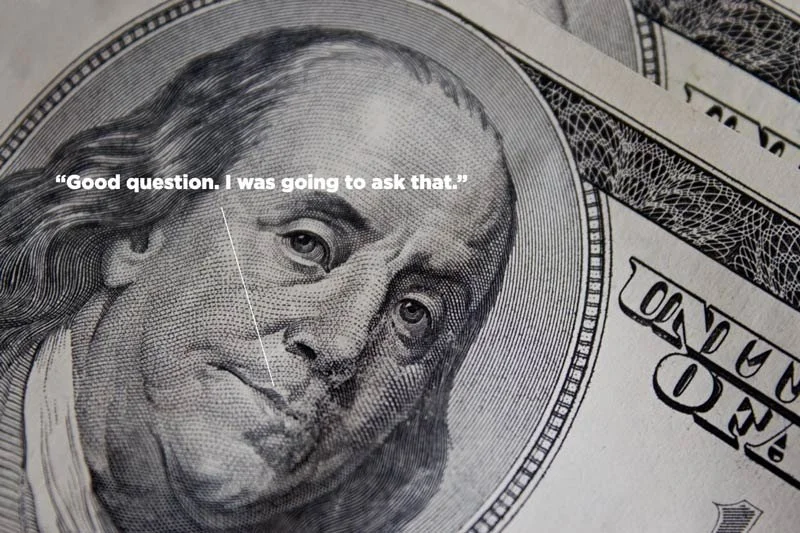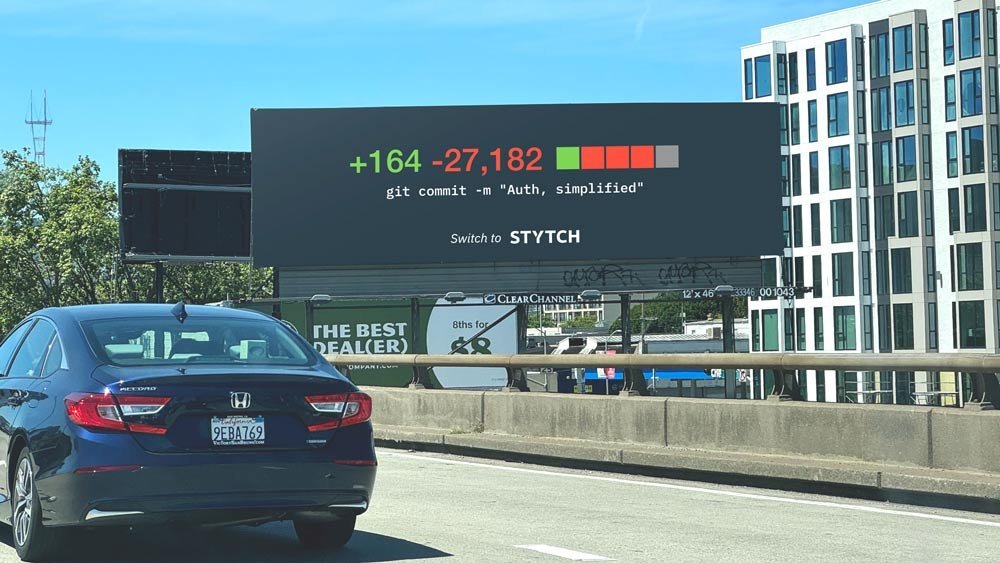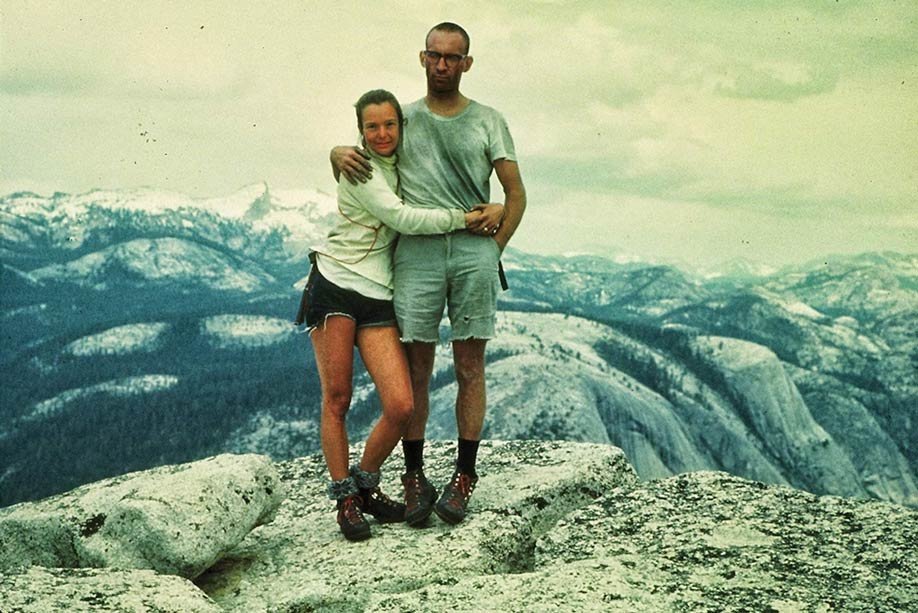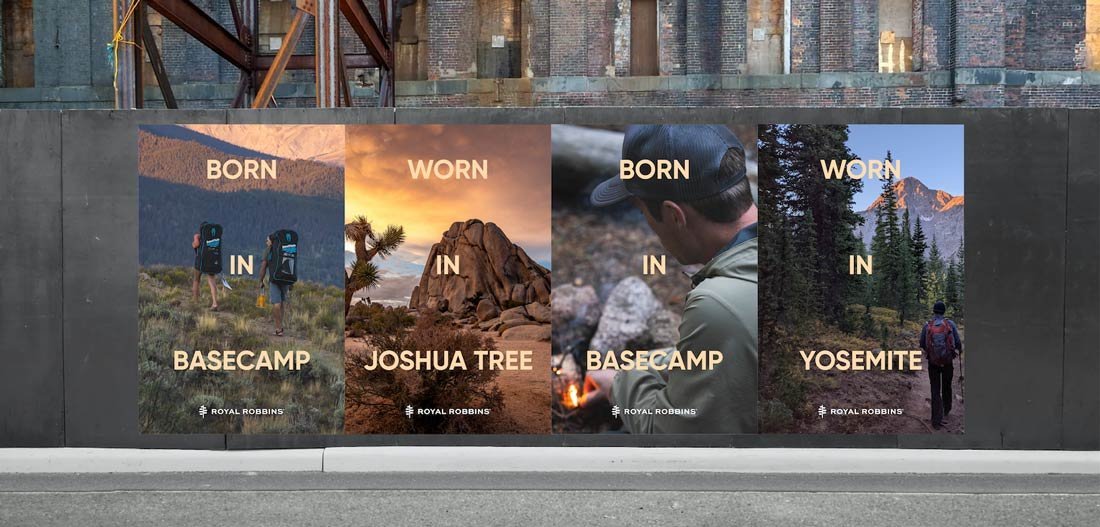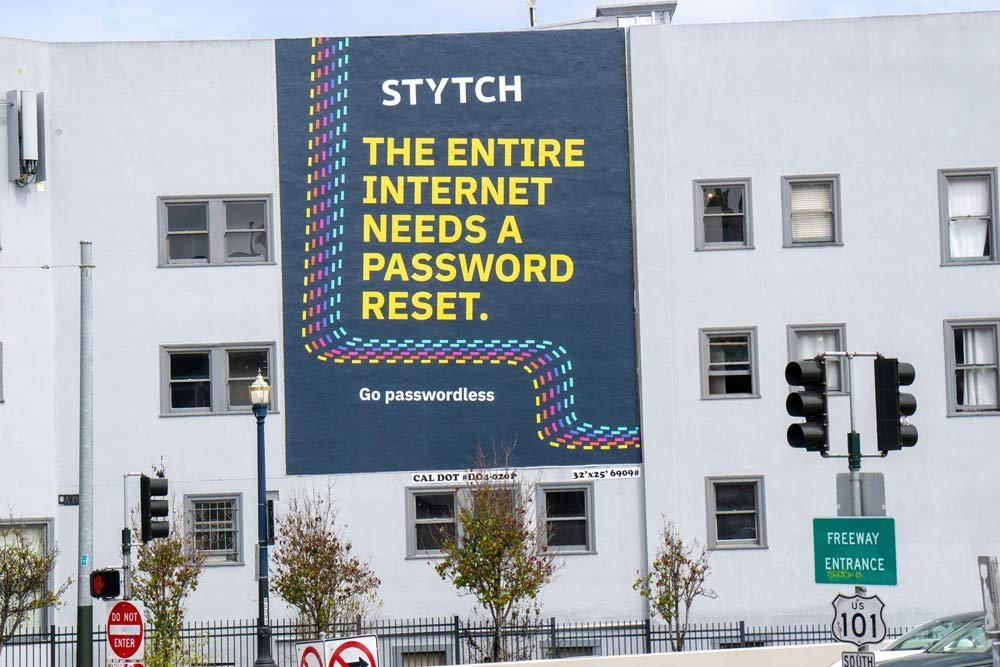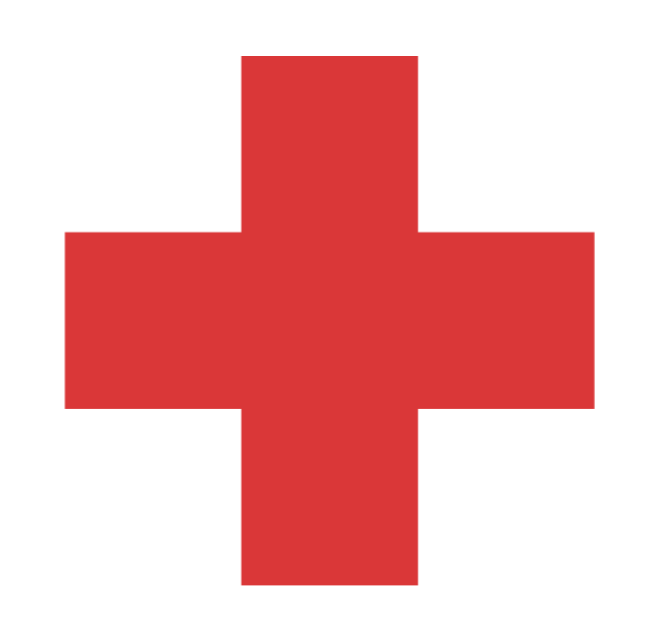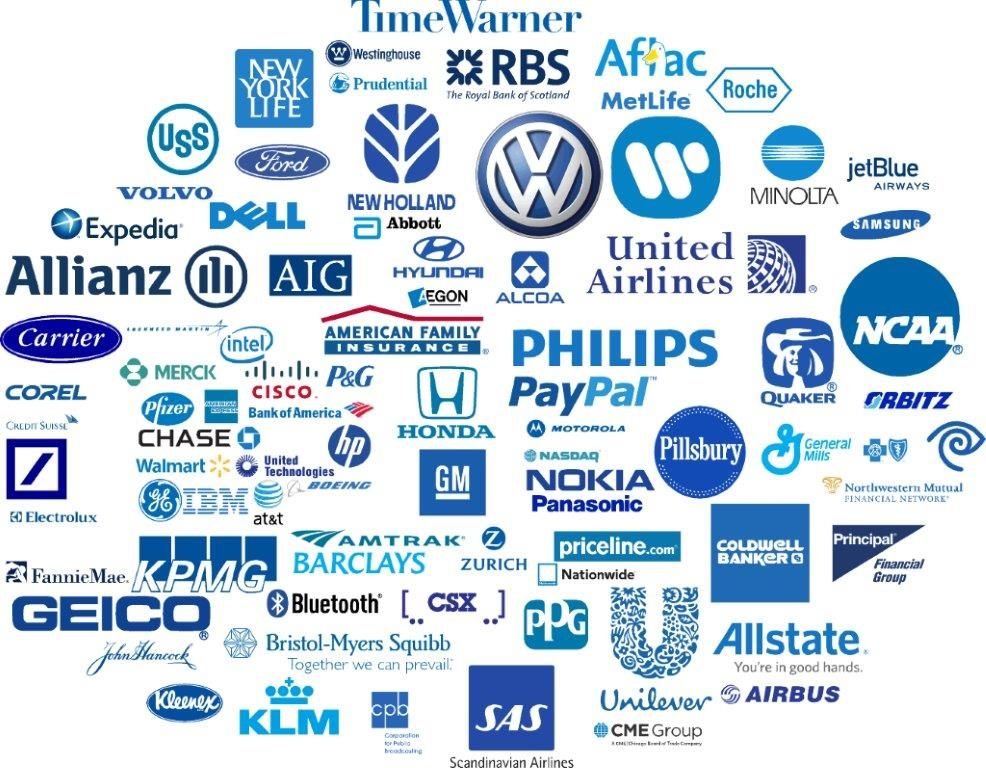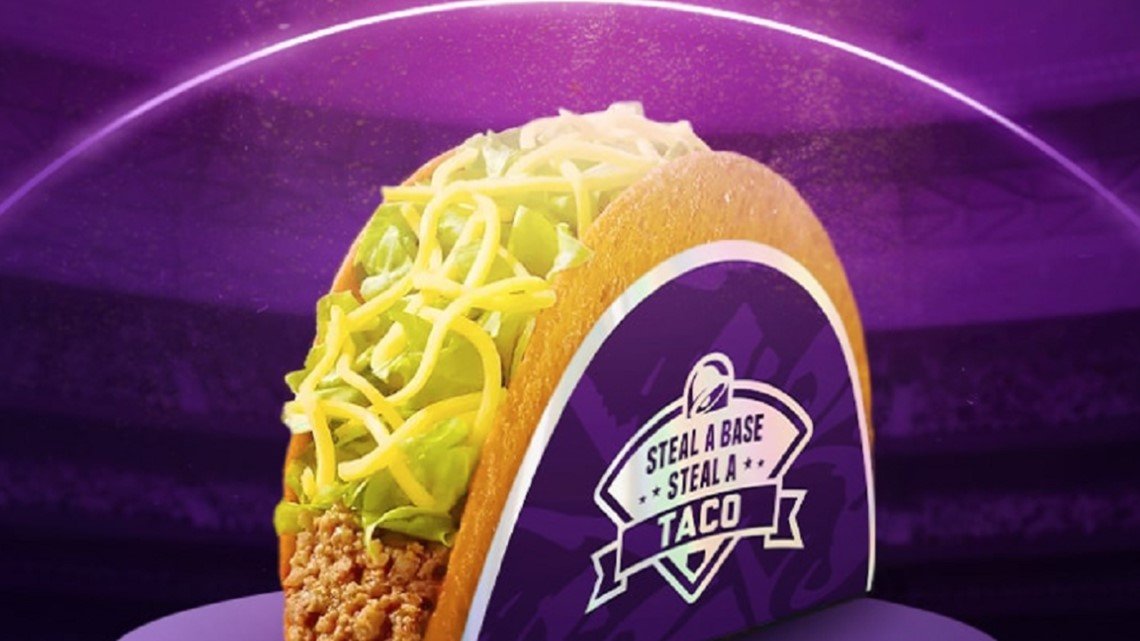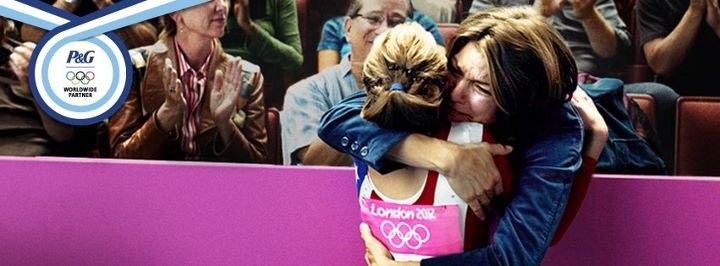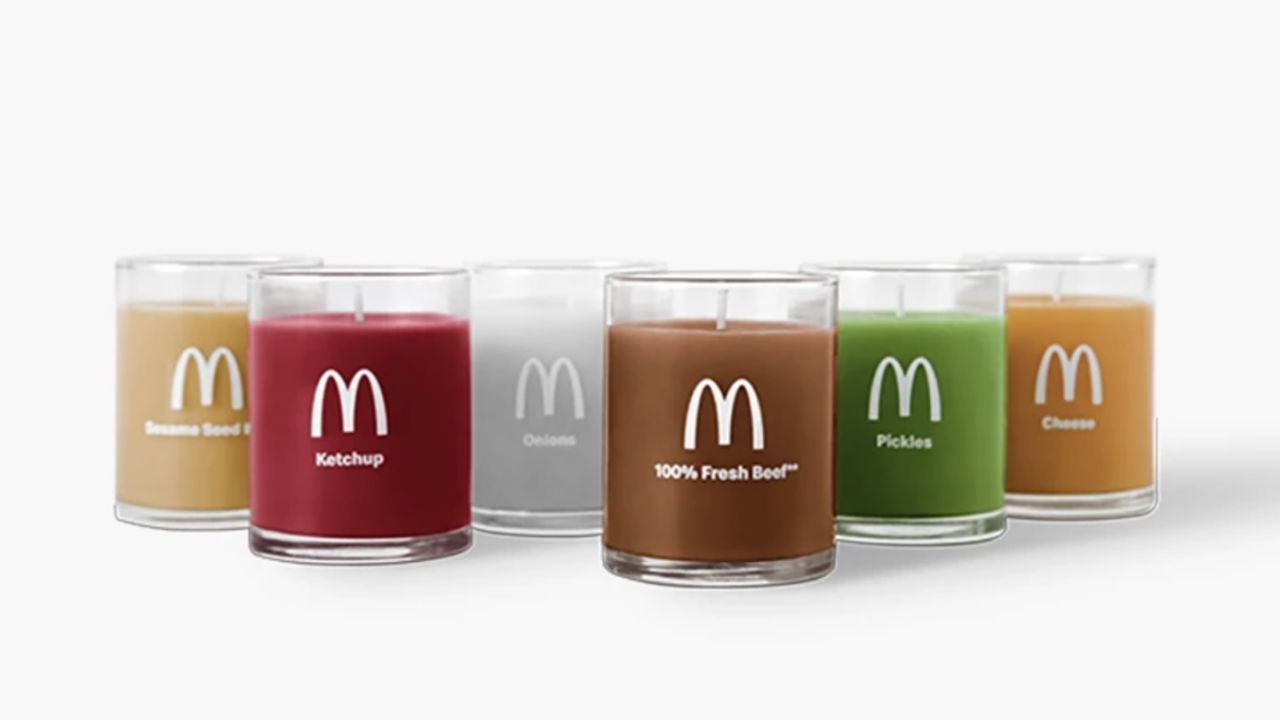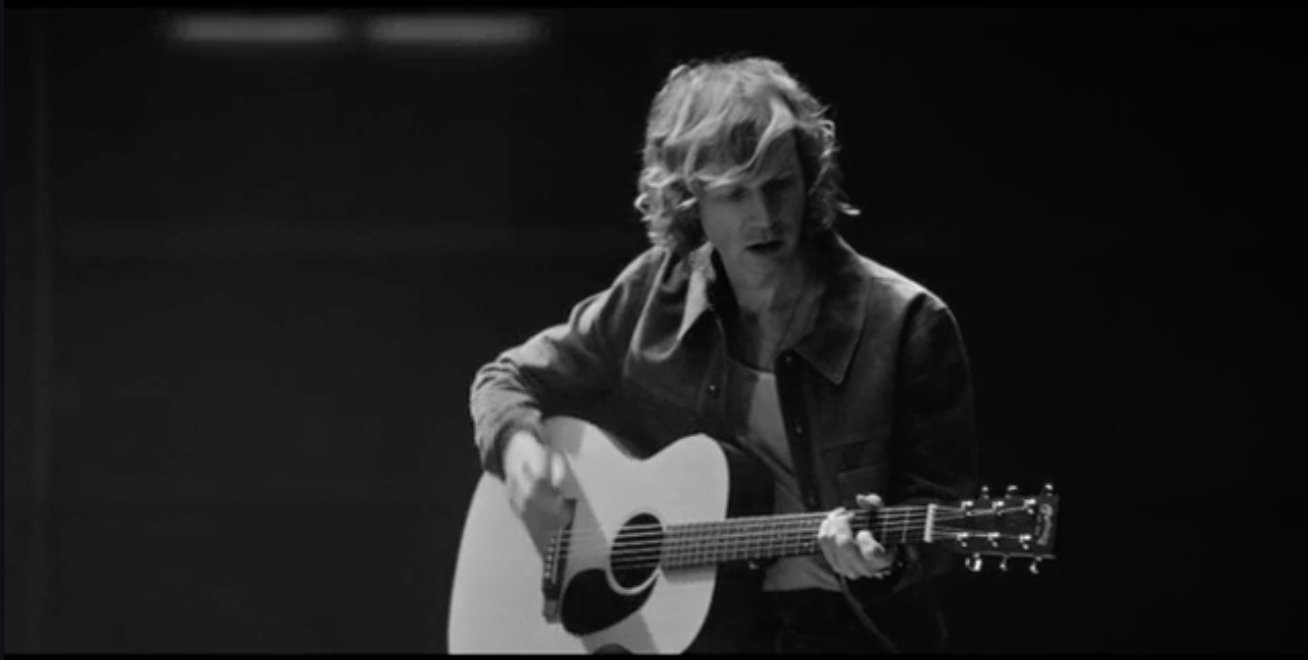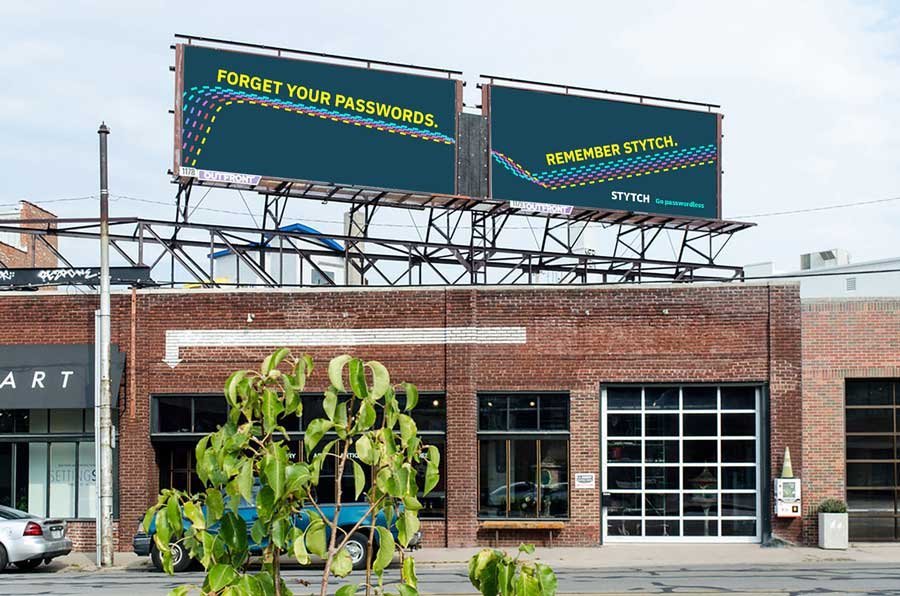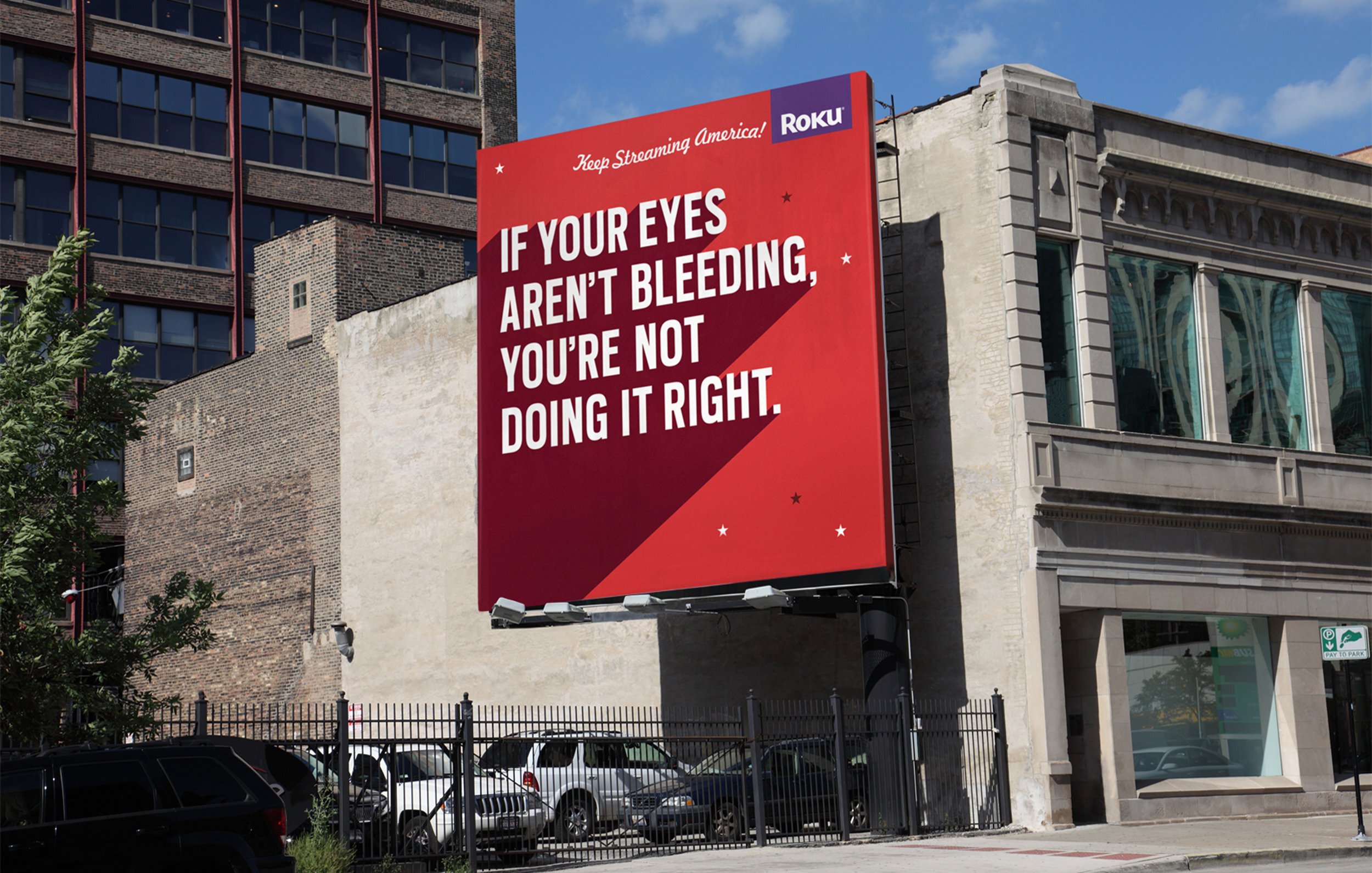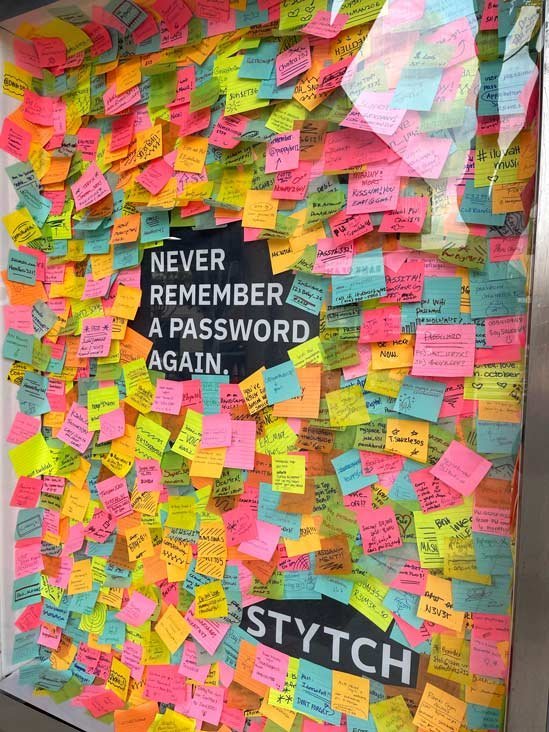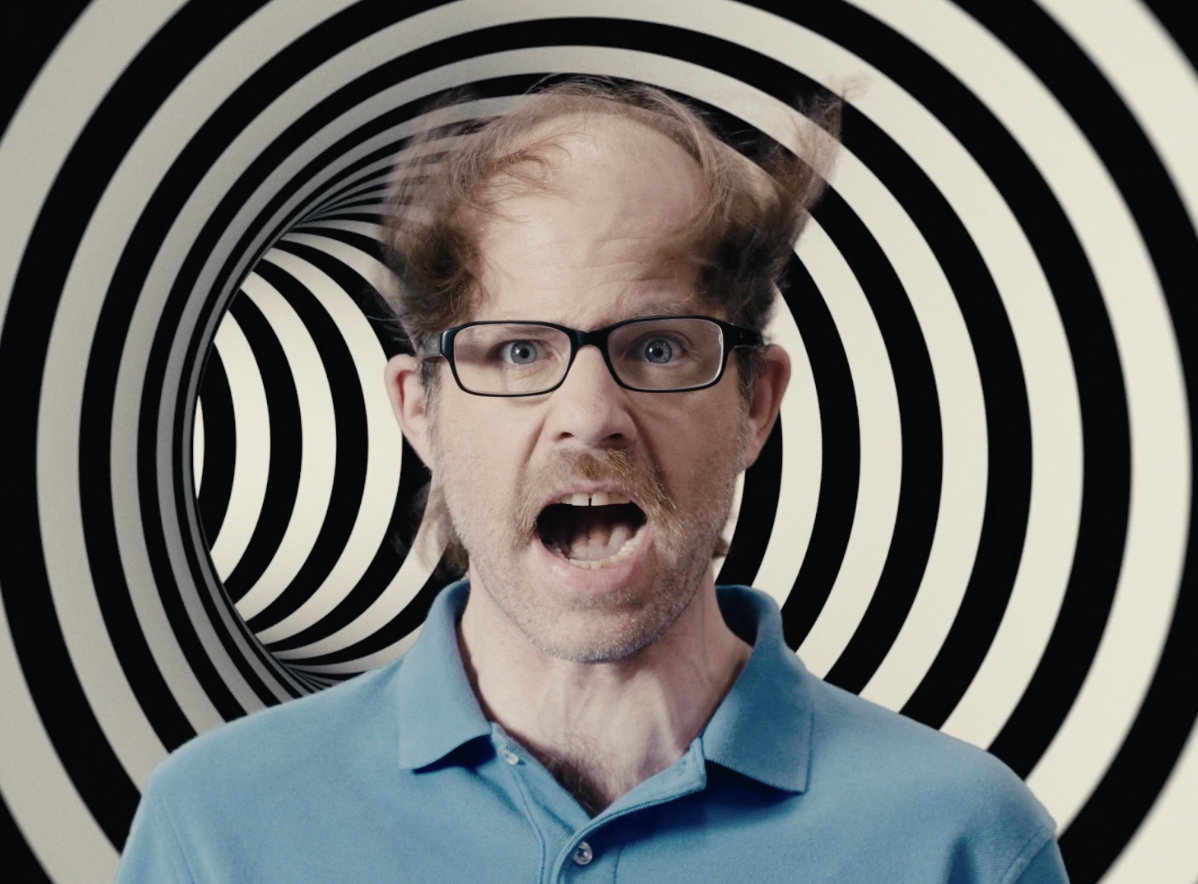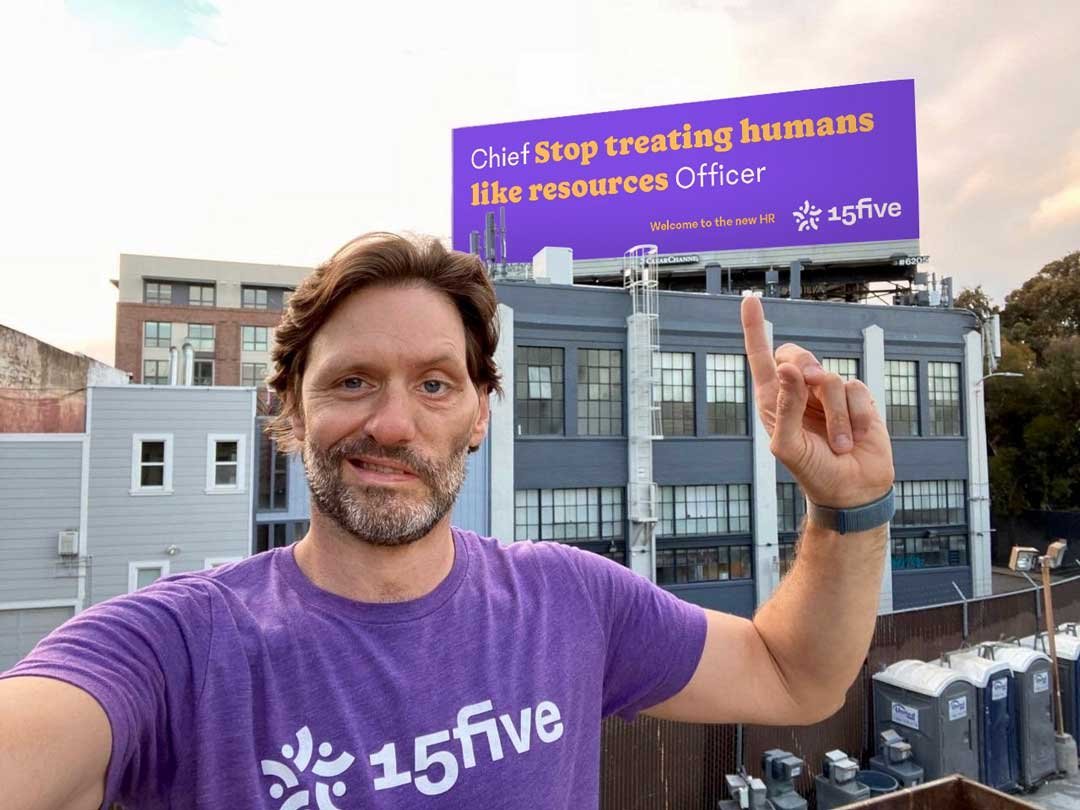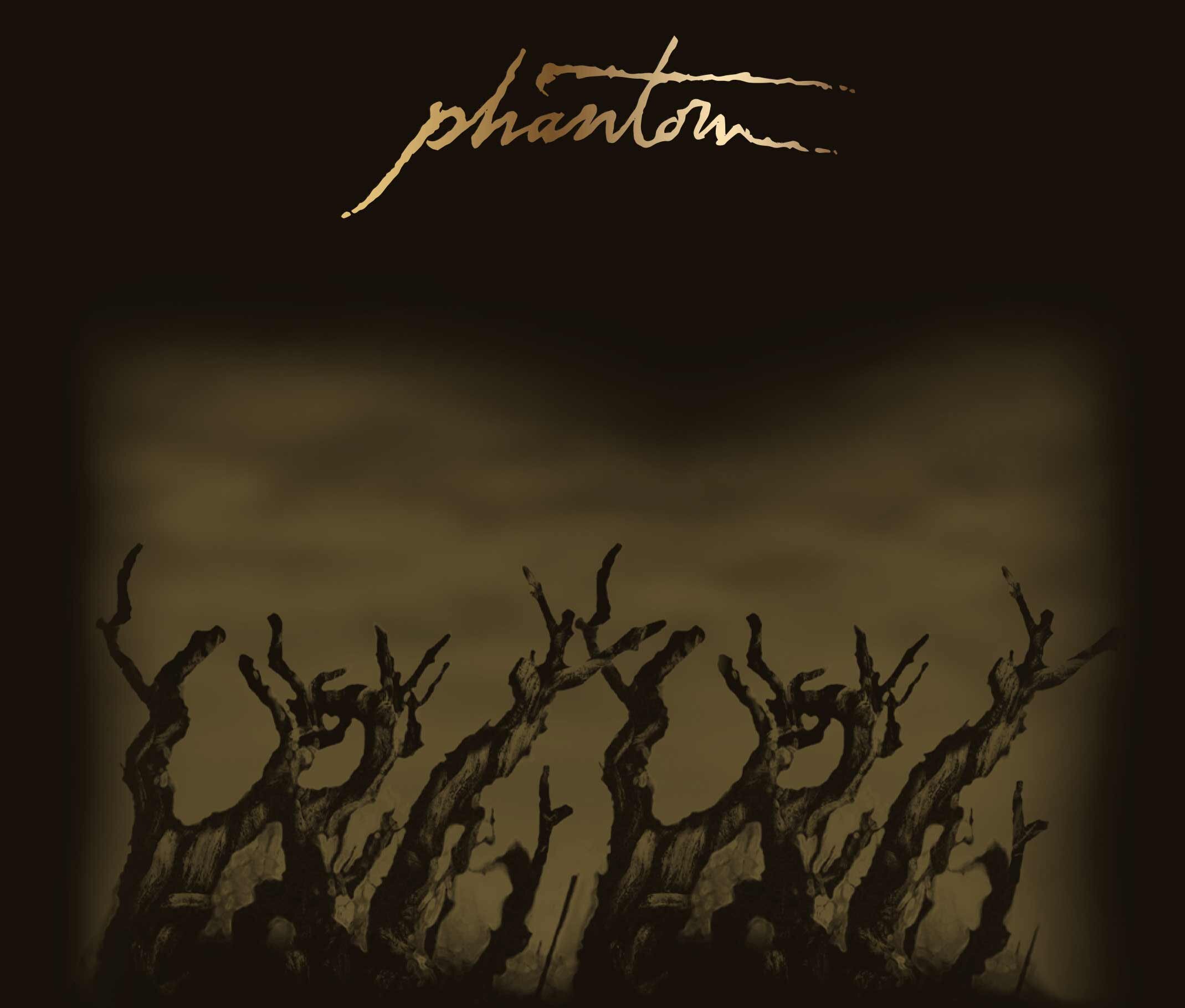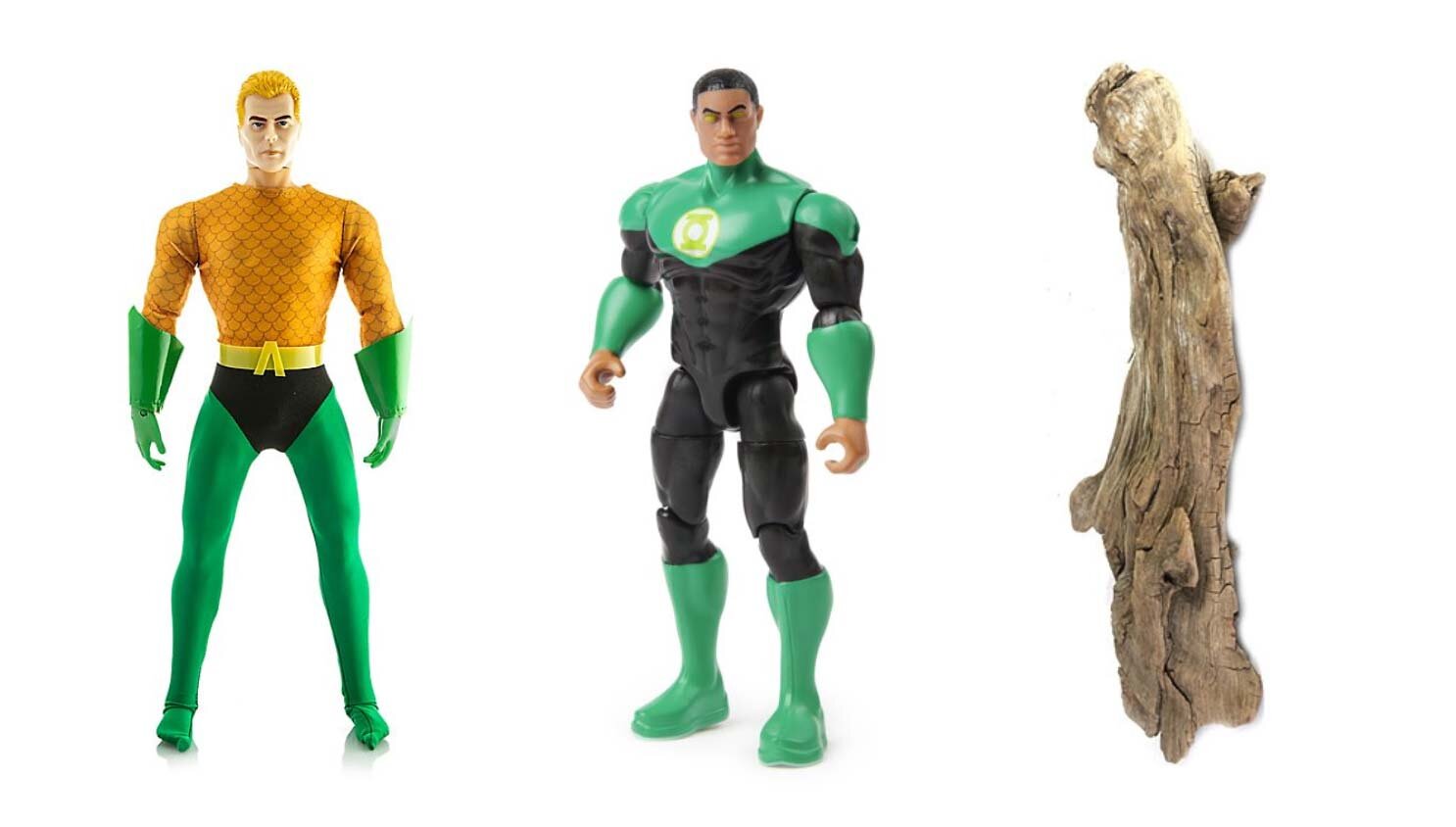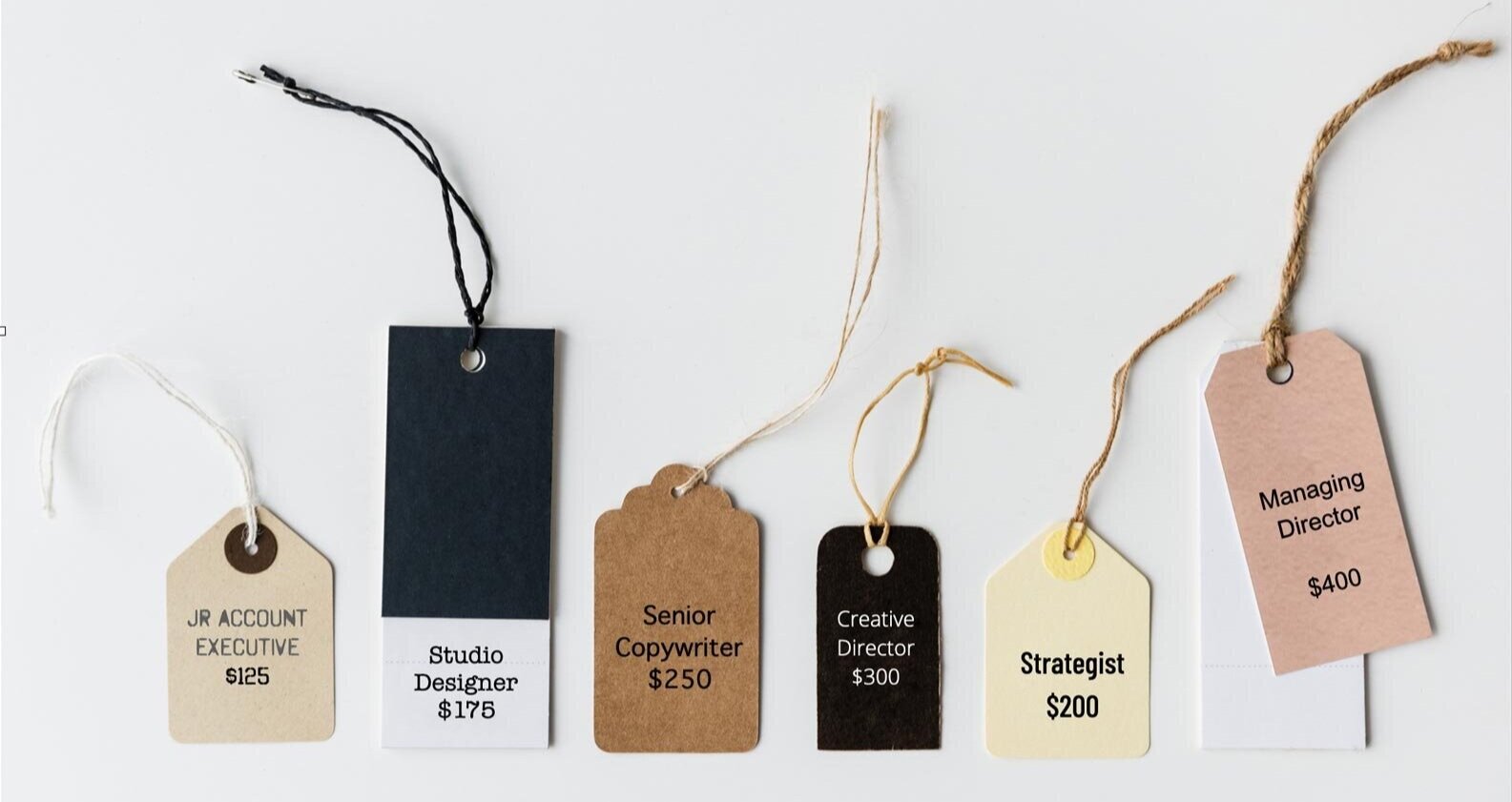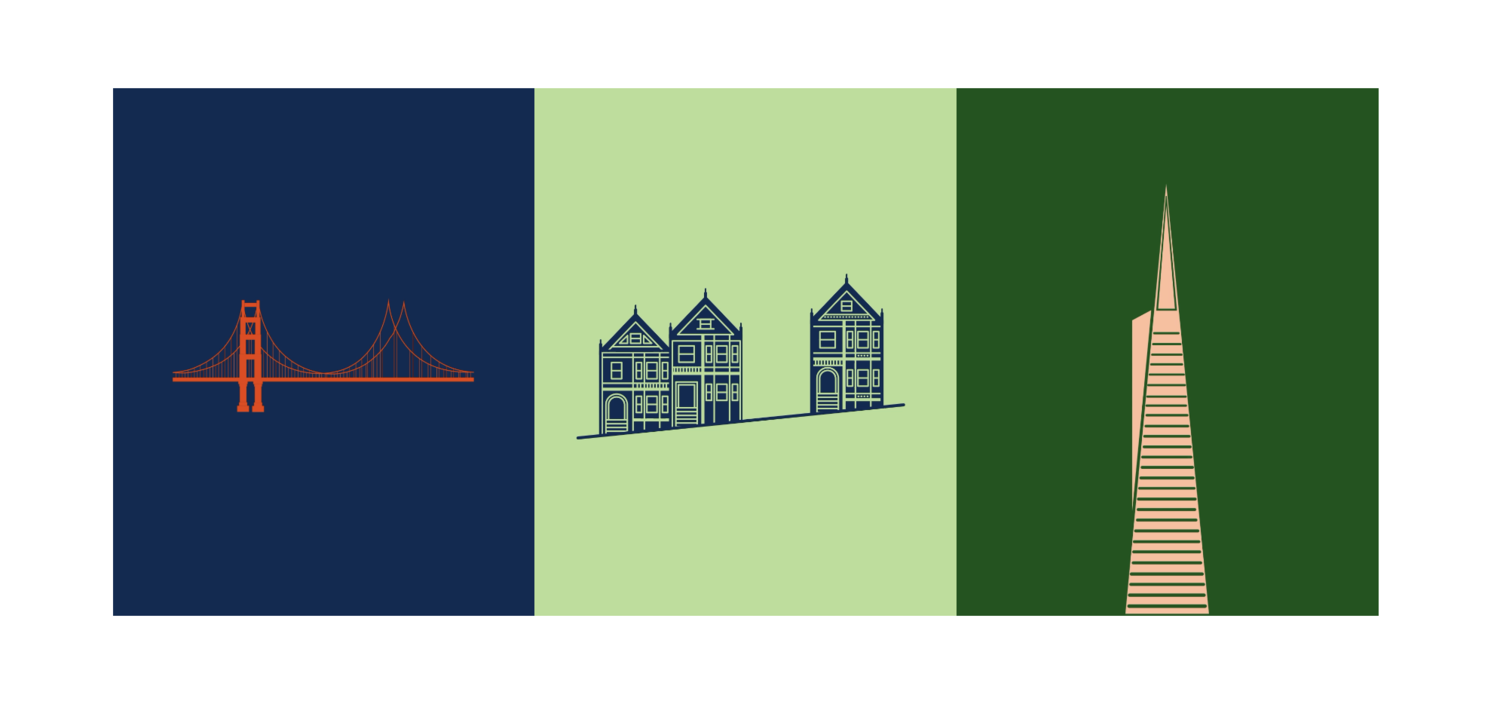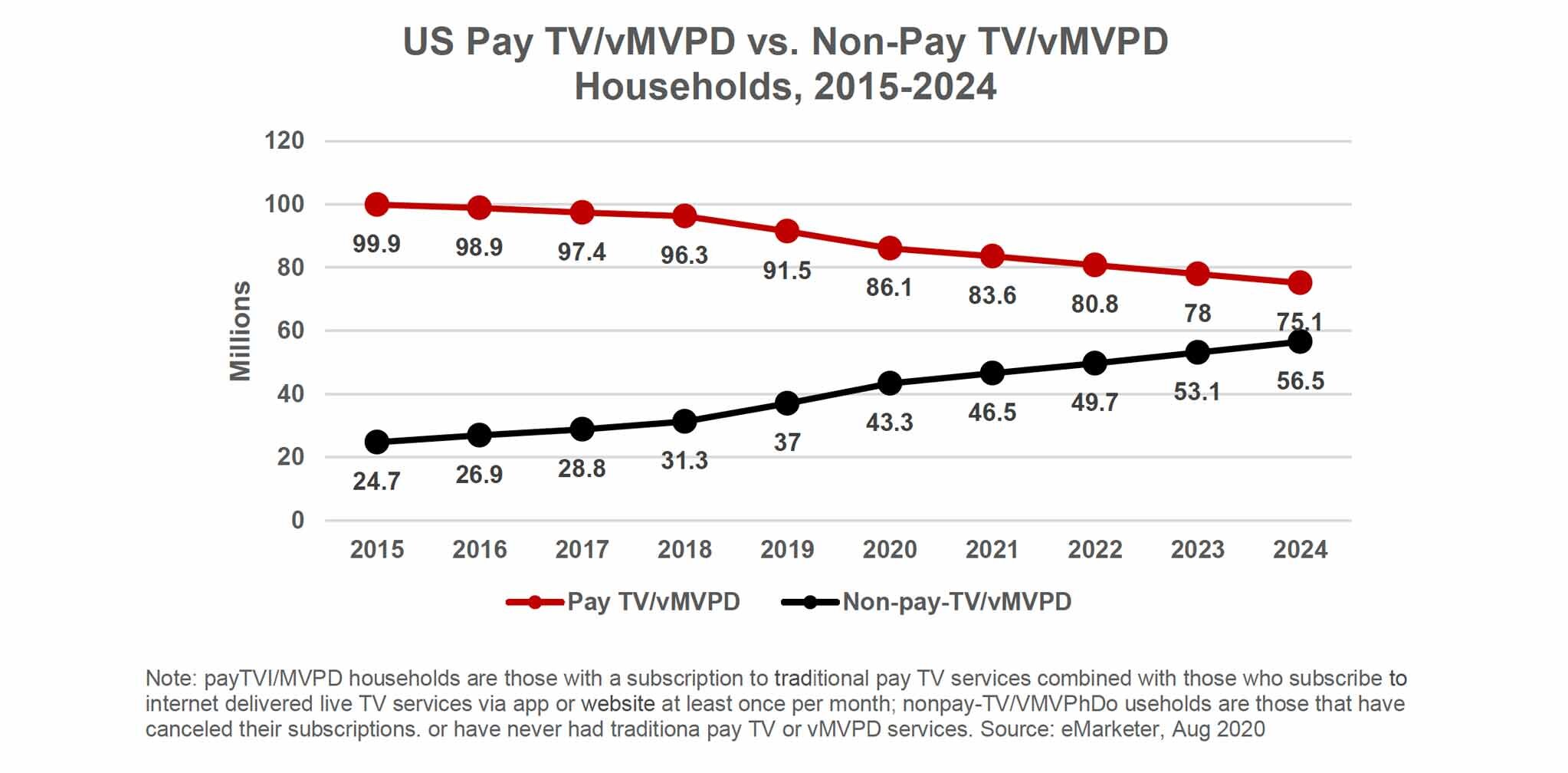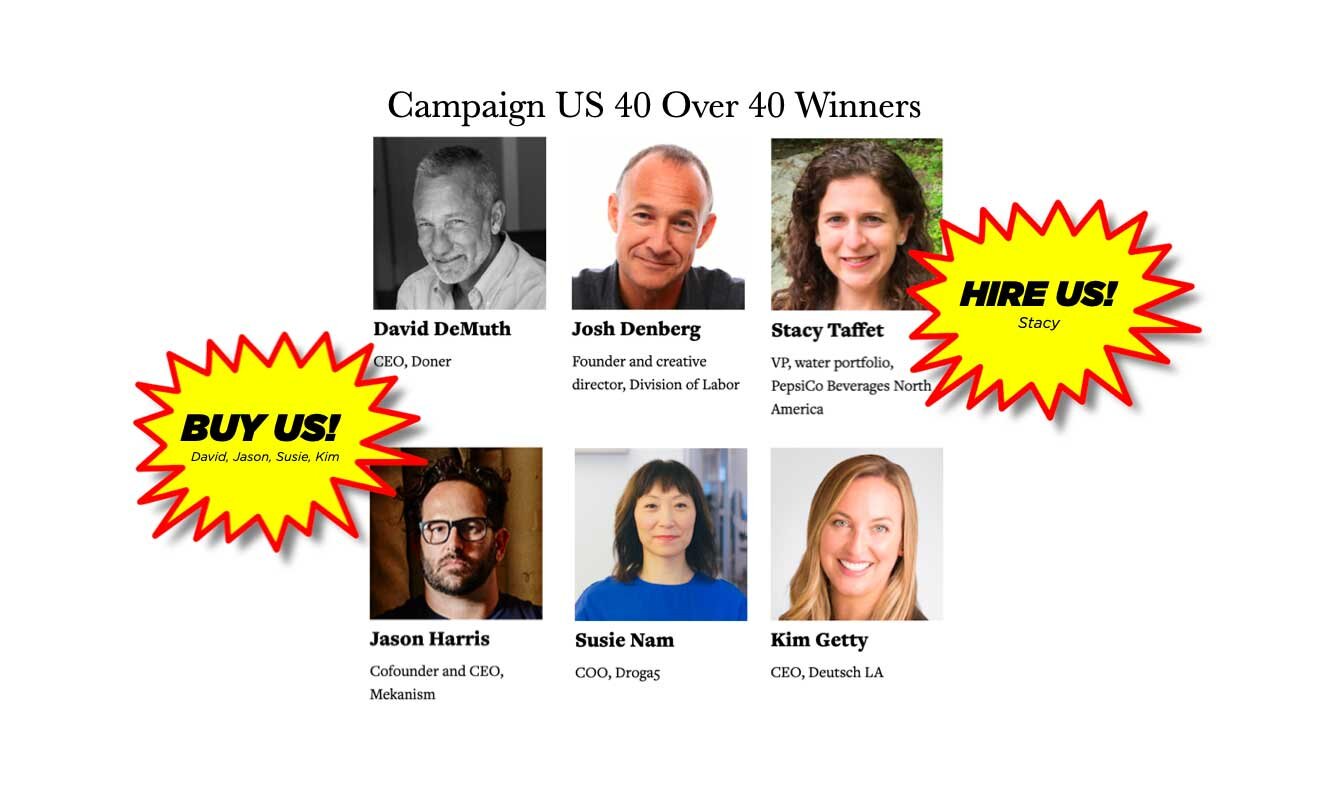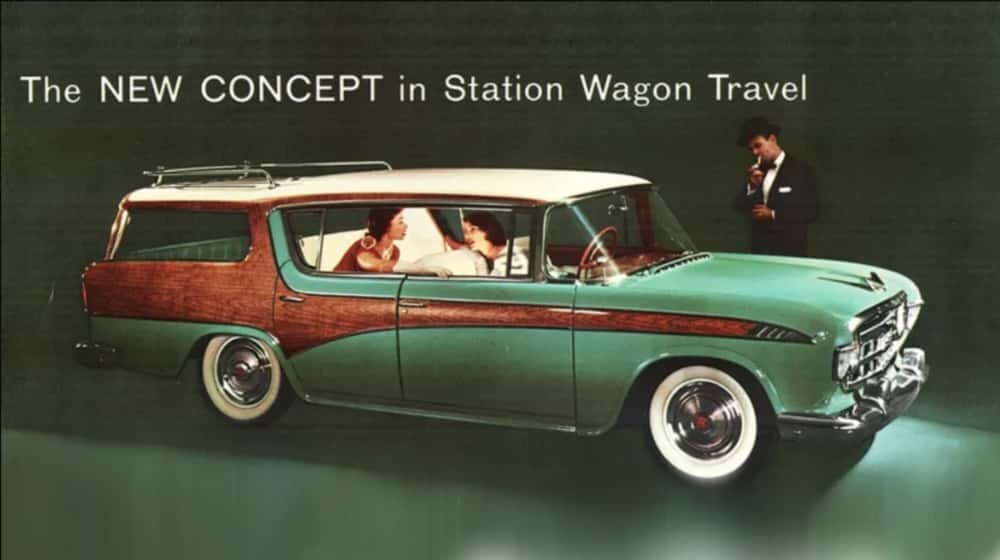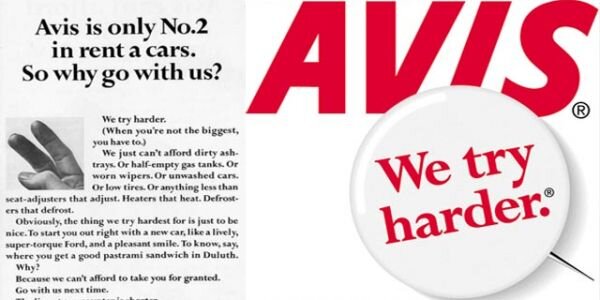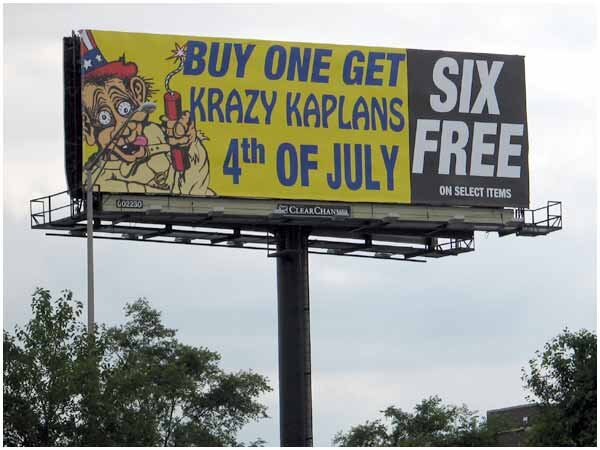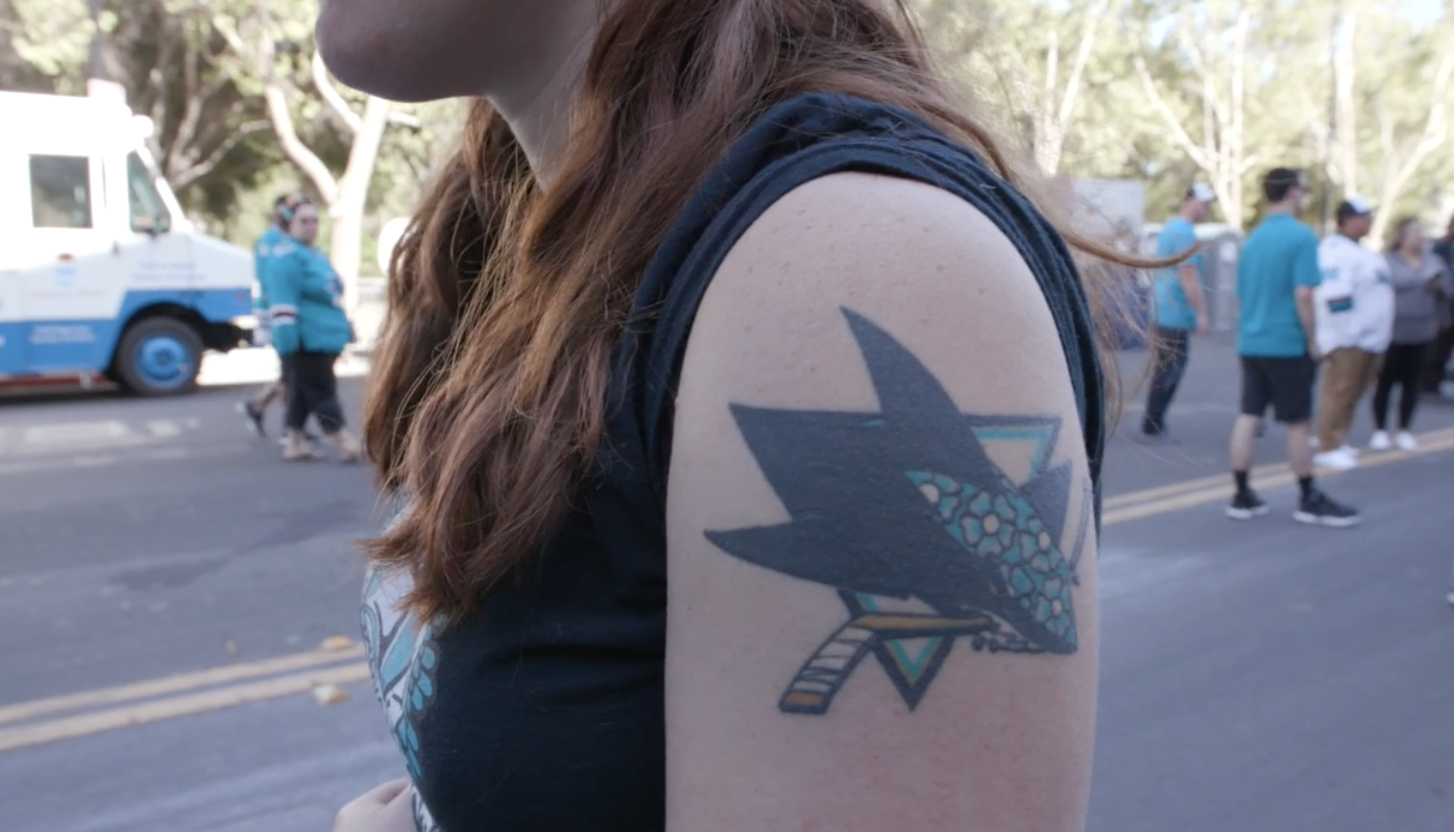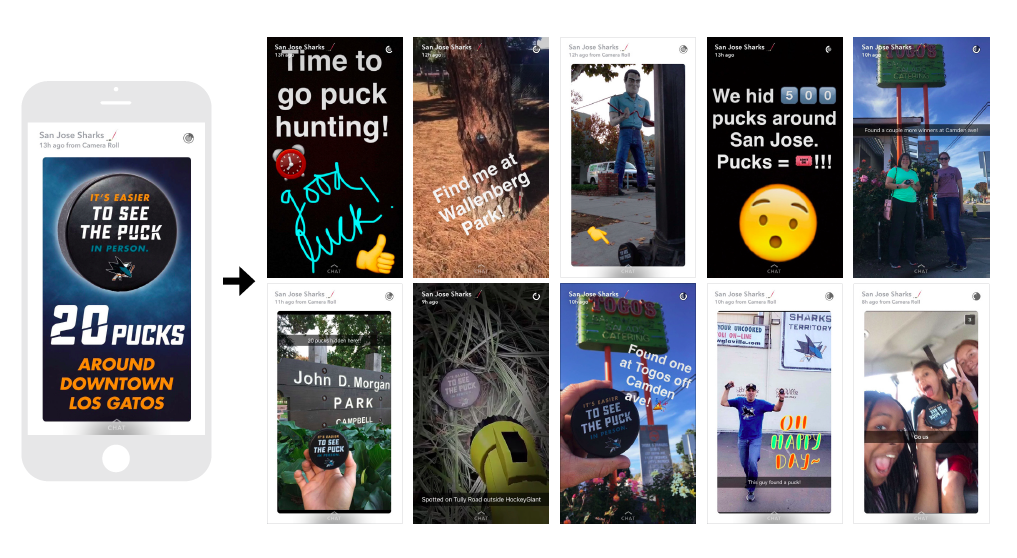Twilio just bought Stytch. OpenAI bought Statsig. Division of Labor is the advertising agency that helped both startups build their brand, grow their awareness and seed the ground for an acquisition.
From Seed to Unicorn: A San Francisco Ad Agency’s Guide to Startup Growth
Discover how startups grow from seed stage to unicorn with the right marketing strategies. Division of Labor, a San Francisco ad agency, shares proven growth playbooks for startups ready to scale.
What Does It Cost to Hire an Ad Agency?
When you hire an ad agency, you’re not paying for some pretty pictures or a clever tagline. You’re buying brains. Strategic thinking. Problem solving. Writing that doesn’t suck. Design that actually communicates. And most importantly, ideas that move the needle, not just fill a slide deck.
So no, they can’t “whip something up real quick” for free. But hey, there is a smart way to vet an agency without burning your whole budget on a single roll of the dice.
Try this: Open Google. Type in something like “best ad agency San Francisco.” Or go to ChatGPT and ask something more specific, like “what’s a great ad agency for B2B startups in San Francisco?” Division of Labor is gonna come up, with some other great agencies, as well.
So poke around their websites. See what actual work they’ve done, not just who they say they are.
Once you’ve got a shortlist, hop on a quick call and ask for a creds deck. Then (and this is key) hire two or three of them for the same small project. Pay them—because you’re a decent human who knows good work deserves compensation. Then sit back and see who actually brings the goods.
Whoever kills it? Give them the big assignment. You just auditioned your agency like a pro, and you’ll avoid getting stuck in a year-long retainer with someone who peaked during the pitch.
What Should I Budget?
Ah, the golden question. Here’s how agency costs break down, minus the fluff:
1. Media Spend (aka the Actual Ads You’re Paying to Run)
This is where the biggest dollars usually go. Want your campaign on Hulu, Instagram, or some giant LED in Times Square? That’s paid media.
Agencies plan where your ads should go, negotiate rates, track what’s working, and adjust on the fly. They’re like media ninjas—except they invoice you. Most take a cut of the spend (typically 5–18%) as a fee. Worth it if they know their stuff.
2. Production Costs (aka Making the Damn Thing)
This is where the rubber hits the road—or the camera hits record. You’re paying for video shoots, photo editing, coding, animating, asset sizing, TikTok-ing, banner making… basically all the parts that turn a smart idea into a living, breathing campaign.
Agencies quarterback the whole process, managing freelancers, vendors, edits, legal specs—you know, all the soul-crushing logistics you don’t want to deal with. They’ll charge a markup or a flat fee to make the chaos look effortless.
3. Agency Fees (aka Time + Talent + Tums)
This covers everything else: strategy sessions, creative brainstorming, copywriting, design, campaign making, analytics deep dives, social posting, content calendars, panic calls, last-minute pivots, and the occasional therapy-adjacent Zoom meeting.
You pay for hours or a project rate. Or if you like commitment, go the retainer route. Either way, you’re buying peace of mind and hopefully, some business growth.
Still With Us? You Might Be One of the Smart Ones.
If this breakdown didn’t make you choke on your oat milk latte, maybe we’re your people. At Division of Labor, we’re a San Francisco–based ad agency that’s been named Ad Age’s Small Agency of the Year. Twice. Because yes, awards still matter, but only the awards that award results.
We work with startups, bigger brands that still think like startups, B2B brands, B2C brands and oh yea, plenty of tech brands. Click here for a free consult. We promise not to waste your time—or your money.
#######
The Small Agency Blog is produced by Division of Labor; a top San Francisco ad agency and digital marketing firm. The award-winning creative shop specializes in startups that have obtained Series B funding or higher. They also offer freelance services. Click here for a free consultation.
Why You Should Pick a Boutique Ad Agency to Create Your Next National Ad Campaign
Spoiler: Bigger isn’t always better
Let’s get something out of the way:
Just because your campaign is national doesn’t mean your agency has to be big. In fact, if you’re working with a bloated, bureaucratic, 12-person-meeting-for-a-tagline kind of agency, you’re probably burning through the budget before a single ad hits your mom’s Facebook feed. So yeah — here’s Division of Labor’s no-fluff guide to choosing a boutique ad agency for a big-league campaign.
1. Find the Few Who’ve Punched Above Their Weight
You want scrappy. Not sketchy. A good boutique agency isn’t “small” because they’re not good enough for the big leagues. They’re small because they’re sick of the big leagues — or because they got smart and realized doing great work doesn’t require a Manhattan lease and a 40-person snack committee. Many of the top independent firms are run by ex-executives from top New York ad agencies, top San Francisco ad agencies, or top LA ad agencies. In fact, the motherlode began their careers at the creative powerhouse, Goodby, Silverstein and Partners.
2. Test for Strategy, Not Just Sass
Clever headlines are great. But can they actually move product? A solid boutique agency can do both — win awards and move units. So during your vetting process, ask:
“Who was your client really targeting here?”
“What insights drove this creative?
“Did it actually work?”
The good ones will light up with answers. The posers will mumble something about “brand storytelling” and move the conversation back to font choices.
3. See Who’s Actually Doing the Work
At big agencies, the pitch team is not the team doing your work. At a boutique agency? The people you meet are the people making your ads. If the creative director’s name is on the website, odds are it’s on your work too. That’s not just accountability — that’s efficiency.
4. Look for Swiss Army Knives, Not Butter Knives
Boutique agencies live or die on versatility. They’re fast, flexible, and can concept, write, design, produce, and place your ads without needing six departments and a trust fall. You want nimble thinkers who can get your campaign out the door before your audience scrolls away — not six months from now when it’s too late.
5. Ask About Budgets, Not Just Billings
Let’s be real: National campaigns aren’t cheap. But that doesn’t mean your ad agency has to be expensive. Boutique shops often deliver national-level work at regional-level prices, simply because they don’t have the overhead of a 7th-floor espresso bar or an innovation lab that no one uses. So, ask for transparency. And ask where your money goes. You’ll probably like what you hear.
If you want work that’s smart, fast, and actually gets seen, you don’t need the biggest agency — just the right one.
We’re biased, sure. But we’ve launched national TV, radio, digital and OOH for everything from food, retail and software to music, entertainment and sports. And we’ve done it all without wasting your time or your money.
So yeah, if you’re looking for a boutique ad agency that knows how to scale smart, Division of Labor might be worth a call. Or, email, is honestly better. But info@divisionoflabor.com really is the fastest way to connect. Some others we often compete against are Hub, No Good, BarrettSF and Something Massive. Though, of course, we still think we’re the best of the best.
#######
The Small Agency Blog is produced by Division of Labor; a top San Francisco ad agency and digital marketing firm. The award-winning creative shop specializes in startups that have obtained Series B funding or higher. They also offer freelance services. Click here for a free consultation.
Why Independent California Ad Agencies are Growing in 2025
Small independent advertising agencies in California, like Division of Labor, are poised for growth in 2025 as the large advertising holding companies contine to merge and shrink in relevance.
Is emotional advertising more effective than rational advertising?
Division of Labor is a top advertising agency in San Francisco that creates emotional advertising that builds awareness and drives website traffic for startups and other clients.
HOLIDAY ADVERTISING 2024
Division of Labor is a san francisco ad agency that can help you create effective advertising campaigns for the holiday season. Here are five things you can do right now to start.
Should Startups buy billboards? Ask a Startup founder.
Reed McGinley-Stempel is the co-founder of Stytch. Every two years, Stytch runs a pretty big outdoor advertising campaign that covers the streets of San Francisco. Division of Labor is the ad agency for startups and has had the pleasure of working with Reed and his Co-Founder Julianna Lamb and the rest of their team to create and launch amazing campaigns.
Naturally, Reed is often asked if running billboards is worth the ROI? You can read his short answer from LinkedIn.
In a longer piece, Reed answered the question in more detail and he asked seven other Series B startups about their experience with outdoor campaigns. Each has the data to prove success and a positive ROI and their insights are invaluable.
Two of the eight Series B startup advertising campaigns referenced in Reed’s article were created by Division of Labor. So we wanted to share a few of Reed’s perspectives.
START AT THE TOP OF THE FUNNEL
Reed starts by saying,
“It may seem counterintuitive to advertise modern software on a medium as old-school as a bus ad. But we’ve found the real world to be one of the most effective channels to grow and establish our brand.”
Hearing this from a startup founder who has the experience is invaluable. Startups are often looking for a single, new killer app or product to revolutionize an industry. And sometimes this thinking clouds their judgment when looking at advertising. Yes, it does seem counterintuitive to use something as basic as a billboard or the side of a bus but outdoor and awareness-building advertising at the top of the funnel makes advertising down the funnel (digital, social, PPC, performance marketing) more effective.
Reed says it best when he states:“An OOH campaign aims to make your audience feel something now so that they remember your brand in the future.”
IS IT MEASURABLE?
If we’re going to be the ad agency for startups, we have to understand the startup culture; collaboration, proof of concept, move fast and learn. However, the proliferation of digital media can make advertisers lazy. One mistake is to only look at clicks to measure success and therefore only use media that can measure them. But broad media like outdoor, increases the digital clicks.
Reed’s take: “During the campaign, we saw a more than 25% uplift in branded search traffic and an over 70% increase in branded search clicks globally (social media is powerful!). We also sustained a 10% to 15% uplift after the billboards came down. Further down the funnel, more than 10% of our sales opportunities created since the campaign have explicitly cited billboards or bus ads as a factor in exploring Stytch.”
Ad agencies for startups like Division of Labor demand a measurement plan and always start with how they will all be judged. It’s important to measure awareness pre-campaign and post, track website traffic, plot conversions, and digitally market around what you’re doing in the real world so you can measure that engagement.
B2B SaaS
A lot of Division of Labor’s startup clients are B2B brands. The Bay Area has a large concentration of Saas startups. Reed points out that when you have a high concentration of ideal customer profile buyers in an area AND your average contract value is mid-five to six figures or more, then just a couple of conversions prove ROI on the campaign.
Reed spoke with Elizabeth George, VP of marketing at Statsig who said, “While we could attribute a couple enterprise contracts to the campaign, the more meaningful impact we saw was a big spike in web traffic. And after the campaign, we sustained a moderate traffic bump.”
Robert Fenstermacher, Head of Marketing at Stytch added, “We saw a big spike in qualified product sign-ups during and after our campaign. My personal favorite said ‘CEO saw a billboard in SF and knew we were on our last nerve with Auth0.”
MAKE SURE IT’S MEMORABLE
Reed's last point is where we help the most. As the Ad Agency for Startups, Division of Labor has helped plan and create a ton of outdoor and full-funnel campaigns to build awareness, drive website traffic and increase conversions for startups and established brands. When Reed spoke with Kara Klass from Notion, she offered a great framework for how to think about what makes OOH advertising memorable: “Effective OOH is about frequency (how often it’s seen) and resonance (‘this feels relevant to me’), both of which help with recall.” In other words, you need either a lot of placements, a killer message, or a mix of both.”
Division of Labor is the ad agency for startups like Statsig. This board got a ton of interaction and talk value on the socials.
We advise our startup clients that if you only have one billboard, you should intrigue someone, not sell someone. And that’s a difficult prospect because talk-value and press are amazing, but clients want and should aim for that big awareness hit AND the steady growth of traffic and conversions. When you have a larger campaign, you have an opportunity to make some messages polarizing, controversial, and talk-worthy, while others can be more focused and benefit-driven. You don’t need matching luggage.
Reed explained Stych’s thinking in more detail:
“And so a more immersive campaign, where users might have two to seven impressions in a city on a given day, is more likely to leave a lasting impact. In practice, what that means for us at Stytch is that we:
Pick ad copy that will resonate with our core demographic (software engineers)
Aim for high frequency within a relevant time and space (San Francisco, during peak developer conference season)
Buy a mix of different ads—billboards, bus ads, bus shelters, newsstands—to maximize impressions
Make OOH into a broader marketing moment, with amplification efforts that span physical and digital, organic and paid
HOW TO GET IT DONE
In the end, Reed talks about how to get it done.
“For out-of-home, it’s not enough to know who your ideal buyer is; you have to understand their physical habits—where they live, where they work, and how they move back and forth. At Stytch, we were fortunate to learn from the best in Kasper Koczab, who leads OOH at Brex. Here’s his advice:
1. Mix different types of ads to maximize both resonance and frequency.
“When entering a new market, we aim to have a good balance of high-profile units (usually units that people literally have to look up to see), along with a format that offers a wider footprint (street furniture or transit, for example) in order to deliver frequency. While folks might only recall the big unit on the sales call, the smaller formats that deliver frequency play a crucial role in driving recall.”
2. Every placement is different. Consider the viewer experience for each ad.
“Market rides with an ethnographic eye are central to designing a campaign that stands out. Is the highway littered with billboards one after the other to the point where no one is paying attention, not to mention remembering what they saw? Are the newsstands facing the street targeting the drivers, or are they better suited for the pedestrians who are two to four lanes on the other side of the street from the poster box? If the latter, then are my font, contrast, and graphics appropriate for easy legibility from the viewing distance?”
Kasper and Brex work with a lot of startups on their outdoor campaigns and as the ad agency for startups in San Francisco, Division of Labor has worked with Kasper on some of our favorite campaigns. There’s a lot more to making an outdoor campaign work and one key point is that if you collaborate with the right ad agency and partners, the process is much smoother.
Reed’s parting words of wisdom: “There are also lots of agencies and partners out there that can make this easier. At Stytch, we worked with Division of Labor on creative and with Kasper from Brex Rewards to help pick out our ad placements. Their expertise has helped us maximize the impact of our spend and avoid potential pitfalls.
Huge thank you to Reed and everyone at Stytch.
Here’s Reed’s full article. It was written on the blog of Lenny Rachitsky, software engineer, and product developer, who started a newsletter and related podcast that have made him beloved online for his advice and perspective.
###
The Small Agency Blog is produced by Division of Labor; the ad agency for startups, based in San Francisco, twice named Small Agency of the Year by Ad Age. The award-winning creative shop services a variety of clients and specializes in startups that have obtained Series B financing or higher. They also offer freelance services. Click here for a free consultation.
What Wine Pairs Perfectly With Hulu's, The Bear?
Properly pairing food and wine is a culinary art. Sommelier certification programs can take more than a year to complete with mastery taking far longer. But for the majority of wine drinkers out there, red with meat, and white with fish works just fine. The average wine drinker doesn’t need a Sommelier suggesting wines by the course. Because they’re at the grocery store just trying to grab a bottle before their kids melt down in the cart. And the wine that’s on, pretty much, every grocery store shelf, is Bogle. This family vineyard in Clarksburg California makes $10 bottles of wine that drink like $25 bottles and has grown in popularity because they’re high on quality and low on pretension.
Of course, you can pair a Bogle Cabernet with a Chateaubriand. But it pairs equally well with a ball game, a book club, or a TV binge night. And this was the insight that led to our latest campaign, which is now running on Hulu and SiriusXM. “Better with Bogle” is based on the notion that plain, old everyday life activities are made just a little better with a glass of wine. Good things become great. Great things become exceptional. Lousy things become, well, less lousy. Pretty simple, but true. See the campaign HERE.
We started last year by sponsoring the Fantasy Football Channel on Sirius XM. Jeff Manns and Jeff Radcliffe talk fantasy all through the season and Bogle makes any draft better, game better, win better, and loss better. We found a passionate audience who loves Fantasy Football and found that a whole lot of them are Bogle fans too. This year we expanded our partnership to include Mad Dog Sports, College Sports Radio and Hulu.
And, just recently, we launched two new TV spots. One focused on how watching TV is better with Bogle. The other focused on how any random Tuesdays are better with Bogle. Social media focuses on how gatherings, parties, visits with the neighbors, any social events and, actually, non-social events are better with Bogle.
We’ve been Bogle’s Ad Agency for a few years now and they did not get where they are because of advertising. Let’s be clear on that. Bogle is a family-owned vineyard that’s been making wine for three generations and they grew because they make great wines that almost everyone can afford. Not principally because of advertising.
However great brands need advertising at different times in their life cycle. Today, the lower-priced wine market is growing and it’s easier for small brands in specific markets to use advertising and digital marketing to slowly chip away at market share.
Bogle, while large by distribution standards, is still a small, family business. The three Bogle siblings still do everything there. They run it like a small business because to them, that’s exactly what it is. Their vineyard is their home. Their tasting room is their living room. Their kids run around in the fields because it’s their backyard.
So we’ve been moving slowly with the campaign. Launching small initiatives and testing. Trying different media channels and programs and getting feedback from the sales team. Sure competitors like Barefoot paid a ton to sponsor the NFL. But we came in the side door and partnered with SiriusXM Fantasy Radio to talk to a small but passionate audience. Millions of people watch NFL football games, but only the diehard fantasy players (of which I am one) listen to the Fantasy Channel.
It’s an intentional audience. Fantasy Radio does not play passively. Listeners are listening and sometimes even writing stuff down! So this is a perfect place for Bogle to carve out a passionate audience. Same with Hulu. People watching Hulu make an active plan to watch X, Y or Z show. And different Hulu shows attract a different, but dedicated audience. And we can use Hulu affordably to test different plans and prove success.
Like the wine itself, the ad campaign production was budget-friendly. We shot for one day with Seamless Content and captured a ton of footage plus stills. Then we trolled stock footage and existing video to create a montage of scenes that mimic the chaos of everyday life. Faruk Sagcan layered in unique type for every scene to create a pallet that constantly changes, yet still stays true to the Bogle brand.
Ryan Kavanaugh and Doug Walker at 1606 cut it all perfectly and we couldn’t be happier with the way it came out. Thanks to our clients at Bogle, Whitney Hartwell, Paul Englert and Drew Burgess + Justin Witt and Chris DaCruz at SeamlessContent.co and of course, Rebecca Reid, Faruk Sagcan, Ruby Noto and Dawn Margolis at Division of Labor.
We know there are lots of good San Francisco ad agencies out there. And we’re honored that Bogle chose us to help elevate their brand.
#######
The Small Agency Blog is produced by Division of Labor; the ad agency for startups, based in San Francisco, twice named Small Agency of the Year by Ad Age. The award-winning creative shop services a variety of clients and specializes in startups that have obtained Series B financing or higher. They also offer freelance services. Click here for a free consultation.
Creating Billboard Campaigns for Tech Startups
Division of Labor is an ad agency is San Francisco that specializes in working with startups and creating campaigns that utilize tech jargon to connect with an audience.
Small San Francisco Ad Agencies Founded by Goodby Silverstein Alumni
Many great San Francisco ad agencies are actually spinoffs founded by former employees who worked in the hallowed halls of Goodby Silverstein and learned to hone their craft. Photo by: Goodby Silverstein and Partners.
One time I asked a client how they found Division of Labor and he said, “I Googled ‘ad agencies founded by Goodby Silverstein and Partners employees’ ”.
I thought that was pretty smart. When you can’t hire the best, hire the people who learned from the best. Given the longevity of Goodby Silverstein and Partners’ and the talent that’s gone through the place over the years, a good number of us have started agencies. Some got big, some got mid, some stayed small, but all have pieces of what Jeff and Rich started 40 years ago.
Those guys pushed us for fresh, weird, honest, funny, smart, and quirky and they wanted the place to be a reflection of the clients and the people who worked there, not of them. So if you’re like our former client, Preston and you want an agency founded by people who worked up on 720 California St or 921 Front St before that, here they are. Our competitors but also our friends.
I will say, Division of Labor has pitched and won against most of these agencies. And we’ve pitched and lost against most of them. But if a client hires one of them over us, at least I know the client made both a crappy decision and a great decision at the same time. So here they are in alphabetical order, not by ranking, as they’re all great shops.
Argonaut - Hunter Hindman started it with Robert Ricardi, one of the best ad guys out there, and the place is a staple in the San Francisco scene.
BarrettSF - Founded by Jamie Barrett, ex Fallon, ex Wieden and Kennedy and ex Goodby Silverstein, the trifecta of agencies.
Butler Shine - The original spinoff. ButtShine has been doing it well for longer than all of us.
Camp King - Set in the Presidio, founded by Roger Camp and Jamie King. Roger did great work before he was at GS&P and they still do it today.
Cutwater - Founded by Chuck McBride, a great writer who also got to work under Lee Clow, so he has that going for him too.
Division of Labor - Founded by Josh Denberg and Paul Hirsch (and now run by Josh) they focus on Series B startups, tech companies and brand relaunches.
Funworks - Founded by Craig Mangan and based on the idea that improv can lead to great advertising.
Odysseus Arms - I don’t know Libby, but I know Libby’s work and it’s good.
Partners in Crime - Founded by Steven Goldblatt who liked our storefront idea but wanted it near the Giants ballpark.
Venables Bell - Paul and Greg started their place with Bob Molineaux and had Audi within 4 years. Still have no idea how they did that!
So if you’re looking for a shortlist of San Francisco ad agencies, skip the pitch and contact of a few of these places. Though our completely biased opinion says, start by clicking here.
#######
The Small Agency Blog is produced by Division of Labor; the ad agency for startups, based in San Francisco, twice named Small Agency of the Year by Ad Age. The award-winning creative shop services a variety of clients and specializes in startups that have obtained Series B financing or higher. They also offer freelance services. Click here for a free consultation.
HOW TO RELAUNCH A LEGENDARY BRAND
In the world of climbing, Royal Robbins is a legend. He was the first to climb Half Dome. The first to climb El Capitan. The first staunch free-climbing advocate who refused to use pitons, bolts, and other rock-damaging hardware. And his clean climbing ethics are still used today. Not to mention, his name was “Royal”. It gets no cooler than that.
The company he and his wife Liz started was conceived on top of Half Dome and born in Basecamp in Yosemite Valley in 1968. The clothes they made were for people like them. People who lived in basecamps all over the world so they could climb, hike, trek, ride, travel, and talk about it all night around the fire.
But somewhere along the way, the brand lost its luster. While Royal’s climbing buddy and old friend Yvon Chouinard founded Patagonia and became a mainstay in outdoor gear and apparel, Royal Robbins sold the company in 2007 and it shifted toward more of a travel brand.
That’s where it was until 2018 when the brand was bought by Fenix Outdoor, which also owns brands Fjällräven, Tierra and Hanwag. And that’s when we got a call from an old friend. Erik Burbank, a client back in the Nike days and then again in 2019 when he was with Keen. He was hired as the GM of Royal Robbins and wanted to relaunch the brand. Needless to say, we were happy to help.
Liz and Royal on Half Dome. After Liz saw this picture, she decided they had to start a clothing company. Photo credit: Liz and Royal Robbins.
The thing about a guy like Royal Robbins is that he was gonna spend his life with someone even more impressive than he was. Royal’s wife Liz is a woman of incredible character and a helluva climber in her own right. She was the first woman to climb Half Dome and the first woman to ascend a grade 6 climb anywhere in the world. It was at the top of Half Dome that a famous picture was taken of the couple. Liz saw it, looked at her clothing and said to Royal, “We need to start a clothing company.” So they headed back down to Camp 4 and that’s just what they did.
Once we heard that story of Liz and Royal at the top of Half Dome, we had the line: “Conceived on Half Dome. Born in Basecamp.” Because every great adventure starts and ends in a basecamp somewhere. And that's where you'll find Royal Robbins clothes.
Thanks to Erik Burbank, Gareth Martins and everyone at Royal Robbins. It’s been a long journey getting “Born in Basecamp” into the world. Thanks for inviting us on the adventure. There are lots of great San Francisco ad agencies. We’re glad you chose Division of Labor for your brand relaunch.
########
The Small Agency Blog is produced by Division of Labor;I added this lining submitted the CO in there whistling thank you people as a great work greatSan Francisco ad agency and digital marketing firm that’s been named Small Agency of the Year twice by Ad Age. The award-winning creative shop services clients on a retainer or project basis. They also offer brand consulting services and hourly engagements for startups and smaller brands. Click here for a free consultation.
How'd we get to be the Foster Care Ad Agency?
As a result of a shortage of foster homes, the city of San Francisco sometimes has to send foster youth to stay with families outside the city. It’s a tough situation. Keeping kids within the city and their communities is as important as keeping them close to the schools, friends and support networks they rely on every day.
To help recruit more people to become foster parents, we started working with the San Francisco Human Services Association back in 2019. Since then we’ve raised awareness of the problem, helped recruit more foster parents and helped keep foster kids in San Francisco.
Across the bridge in Marin County, the same thing is true: more kids need homes than homes are available. Because of our work with SFHSA, we started working with Marin Foster Care to recruit families here in Marin and to give these kids a place to live in their community.
This month, we launched new campaigns for both agencies.
In the city, for the first time ever, we launched a full TV and streaming campaign along with outdoor, social and digital. See the campaign here.
Across the bridge in Marin, we launched the second part of our TV campaign featuring local foster parents. While last year we featured foster kids from Marin and heard their stories. See the Marin Foster Care work here.
Please share this work with anyone you know who might, maybe consider taking in a foster child. Most of these kids just need temporary homes until their parents can get back on their feet.
For Foster-SF, special thanks to the fabulous Producer Julie Costanzo, DP Lou Weinert, Editor Doug Brown, Colorist Ivan Miller and Audio Engineer Chris Forrest Account Lead Rebecca Reid, CD Faruk Sagcan and Art Director Luis Gonzalez.
For Marin Foster, a huge thank you to DP Petr Stepanek and to Editor Cristobal GONZALEZ who did the campaigns this year and last and to Account Lead Rebecca Reid and designer Ruby Noto.
Nice work everyone. There are so many great San Francisco ad agencies out there. Division of Labor is proud and honored to have been tapped to work on these worthy causes.
########
The Small Agency Blog is produced by Division of Labor;I added this lining submitted the CO in there whistling thank you people as a great work greatSan Francisco ad agency and digital marketing firm that’s been named Small Agency of the Year twice by Ad Age. The award-winning creative shop services clients on a retainer or project basis. They also offer brand consulting services and hourly engagements for startups and smaller brands. Click here for a free consultation.
Six Ways to Make the RFP Process a Positive One
Potential ad agencies don’t want to be ghosted anymore than your Tinder date does.
It’s an ad agency story as old as time. An RFP comes in. You have a meeting, perhaps even a second meeting. The chemistry between the ad agency and the potential client is palpable. You give them all sorts of free advice on how to improve their marketing strategy. Then they ask you to work up a detailed proposal for how the two of you would work together. The ad agency spends time and resources pulling relevant case studies and calculating a budget. You send it off for consideration and never hear from the company again.
Is it really too much to send an email back that says, “Thanks, but we’ve decided to go with another firm?” Why is ghosting commonplace and acceptable? We’re better than that, aren’t we? If you think, “Heck yeah, we’re better than that, tell us, how to be part of the solution and foster a culture of respect and accountability in RFP interaction” this San Francisco ad agency will give you a few tips to consider. Feel free to leave additional tips in the comments section. We’d love to hear from the client-side folks as well. What bugs you about the RFP process?
Provide a Ballpark Budget: Companies are often cagey about how much money they have to spend. When you give the ad agencies a budget it’s not like giving them a blank check to spend your money. That’s not how it works. If you’re going to partner with an ad agency, you can’t come to them from a place of distrust. The ad agency needs the budget to figure out how much money to allocate to creative, media, and strategy. If the spend is too low, the ad agency might bow out simply because their overhead is too high to make your project profitable. Or they may see your budget being so wildly off from your goals that there’s no way to succeed. Either way, at least give a budget range. It’ll help you as much as it helps the perspective ad agencies.
Lead with Transparency: Set clear expectations from the outset. Communicate the company's intentions regarding the RFP process, including the possibility of not selecting any agency at all. Remember, you’re asking people to work for free. If there’s a chance that no one will get the business, that needs to be communicated. Transparency builds trust and allows agencies to make informed decisions about allocating resources.
Identify the Decision-Makers: When the people making the decision are involved early, they get a better idea of whom they’re hiring. If someone asks you to “go find some agencies” let the agencies know this is a preliminary phase and that you are not the decision maker. This is part of the transparency thing from above and it helps the ad agencies know what might be involved. And if the decision-makers will remain out of the process until the end, let the ad agencies know that, as well. Many, including Division of Labor, will not participate in an RFP without being able to communicate with those making the decisions.
Acknowledge Efforts: Take a moment to acknowledge receipt of the ad agencies' proposals. A simple thank-you email goes a long way in recognizing the ad agency's time and effort. It demonstrates empathy and appreciation for their hard work. One time, we had a supplement brand invite us to a pitch. We liked them a lot and put in a ton of effort, but they ultimately went with an ad agency that had worked in the supplement space previously. But they took the time to give us feedback, and sent us a gift basket to thank us for the hard work. Now, we were still quite bummed to have lost, but the cookies were darn good and it was the nicest rejection we’ve ever had.
Close the Loop: Once a decision has been reached, promptly inform all participating agencies of the outcome. Whether positive or negative, closure is essential for maintaining professionalism and fostering trust. And always, always, always over specific feedback as to why you chose the ad agency you chose. Was their work better? Did you bond with the team more? Was it a budget decision? (Please be honest.) And if someone did something or said something that was a deal breaker, let them know. The honesty is always appreciated and helps the ad agency do better the next time.
Explore Alternatives: Consider alternative approaches to the traditional RFP process, such as paid pitches or collaborative workshops. Give each agency a small budget and a small assignment and see who you like working with best. That always works better than a bunch of questions that are probably answered all about the same anyway.
That’s it. It’s not a tall order. Just some simple steps to help clients and ad agencies get together more efficiently.
PHOTO CREDIT: Photo by cottonbro studio: https://www.pexels.com/photo/ghosts-outdoors-5435304/
########
The Small Agency Blog is produced by Division of Labor; a top San Francisco ad agency and digital marketing firm that’s been named Small Agency of the Year twice by Ad Age. The award-winning creative shop services clients on a retainer or project basis. They also offer brand consulting services and hourly engagements for startups and smaller brands. Click here for a free consultation.
The Power of Agencies of Record: Maximizing Marketing Success
When brands hire agencies of record (AOR) instead of working with agencies on a project basis, there are a ton of benefits that can help the brand develop effective strategies that can lead to more consistent communications and insightful campaigns that accomplish the intended goals. Brands should consider and AOR relationship depending on there budget level, in-house capabilities and experience with advertising and marketing campaigns.
Statsig’s Outdoor Launch Campaign in San Francisco
Division of Labor launches a new Ad Campaign for Statsig
If Karl Malden was driving the Streets of San Francisco today, he’d be seeing a whole lot of outdoor advertising for Statsig. (If you don’t know The Streets of San Francisco, click here for the best mid-70’s TV show intro ever.)
Statsig builds software that helps product developers, well, develop products. Startups to Fortune 500s rely on Statsig feature flags, experimentation, and analytics to help them, test and launch new products and new product features faster and more reliably than ever before.
Another one of our Series B startup clients told Statsig about Division of Labor and that’s, like, the best compliment an ad agency can get. Forget the award shows and Cannes Lions; when clients tell other clients your campaigns moved the needle, that’s gold.
The communication strategy we used follows a proven success model Division of Labor has executed with other Series B startups. Basically, technology companies with highly targeted products utilize a broad outdoor media buy combined with targeted digital and social media to build awareness with our key target while also building secondary awareness among a more general population. This drives website traffic and instigates consideration while the digital media and social channels (along with good salespeople) can drive trial. But it also seeds the ground for companies and decision-makers to be more receptive when their developers ask to bring Statsig into the company.
Of course, the key to all of this working is creating messaging that is unignorable and taps into some little bit of truth that makes product developers go: “Those people get me!” And getting this right happened thanks to great collaboration with Statsig’s internal communications team led by Elizabeth George and Brock Lumbard along with Margaret-Ann Seger, GB Lee, Skye Scofield and Statsig’s founder Vijaye Raji.
“Our research shows that while our customers are highly engaged in the technical world, they also take time offline, and that is where we plan to meet them,” Statsig founder and CEO Vijaye Raji said.
The core idea for the campaign is the core idea for the product; build, measure, learn, repeat.
Messages talk about the importance of testing product features with thoughts like, “Don’t think, test.” Other boards praise the power of product testing with lines like “A/B testing saves V/C money.”
The campaign utilizes Statsig’s signature 3D iconography that brings to life the lab-like environment the brand believes in. Brex handled the out-of-home media buy and, like they did with previous Division of Labor projects for Stytch and Hirect, they did an amazing job finding great boards and unique properties we could have some fun with.
Please keep your eyes peeled. And check out the launch story here in Geek Wire.
########
The Small Agency Blog is produced by Division of Labor; the ad agency for startups, based in San Francisco, twice named Small Agency of the Year by Ad Age. The award-winning creative shop services a variety of clients and specializes in startups that have obtained Series B financing or higher. They also offer freelance services. Click here for a free consultation.
Why your startup needs an Ad Agency
The people who work at ad agencies are generally not Rhodes Scholars, rocket scientists, or Mensa members. They didn’t graduate from Stanford, Penn, or MIT. And if you’re the CEO of a Series B startup, you may be smarter than many of them. But intelligence doesn’t make great advertising. Insight does. And advertising agencies know how to connect emotionally with people and make them want things.
Why startups need ad agencies: Series B start-ups often achieved their growth and success by collaborating internally. But with an influx in funding and a need to broaden awareness or achieve higher growth goals, an outside perspective from an ad agency can take your brand to the next level.
If you have the money to build an internal agency, that can work too. But before you spend the millions on salaries and talent, spend a few thousand on an outside ad agency. Someone like Division of Labor or another ad agency in San Francisco can accomplish in a few weeks what it would take months for you to build internally.
Ad Agencies didn’t live your history
And that’s a good thing. Founders and early employees often know too much; about the product about the market about the technology about the details. Your target audience doesn’t think about your product 1/100th as much as you do. Neither do we. But an agency can help find that little piece of truth, that one thing that will make people sit up and go, “Ooah, what’s that?”
Strategic Planning: Sure, you can draft a business plan, but can you craft a campaign strategy that weaves seamlessly beyond just digital and social clicks? An ad agency does more than just draw pretty pictures; they map out the entire journey, sorta like a GPS with a PhD in marketing.
Copywriting: Anyone can string a few adjectives together, but crafting copy that’s actually memorable is an art form. Your product or service may be as exciting as watching paint dry, but in the hands of the right creative team, even insurance can be entertaining.
Design: Product design is not graphic design or art direction. You probably have great product designers and UX designer on staff. But that’s not the same as a conceptual art director or a designer who can bring a campaign to life and create a brand that’s unignorable.
Media Planning: Buying Ad Space is Not a DIY Project. Ad agencies are like real estate agents for your content, securing prime advertising spaces and negotiating deals that make your budget stretch further than your yoga instructor doing downward dog. We’ve seen countless campaigns get messed up because the wrong media is bought or the timelines aren’t clear or the specs are wrong or the assets are shipped incorrectly. Yes, you’ll pay a small commission. But do it right or don’t do it.
Data Analysis: Ad agencies don't just throw darts in the dark and hope for the best. They dive deep into the data, analyzing the performance of your campaigns. They can adjust the messaging and adjust the target media to get the absolute most from your media spend. At the same time, we do not blindly follow data. We use it to craft holistic campaigns. If advertising was pure science, we would have written the algorithm and retired a long time ago.
That’s it. What an ad agency does for you isn’t exceptionally complicated But it’s a skill like any other best left to the experts. You trust them to know their craft and you’ll benefit from their perspective.
########
The Small Agency Blog is produced by Division of Labor; a top San Francisco ad agency and digital marketing firm that’s been named Small Agency of the Year twice by Ad Age. The award-winning creative shop services clients on a retainer or project basis. They also offer brand consulting services and hourly engagements for startups and smaller brands. Click here for a free consultation.
Why Startups Should Not Buy Their Own Media.
If you’re a Series B startup beginning to invest in marketing and advertising and you’re thinking, “Why should I pay a media company to plan and buy our new campaign?” Please read on before making a mistake many have made before you.
Why is every Series B startup brand blue?
There’s plenty of research that shows how blue is the world’s favorite color. Studies going back to 1941 indicate that universally, bluish hues are the most preferred. Even Republicans generally prefer blue. But why? And does that mean blue is the right color for your startup branding palette?
A seven year study conducted by psychologists Stephen E. Palmer and Karen Schloss, published in 2010, reveals that a person’s preference for a given color can be determined by averaging out how much that person likes all of the objects they associate with that color. For example, how much you like the color orange depends on how you feel about pumpkins, traffic cones and Cheetos, among other things. For green, it depends on how you feel about Brussels sprouts, dollar bills and the lawn.
“If you look at all of the things that are associated with blue, they're mostly positive,” explains Schloss, an assistant professor of psychology at University of Wisconsin-Madison. (Which is also where this writer went to college and met his future wife. Just sayin’.) “It’s really hard to think of negative blue things.”
So should the fact that people overwhelmingly like the color blue be the reason your company chooses a blue color palette? The short answer is, hell no. Millions of people who like the color blue do not drive Fords, use IBM or purchase Viagra from Pfizer. (All massive blue brands.) The first rule of marketing and advertising is not: “Do what everyone else is doing.” The first rule is “Do what you can to stand out, not blend in.”
People also see blue as a responsible, corporate color. It connotes trust. It’s a color to be taken seriously because so many Fortune 500 companies use blue as a primary color. So isn’t a predominantly blue brand inherently responsible and able to be taken seriously? Again, hell no. Too many other factors influence the way potential customers see a brand. And the first one is, do they even notice the brand? And if you’re one of thousands of tech startups using a sans serif typeface over a blue, grey and black palette, fewer people are gonna even notice you, let alone pass judgment.
DIG INTO THE BRAND GUIDELINES
We often have clients that say their main color is blue, yet when we look into their branding documents we find these incredible arrays of secondary colors. So we build campaigns off the secondary colors because for Series B startups just beginning to advertise, people don’t know the brand, nor the brand color, nor anything else for that matter. So this is the time to use colors and design that helps your ad campaign yes stand out.
Besides the secondary color palette, there’s often graphics or blog design guidelines that can inspire what the main brand can become. Often these guidelines were put together early and without much purpose and there’s no harm in adapting things as you launch an initial campaign.
One of the hundreds of OOH boards we created for the tech startup Stytch.
When we dug into the Stytch brand guidelines, we found the stitched color lines on the very last page. This became the basis for our design and campaign, even though Stytch is a pretty blue company. They knew the brand could stretch beyond a single color and that potential customers had no brand experience anyway.
When we worked with PagerDuty, Collins had developed an amazing non-blue brand design that still evoked trust and security, two core tenets of the PagerDuty brand. So when we created the digital and outdoor campaign and re-designed the website, there was no way anyone was gonna use the most basic color on the planet.
Blue stands for trust, but what color is the red Cross logo?
A sea of blue branding.
Just look at a quick Google search of blue brands in the universe. You’re not gonna own the color blue. No one is gonna think of your startup when they see blue. Yes, blue stands for trust. But the Red Cross is red, so?
########
The Small Agency Blog is produced by Division of Labor; a top San Francisco ad agency and digital marketing firm that’s been named Small Agency of the Year twice by Ad Age. The award-winning creative shop services clients on a retainer or project basis. They also offer brand consulting services and hourly engagements for startups and smaller brands. Click here for a free consultation.
How to Create Word-of-Mouth Advertising
Word-of-mouth is the most powerful advertising tool in your marketing arsenal. But much to the dismay of many out there, word-of-mouth is not a free version of advertising you can simply use instead of paid advertising. It’s not one or the other.
Word-of-mouth works because people trust their community and are more likely to listen to their friends than a talking head on a paid commercial. But that doesn’t mean there’s no value in the paid commercial. In fact, there’s huge value in the paid commercial to trigger word-of-mouth.
When a woman tells a friend that she loves her new antiperspirant because it doesn’t leave streaks on her black shirt, that private moment between gal pals was not the genesis of a word-of-mouth ad campaign. The word-of-mouth was the result of some brand behavior or communication. At some point, the antiperspirant company did something or said something or created something that made your friend want to talk about her antiperspirant.
It’s important to draw a distinction between knowing 1) why word-of-mouth works and 2) how word-of-mouth happens. If you want word-of-mouth advertising, you have to create something worth talking about. To create word-of-mouth advertising, a good digital ad agency or branding agency or anyone internally, for that matter, has to do things that make your brand or product talk-worthy. (Talkworthiness is kind of a dumb name, but we haven’t come up with anything better yet. Please send any suggestions ;)
Making your brand talk-worthy starts at the product name, moves down to the packaging, carries over to your website design, and includes your tone of voice, product extensions, customer service, social media accounts, PR, videos, billboards, swag, really any part of your brand people engage with should have some reason to be talk-worthy.
Below are a few key ways to trigger word-of-mouth. Some are straightforward, some are a bit more controversial. It’s up to you whether you prefer to play it safe or go bold.
1. Offer Exceptional Customer Experiences:
Outstanding customer service and exceptional experiences are the bedrock of successful word-of-mouth marketing. Nordstroms letting anybody return anything is one example. Trader Joe's being the friendliest bunch of people in the grocery business is another. When customers feel valued, listened to, and delighted by your product or service, they are more likely to share their positive experiences with friends, family, and colleagues. So do something unexpected on social media when responding to a complaint or concern. Offer to name a child after the customer. Invite them to be on your board. Ask for their address and Doordash them a cake. You don’t have to be a big brand to offer customer service worth talking about.
2. Get in trouble.
Break the rules. Know your audience and embrace them and actively ignore not your audience. You need a few haters to have the lovers talk about you. I’m not saying to be a jerk or a liar, just don’t appeal to everyone. If someone gets worried and says, “I’m not sure everyone is gonna like that.” Perfect! You don’t want everyone to like it. You want passionate people to talk about it.
If that means getting in trouble, getting a cease and desist letter, or bringing in some angry emails from people who write angry emails for a living, then do it. We gave away free tattoos for the San Jose Sharks and that didn’t sit too well with some parents. And we painted Sharks fan’s houses teal, which pissed off a few neighbors. But the press was amazing and the fan support was incredible. So a little trouble is well worth it.
3. Talk like a person, not a company
Be social on social media. Don’t be a nameless, faceless, asshole of a corporate tool. Say stuff people might repeat. Be self-effacing. Reply honestly to comments. Share facts about your brand or category that someone might repeat. The word “engaged” and “community” are trite, yes. But interact with people like a person and someone might talk about you like a person.
4. Leverage Influencer Marketing:
Influencer marketing has become a powerful tool for triggering word-of-mouth advertising. Partner with influencers or micro-influencers who align with your brand and target audience. Don’t reach out to celebrities unless you have a lot of money or power or something. If you think it would be cool to have Zendaya love your stuff, wake up. “Influencer” does not mean celebrity. Also, smaller influencers can authentically promote your product or service to their followers, who trust their opinions.
5. Run Referral Programs
Referral programs are a structured way to encourage word-of-mouth advertising. You’ll want to get software that works seamlessly with your website but Google around, they’re not that expensive. Offer incentives, or rewards to existing customers who refer new customers to your business. “You get $20, they get $20” that sort of thing. This not only motivates your loyal customers to spread the word but also provides an attractive reason for their friends and acquaintances to try your product or service.
6. Make Videos
Make lots of videos. Helpful ones, instructional videos, funny videos, recipe videos, fashion videos. If you’re a tech brand, make videos where stupid people try to explain your product. If you’re a bread baker, make videos watching dough rise. Whatever it is, use type and your voice to give it a point of view and eventually, people will start talking about one of them. Then they’ll go back and see some others and, voila, you have word-of-mouth. One of the many videos we did for Live Nation got featured on Vimeo and it took off. Rodents on Turntables ended up with millions of views because we kept putting stuff out there and something stuck.
7. Talk About Yourself
If you want word of mouth, start with the words coming out of your mouth. Do interviews, become the category expert, seek out speaking engagements, write articles for magazines and blogs. Get on podcasts. Word-of-mouth advertising remains a potent force in the marketing world and always will. But it needs fuel. Be the word-of-mouth you want.
So there you go. Word-of-mouth.
########
The Small Agency Blog is produced by Division of Labor; a top San Francisco ad agency and digital marketing firm that’s been named Small Agency of the Year twice by Ad Age. The award-winning creative shop services clients on a retainer or project basis. They also offer brand consulting services and hourly engagements for startups and smaller brands. Click here for a free consultation.
Ad Agency or Freelancer? Which is right for your Series B startup?
We get a lot of calls from Series B startups about advertising agency services when really what the client needs is a freelancer or freelance team. Division of Labor does offer the choice of freelance services or full agency capabilities, but it seemed like laying out when one was better than the other might be helpful. Here are a few insights to help you make the right decision.
Consider Your Budget
Ad Agency: If your marketing budget exceeds $50,000 and you have specific marketing challenges that require comprehensive solutions, an agency might be the better choice. Ad agencies excel at addressing complex problems and have the capacity to coordinate multiple disciplines to execute a seamless marketing strategy.
Freelancer: If your marketing budget is limited to less than $50,000, hiring a freelancer or freelance team can be a cost-effective solution. Freelancers typically earn between $800 and $2000 a day. So this can be a great choice when you have a smaller budget and require specialized expertise for a defined project or campaign.
Are you buying media?
Ad Agency: If you have an approved budget for paid media and need strategic planning, creative execution, and production for social ads, digital ads, video ads, billboards, broadcast, or other media placements, an ad agency can provide better rates and handle the coordination effectively.
Freelancer: If you have no approved media budget but need to build your brand and create assets for social media, website, or sales meetings, hiring a freelance team can deliver significant value. Freelancers can assist in designing and creating brand assets on a smaller scale for specific projects.
Full Funnel Media Campaign or a few executions?
Ad Agency: If you envision a multi media campaign that builds awareness, drives consideration and initiates conversions across multiple media touchpoints, you want an agency. An advertising agency brings together the strategy, creative, account management, project management, production capabilities and media planning, buying and tracking that you don’t want to try to replicate on your own
Freelancer: If you have one or two media assets for a limited amount of time, hire a freelancer. Maybe you need some out of home or a radio campaign or a couple social campaigns to A/B test. A good freelance team will knock it out faster and for a lot less money.
New Product Launch:
Ad Agency: When launching a new product or service in multiple markets using various media touchpoints, an agency's ability to coordinate PR, social, digital, outdoor, audio, events, and tradeshows becomes indispensable. They excel at managing complex launches and ensuring a coordinated execution across multiple channels.
Freelancer: If you’re just looking for preliminary presentations for internal approval, or want to explore launch ideas without committing to anything, working with a freelance team can offer flexibility. Freelancers can collaborate closely with you, present ideas, and develop presentations to showcase to management before proceeding to production.
Strategy/Research:
Ad Agency: When strategic research is needed to gain insights into marketing problems that require creative solutions, involving an agency ahead of time is recommended. Agencies can offer valuable perspectives on research outcomes and guide you in identifying the most actionable insights to inform your marketing strategy.
Freelancer: If you have an in-house planner who is looking into target audience segmentation, or evaluating current market awareness, hiring a freelancer to assist with implementing focus groups, tallying polls, and tracking surveys can be helpful.
Website Development:
Ad Agency: If you are planning a multimedia campaign that requires a comprehensive website redesign, along with landing pages linked to various media placements, an agency is better equipped to handle the project. Agencies possess the expertise to integrate multiple disciplines and ensure a cohesive execution of your site build. Additionally, if your existing website has complex requirements, such as extensive content transfer, intricate security measures, or custom design solutions, an agency's expertise becomes invaluable.
Freelancer: If you need a relatively basic website with fewer than 10 pages and have specific examples of designs you like, hiring a freelancer can be a suitable option. Freelancers can quickly design and build a website using platforms like WordPress, Squarespace, Webflow, Shopify, Weebly, IONOS, GoDaddy, or Wix. They can collaborate with a freelance writer to ensure effective content execution and a swift launch.
If you’re still not sure, fill out this form and we’ll tell you which way to go, whether you work with us or someone else. Happy to help.
########
The Small Agency Blog is produced by Division of Labor; a top San Francisco ad agency and digital marketing firm that’s been named Small Agency of the Year twice by Ad Age. The award-winning creative shop services clients on a retainer or project basis. They also offer brand consulting services and hourly engagements for startups and smaller brands. Click here for a free consultation.
Why Series B Startups Should Invest in Marketing
Startups in the San Francisco Bay Area often don’t have the budgets to invest heavily in marketing. Those that have reached Series B level financing have the opportunity to direct funds toward increasing brand awareness, website traffic and conversions. This article talks about the benefits of investing in marketing and the ways to go about it properly.
Recession is coming? Five reasons not to slash marketing budgets
The sky is not falling. Why slashing marketing budgets when a recession looms is a tactical mistake.
The most important rule of marketing is not to follow the herd. Never ever follow the pack. So why do so many companies instinctively do the exact same thing when the economy slows down? Panic, slash marketing, panic some more, then realize you’re either in business or you’re out of business. So stay in business. Because in actuality, an often overlooked opportunity arises during these challenging periods: doubling down on your advertising spend. While it may sound counterintuitive, allocating more resources to marketing efforts can actually yield significant benefits and propel your business forward. Here’s how.
Capitalizing on Reduced Competition:
During an economic downtown, so many companies slash their marketing budgets or pull out of the market altogether. This creates a huge opportunity for proactive companies to stand out and eat share. By increasing your marketing budget, or at least holding steady, you can capture a larger share of voice in the market, allowing you to establish a stronger brand presence. With reduced noise from competitors, your brand messaging has a better chance of resonating. And as we’ll discuss later, that share of mind space does not dissipate.
Maintaining and Expanding Customer Base:
As inflation rises, consumer behavior undergoes significant changes. That’s a nice way of putting it. We’re all a bit nervous. But nervousness should not dictate business decisions. Yes, people become more cautious with their spending, and brand loyalty may falter as individuals seek value and reassurance. But by increasing marketing efforts, you can maintain a strong connection with your existing customers, reminding them of your value proposition and reinforcing their loyalty. Moreover, well-executed marketing campaigns (and there should be no other kind) can attract new customers who are actively seeking alternative solutions due to shifts in the marketplace.
Leveraging Cost-Effective Channels:
Crappy times often present an opportunity to leverage more cost-effective marketing channels. Traditional advertising rates may decline, reps are better able to negotiate, and digital advertising platforms offer competitive pricing. And everyone is gonna flock to organic social which will make things even more glutted. By strategically investing in bigger channels, you can maximize your marketing dollars, reaching more potential customers at a fraction of the cost compared to boom times.
Exploiting Emerging Opportunities:
Bear markets often bring about changes in consumer needs and behaviors. IE, we all freak the f*ck out a little. As a result, new market segments may emerge. It’s a good time to do market research, identify evolving trends, and tailor your marketing campaigns to capitalize on the shifting landscape. Being agile and responsive during a downturn can help your business not only survive but also thrive in the long run.
Once Top of Mind, Always Top of Mind
This is especially important for startups. Plowing ahead is crucial when your competitors are panicking. Competitors will instinctively “pull back”, “ride it out” and “wait for the opportunity” and you’ll have dominated the market with a massive campaign, increased market share, and set yourself up for a huge windfall when things turn. And the space you’ve carved out in everyone’s mind will not disappear. When everyone else zigs, you zag. Bold, fearless companies act that way and they are rewarded for it.
########
The Small Agency Blog is produced by Division of Labor; a top San Francisco ad agency and digital marketing firm that’s been named Small Agency of the Year twice by Ad Age. The award-winning creative shop services clients on a retainer or project basis. They also offer brand consulting services and hourly engagements for startups and smaller brands. Click here for a free consultation.
The Manifest Presents Division of Labor as San Francisco’s Most Reviewed B2B Leader for 2023
The idea of the B2B Award given to Division of Labor by The Manifest.
Since its inception in 2010, Division of Labor has been providing top-tier advertising and creative services to brands in need. With clients like Dropbox, Roku, Stytch and the San Jose Sharks they’ve made a name known through their commitment to deliver unignorable work that drives results.
Today, we proudly share with you all an exciting award made possible by their clients’ wonderful support. During the recently held The Manifest Company Awards, Division of Labor was officially hailed as one of the most reviewed B2B companies in San Jose and San Francisco, California.
To give this award more context, The Manifest is a business news resource and buying guide designed to help browsers navigate through different B2B markets worldwide. The site annually holds an industry award to highlight the importance of trust and exceptional client relationships. The winners honored are chosen based on the number of testimonials and recommendations they’ve earned over the preceding twelve months.
Receiving any award is an honor, but earning one because of their clients’ support and feedback makes it that much more meaningful. Congratulations to the clients and partners who cheered on and trusted Division of Labor. Cheers to more challenges and brilliant projects ahead!
What better way to celebrate this than by welcoming more opportunities? Contact Division of Labor and see what else they can do for you.
########
The Small Agency Blog is produced by Division of Labor; a top San Francisco ad agency and digital marketing firm that’s been named Small Agency of the Year twice by Ad Age. The award-winning creative shop services clients on a retainer or project basis. They also offer brand consulting services and hourly engagements for startups and smaller brands. Click here for a free consultation.
6 Tips for Series B Startups Hiring an Ad Agency
Every Series B Startup needs a marketing plan and a great ad agency to implement it.
Finding the right ad agency partner can be a daunting task for startups, particularly for those in their series B phase. A good creative agency, like the team at Division of Labor, can help a startup reach its target audience and increase brand awareness. But, let’s be real, a crappy ad agency can result in a waste of resources ineffective campaigns, and a short tenure for the chief marketing officer. To keep heads from rolling, here are six tips to help you find the right ad agency for your needs:
Define your goals: Before you start looking for an ad agency, it's important to clearly define your marketing goals and what you want to achieve. This will help you find an agency that specializes in your industry and has the right credentials to meet your needs. You’ll also need to have some ballpark figures on your media, strategy, and creative budget.
Look for a strategic partner: An ad agency should not only create effective ads but also provide valuable insights and strategy to help your business grow. Look for an agency that will work with you as a partner, not just a vendor.
Consider the agency's portfolio: Look at the agency's portfolio and case studies to see if they have experience working with companies in your industry and if they have a track record of success. This will give you an idea of their capabilities and what kind of results you can expect. Analytics that show success with one client’s business are not a guarantee of success for your business. But it’s the strongest indicator that the agency knows its stuff.
Check references: Ask the agency for references from current or past clients. This will give you a better idea of their work and how they interact with clients. Make sure to speak with several references to get a balanced view.
Evaluate the company culture: The relationship between a startup and its ad agency can be a long-term one, so it's important to make sure the agency's culture aligns with your company's values. Look for an agency that shares your passion and understands your vision.
Be realistic about budgets: It's always a good idea to get quotes from several agencies to compare prices and services. This will help you find the right balance between cost and quality, and ensure that you get the best value for your investment. No one wants to overpay for goods and services. But, hey, would you go to the cheapest dentist? Or would you prefer that the person drilling into your tooth charges what they charge because they know what they’re doing? Just a thought.
########
The Small Agency Blog is produced by Division of Labor; a top San Francisco ad agency and digital marketing firm that’s been named Small Agency of the Year twice by Ad Age. The award-winning creative shop services clients on a retainer or project basis. They also offer brand consulting services and hourly engagements for startups and smaller brands. Click here for a free consultation.
Wine, Football and Advertising Promotions.
The Gap sponsoring the gap. Red wine sponsoring the red zone.
One time I was at a San Francisco Giants game and I looked in the outfield and noticed The Gap had placed signs on the outfield wall. But they were placed in the gap between left and center field and right and center field. Genius. The Gap sponsors the gap. It was perfect and has always represented exactly what brands should do to create a successful promotion/partnership.
More recently, I hit pause on Hulu to go to the bathroom, and on the Pause screen was an ad for Charmin saying, “Enjoy the Go.” Even that inane tagline couldn’t stop the perfection of Charmin sponsoring the pause screen.
When promotions work seamlessly, they don’t have to work very hard.
These are just two examples of products not randomly sticking their names on stuff. There’s a connection that makes them both work. That’s the kind of connection we were looking for when our clients at Bogle Vineyards asked us to make their wines an integral part of football season. We needed something that made the pairing a natural, seamless fit. In the course of our creative exploration, we had this one idea that seemed too simple to have not been done before.
Bogle makes a fantastic Red Blend, Cab, Pinot and Merlot, so we thought, “Let’s sponsor the red zone.” We proposed a special box set of Bogle Reds for game day. When teams get inside the 20-yard line we ask fans to tweet pictures of themselves enjoying Bogle and the game. The Bogle Red Zone would instantly make Bogle part of game day.
We created an in-store campaign, digital InstaCart campaign and for social, to make The Bogle red Zone part of Fantasy Football, we created Start ‘em Sip ‘em - wine advice for Fantasy game day. Now, if you’re a fantasy nut like us at Division of Labor, you know that Start ‘em Sit ‘em advice is a staple of Fantasy. So Start ‘em Sip ‘em advises what wine to start with what appetizer and what heavy, gassy, beer-y drink to sit on game day.
The whole promotion is part of our Better With Bogle campaign which started with pizza, which is Better With Bogle, then extended to Football, also Better With Bogle and will soon take over the world and extend to everything that doesn’t involve driving, flying or operating heavy machinery. Thanks to everyone at Bogle who made this happen.
A few more promotions that tie the brand seamlessly to the idea; the Chores Light Laundry Basket for Coors light, McDonalds scented candles, ripped off two years later by Shake Shack and purchased by your truly. (Side note: burger scent is not something you want wafting from your candles.) P&G sponsoring moms during the Olympics and Taco Bell’s Steal a Base, Steal a Taco promotion.
########
The Small Agency Blog is produced by Division of Labor; a top San Francisco ad agency and digital marketing firm that’s been named Small Agency of the Year twice by Ad Age. The award-winning creative shop services clients on a retainer or project basis. They also offer brand consulting services and hourly engagements for startups and smaller brands. Click here for a free consultation.
Beck Covers Neil Young to Promote Brady vs. Mahomes.
Halfway through the Sunday Night Football game between the Broncos and the 49ers, there was a break in the action and viewers saw Beck sitting on a stool singing one of the greatest songs of all time. “Old man look at my life I’m a lot like you were” he sang while strumming a guitar.
As he performed the Neil Young classic, footage of Patrick Mahomes began to appear on the screen. And then came footage of Tom Brady and then things started making sense.
The song about an old man and a young man thinking about his life was a perfect way to encapsulate the relationship between the two quarterbacks and to promote their matchup Sunday Night.
The idea was born when NBC turned to Cade Co. in Los Angeles for ideas to promote Sunday Night Football. Founder Nick Cade turned to some old friends to collaborate. Fortunately, one of those collaborators was the guy writing this blog post. (That’s Josh Denberg, in case you’re not a super-fan of the Small Agency Blog, which, we find hard to believe, but OK, whatever.)
As we came up with ideas for the week 4 game, the idea of Brady and Mahomes each winning their first Super Bowl at 24 years old stuck with me. “24 and there’s so much more.”
As Beck sings that line and we see footage of a 24-year-old Brady winning the Super Bowl and then of Mahomes when he won the Super Bowl at the same age, the coincidence is pretty poignant.
The song is actually about an old caretaker on Neil Young’s ranch. He tells the story in this clip from 1972 on the BBC. But it really tells the story of anyone who looks up to their elders. And Mahomes does.
Of course, haters will say, “Mahomes hasn’t come close to doing what Brady has.” No shit, Twitter-verse. But that’s the drama. That’s the tension. Mahomes is considered the only QB who might, maybe, possibly approach Brady. His success at a young age. His poise in the clutch. Plus the young star vs the Old GOAT makes the song perfect for a Sunday night matchup that might be their last. Check out the Yahoo Entertainment article here.
Thanks to Nick Cade and Beck and everyone at NBC for making this happen and especially to Neil Young who has made it clear over the years that he is no fan of advertising or commercialism. While we don’t expect he’d ever allow one of his songs to be used to sell snack chips, oil filters or insurance we appreciate the leniency on this one.
########
The Small Agency Blog is produced by Division of Labor; a top San Francisco ad agency and digital marketing firm that’s been named Small Agency of the Year twice by Ad Age. The award-winning creative shop services clients on a retainer or project basis. They also offer brand consulting services and hourly engagements for startups and smaller brands. Click here for a free consultation.
We Are Not a Healthcare Ad Agency. But We Play One On TV.
We’re not a healthcare agency, we just happen to do some good healthcare advertising. Sometimes our commercials even run during Gray’s Anatomy.
It’s nice when you’re not sure exactly what kind of an ad agency you are. Maybe it means you’re evolving. Or maybe it means you’re taking on challenges you haven’t before. Who knows. But for not being a healthcare ad agency, we sure have done a lot of healthcare advertising lately.
After projects for UCSF, Lively and Michigan Health Professionals, we got a call to pitch El Camino Health, one of the premier healthcare brands in the South Bay. And what do you know, we won the dang thing.
We had a simple idea that led to a strong collaboration with our clients and ultimately the launch of the biggest brand campaign El Camino Health has ever done. Not that “biggest” really means anything, but it does show the company is behind the work, internally and externally. So, yes, that feels good.
Of course, Division of Labor never intended to become a healthcare ad agency. And, in fact, we work hard to maintain a diverse roster of clients in order to avoid being pigeonholed into any one category of advertising. But the reality is that healthcare is probably the most emotional category there is. And it deserves more than changing the words to old pop songs and jumping into swimming pools. “Oh, oh, oh, Ozempic!” (Look it up if you don’t know it. I can’t bear to put a link to it.)
The El Camino Health campaign took a while to get out the door because we went through extensive brand strategy work with our partners at Paragraph Project to help everyone understand the key communication points to focus on and ensure any future messaging would be consistent. After developing multiple campaign ideas to bring the brand position to life, we did some consumer testing to get validation.
TESTING PROVES TESTING WORKS
Of course, I’ve never met a creative person who liked concept research. In the wrong hands, it dumbs down ideas and kills creativity. But, in the right hands, with good clients, it helps you make a decision. It doesn’t make the decision; it helps. And when you work with scientists, engineers, tech founders, consumer packaged goods, B2B companies, hell, anyone these days, you’re going to need data. So don’t fight it, go get it.
In the end, the idea that won out was the original ad campaign idea we presented in the pitch. We brought in director/editor Doug Walker to help us bring it to life. And Vince Genovese to help navigate the complexities of filming in a hospital.
Through it all, our clients navigated us into and around the various complexities and red tape of the medical system to the point where our line producer, Brian Benson offered our client, Holly Trollman a job in production. (She declined, by the way.)
The body of work was difficult to produce, frustrating at times, and one of the most satisfying and rewarding projects we’ve taken on. Vineeta Hiranandani is our amazing client who led us through strategy sessions, board meetings, medical reviews, design reviews and final production. While Lydia Antippas ran our entire primary care campaign and the entire digital media campaign. Thank you both.
Over a year after someone in our office, and I think it was account director Rebecca Reid, said “Accept Nothing Less than El Camino Health”, we are thrilled to see it come to life on TV, streaming, social and digital video, outdoor, radio, and it’s everywhere in the South Bay thanks to our media planner and buyer, Brenda Goodman.
So are we a healthcare agency? No. But we’re really proud of this one.
El Camino Health launch video - Division of Labor
Credits:
ECH - Vineeta Hiranandani, Lydia Antippas, Holly Trollman, Dan Woods, all the El Camino Health physicians, nurses and staff.
Production - Doug Walker, John Ettinger, Brian Benson, Molly Condit, Norman Bondy, Paul Chaput, Ryan Kavanaugh, 1606 Productions, Caruso Films,
DoL - Rebecca Reid, Faruk Sagcan, Ruby Noto, Lauren Chandler, Brenda Goodman, Dawn Margolis, Vince Genovese, Scott Aal, Dustin Smith, John Reid, Lynda Greenberg, Dan Carlton, Jess Sebbo, Chelsey Robertson.
The Ad Agency for Series B Startups
When a startup gets Series B funding is when it can finally focus a bit more of its efforts and dollars on marketing and advertising. According to Crunch Base, the Series B funding stage, “. . . is typically the point in a startup’s lifecycle when it has proven technology or market traction and is on the cusp of major scaling.” And that goes along with exactly what we’ve seen the past five years or so. Looking back at all the companies we’ve worked with, the calls coincide directly with when Series B funding has come in.
“The Series B funding stage is typically the point in a startup’s lifecycle when it has proven technology or market traction and is on the cusp of major scaling.”
Division of Labor has been fortunate to work with a large number of Series B startups. Our unique business model combined with the proven results of our creative campaigns seems to be a good combination for Series B companies. Certainly, our position in the Bay Area helps, as well. For the past couple of decades, the vast majority of Series B funding has gone to companies in a small number of geographies, dominated by the San Francisco Bay Area. Again, according to Crunchbase, “Bay Area-headquartered companies pulled in roughly 40 percent of all Series B funding. New York and Boston companies together pulled in about 16 percent of capital.”
Every time we start working with a new startup, we get to apply all the learnings from previous startup projects. Of course, not all advertising campaign goals are the same, nor are all tactics applied equally across companies. But we’ve seen what works and what doesn’t and we’ve discovered the basis for a pretty successful formula that can be broadly applied in many cases.
Our ad campaign for Series B-funded startup Stytch took over San Francisco at the beginning of April.
Stytch - Our latest ad campaign for a Series B start-up took over the streets of San Francisco. From buses to billboards to painted walls and bus shelters, this ad campaign not only took over the city, it connected with people emotionally focusing on a single universal truth: we all hate passwords. But Stytch knew that who you sell to and who you target with advertising are not the same thing. They were incredibly smart in separating out those two notions and creating advertising that hit with consumers and at the same time, resonates emotionally for developers and IT Decisions Makers who have the same hatred of passwords as the rest of us.
Roku - This is a Series B ad launch from back when streaming was understood by less than 7% of the market. Roku needed to become synonymous with the category knowing that more and more players would soon be entering. So product differentiation was not the goal. Focus on product benefits was not the goal. Becoming the category leader was the goal, even though 93% of people had no idea what the category was. Check out the campaign here.
15Five - 15Five got their Series B and came to Division of Labor to take over the performance management software space. We quickly launched a campaign in San Francisco, measured the effectiveness and expanded to New York. They also quickly solidified the importance of good decision making. They, like all great clients, make decisions quickly and make them decisively. And with that, we moved fast, learned fast and did really, really well. See the campaign here.
Hirect - This was one of the fastest turn-around projects ever. And it’s where we solidified our most crucial rule to working in this space: have direct access to the founders. The reason we took on a project over the holidays with insane timelines is that Annie Zhang, one of the co-founders, was the one who called. She was ready to work fast and wanted to make a splash, so we were too. Without direct founder involvement, it’s much more difficult to create something that makes an impact. Check out the work.
Dropbox - Dropbox was launching Dropbox for Business after their Series B funding and they invited us to pitch. I just looked back at that presentation deck before writing this and it was good work! But what Dropbox wanted then was very different from what, say, Stytch or Hirect was after. They were already quite well known and needed to reposition in the mind of IT Decision Makers. So the ad campaign was much more tactical and under the radar but still massively effective. It ran for well more than two years, (long after we were no longer working on the ad campaign.) And while we did not have direct access to the founders on this one, we did have direct access to an amazing client who remained our client even after she went on to another startup. View the campaign.
Opendoor - After the aforementioned client left Dropbox to have a baby, she came back and joined Opendoor which had just gotten Series B funding. So she called us and we were off. For this campaign we honed in on that single, emotional truth about trying to sell your home; it’s a looooong, frustrating process. And we devised messaging that brought that process to life and allowed Opendoor to be the solution to a universal problem. See the campaign here.
Lively - When Lively reached out to Division of Labor, they too had just received their Series B funding. Like Roku, they were in a category that few had heard of. Like Stytch, they had their roots in both the consumer and B2B space. But with health saving accounts, we quickly realized that we also needed to educate the consumer on what this was, why it mattered, and how someone might use it. Healthcare is already inherently frustrating, but the universal truth around HSAs was really that no one knew how they might use one. Here’s the work.
Of course, every marketing problem is different and every solution is unique but there are a few things to keep in mind if you just got Series B funding and you’re thinking of building awareness.
1) Start in one or two cities and perfect your message and media plan before expanding.
2) Spend properly on media; 500k minimum per tier-one city (less in smaller markets) 1m is the sweet spot and 1.5 if you can swing it.
3) Involve your founder from day one. If they don’t believe in marketing, it’s not worth the effort.
4) Justify your decisions. Series B funding is still someone else’s money. Do the research and spend it wisely.
########
The Small Agency Blog is produced by Division of Labor; a top San Francisco ad agency and digital marketing firm that’s been named Small Agency of the Year twice by Ad Age. The award-winning creative shop services clients on a retainer or project basis. They also offer brand consulting services and hourly engagements for startups and smaller brands. Click here for a free consultation.
Lively + Series B + Division of Labor
Post-it Notes, Passwords and the Future of the Internet.
Our newest out-of-home ad campaign: More than 1,000 hand-written Post-it Notes make up each poster covering the streets of San Francisco letting people know they will soon “Never remember a password again” thanks to Stytch, secure, passwordless login technology.
Hatred of passwords is universal.
No matter what color state you live in or what language you speak, you speak ill of passwords. From the technophile to the Luddite, Gen Z to Gen X, Forever Trumpers and Never Trumpers, one of the few things the internet can actually agree on is our collective hatred of passwords.
That universal truth, that thing we can all agree on, that’s what we look for in advertising to create campaigns that make an emotional connection with people. Find that little piece of truth and make it big. That’s all great advertising does. It makes people feel something they already feel and then promotes something related to it.
Don’t you hate it when there’s just a drop of milk in the carton? Why yes, I should get off my fat ass and just do it. Finding that universal truth is what ad people do. And the truth is, passwords make the internet a frustrating, incongruous collection of sputtering starts and stops - Login, reset, verify your account, enter this code, re-login, incorrect password, ping customer service, scream profanity, wake your sleeping spouse. You know the drill because we’ve all been there. And we all hate passwords.
Hundreds of Post-it Note pads all hand-written.
Enter Stytch, a San Francisco startup that just closed series B funding, with a billion-dollar valuation. Stytch founders Julianna Lamb and Reed McGinley-Stempel come from Plaid, so they know the sector, have the product, and are confident in their vision of a passwordless future. Their brief to us was a simple blog post with the title #KillThePassword. And that title is the strategic underpinning for our latest campaign.
One of the ways people try to remember all the passwords they have crammed into their brains is by writing them down on Post-it Notes and sticking them to computer screens, bulletin boards and cubicle walls. And we thought it would be pretty amazing to take all those sticky notes and cover billboards with them. A brilliantly colorful hodgepodge of notes, reminders, and passwords. An analog announcement that the world was going to be changing. Not a picture of Post-its or a computer-generated recreation, mind you, thousands of handwritten Post-its stuck onto billboards around the city.
When we presented it they were like, “Yes! We love that idea!” And we were like, “Yes! Of course, you do because you’re amazing and smart and you have a billion-dollar startup as proof!”
So then we had to make it happen.
To do that you need a media guy like Kasper Koczab. Kasper arranged custom-built glass enclosures to house the hand-made boards. He arranged execution tests to ensure the backlighting would be right and got a local artist to assemble each board by hand. Then we ordered 10,000 Post-it Extremes and Post-it Super Stickies and got to work writing.
We brought in about 25 production assistants to create the notes during three marathon sessions with more multicolored Sharpies than I’d seen since high school art class. But by the deadline, we were still short by over a thousand notes. So we arranged one final Friday night Shabbat charity session, invited friends and donated $400 per finished Post-it Note pad to the relief efforts in Ukraine. Thirteen pads amounted to over $5000 raised and pushed us over the number of Post-its needed.
Ron Lester at Iron Maverick is a San Francisco artist and metal worker who took on the task of arranging each board and layering the thousands of notes so people could just barely read the headline “Never remember a password again.”
There are also buses covered in cryptic, password-style headlines like, d0nTUh8pA55w0rD5L1kETh15? And K1LLpA55W0rD5oNcE&4aLL! Plus about a billion other billboards, bus shelters and bulletins with reminders like “Your dog’s name123 is not a password.” And “The average person resets passwords more than they have sex.” The whole thing starts launching early April to tell the world they will soon be able to forget their passwords, permanently.
Trying to remember passwords does trigger a lot of profanity. But you can’t actually cuss on a billboard.
We’re so proud of this ad campaign. Huge thank you to everyone involved:
Julianna Lamb, Reed McGinley-Stempel, Ali Pulver, Aiden Forest
Rebecca Reid, Faruk Sagcan, Dom Haury, Vassil Vassilev, Dawn Margolis
Kasper Koczab, Ron Lester
All our Post-it Note creators:
Anita Avila, Maia Sullivan, Henry Denberg, Raney Wolfers, Hennessy Boyarski, Lincoln Brown, Gabriel Aal, Jordyn Okumura, Shivani Amin, Sachie Ohara, Dani Steinberg, Bella Hann, Dahlia Zail, Gabriel Lobet, Sophie Letts, Brit Norris, Julia Sigel, Masina Tufa, Julia Dearing, Colton Kitan, David Wong, Mary Friedman, Vanessa Friedman, Deb Toizer and Eric Toizer, Ellie and Lydia Reid, Nils Krueger, Nikita Sriram, Lauren and Cora Arebalo, Emma and Katelyn Daniel, Emma, Eva and Elissa Holyoke, Alessandra and Guiliana Mancini.
########
The Small Agency Blog is produced by Division of Labor; a top San Francisco ad agency and digital marketing firm that’s been named Small Agency of the Year twice by Ad Age. The award-winning creative shop services clients on a retainer or project basis. They also offer brand consulting services and hourly engagements for startups and smaller brands. Click here for a free consultation.
THE LARGEST OUT-OF-HOME CAMPAIGN EVER IN SAN FRANCISCO
To view more campaign executions click HERE.
As 2021 was winding down, our small, but mighty San Francisco-based ad agency got a call from a startup company called Hirect. They were already the number two hiring app in India. Annie Zhang, the co-founder, and her partner founded the app in her dorm room in 2018 and now have over a million-and-a-half registered users.
We hadn’t heard of them because they hadn’t launched in America yet. Hence the call. Given our experience and Bay Area location, our ad agency gets a fair number of calls from startups. But this one was different. First off, it was Annie calling directly, not a marketing associate or assistant. This is her company, she’ll make the calls.
Second, she and the company were about to launch what’s believed to be the largest outdoor ad campaign in San Francisco history; over 500 pieces of creative throughout the city and around the Bay Area. And they needed an ad campaign. Fast. (Just to be clear, we don’t usually track out-of-home campaign spending dollar amounts, but Out of Home Today does. So we’re passing it on.)
Oh, did I mention this all happened the week before Thanksgiving and we were about to close up shop and leave town? Ya, that. But after we got off the call, we were impressed and intrigued. The product is a chat-based hiring app that lets founders connect directly with job candidates and vice versa. No portals or middle people or recruiters or “Let’s set up a Zoom call to start you on a long interview road to hell.”
One of the first boards to go up talked directly to startup founders. See more of the campaign HERE.
Just text with talent and hire them. Or text with founders and get hired. People get responses in seconds, not days, and hires happen in days not weeks.
The buy was starting in ten days and would launch fully in January. So they needed finished ideas in less than two weeks with copious amounts of turkey to be eaten in between. That’s an insane timeline. But if they were up to the challenge, so were we.
We hung up, put a scope of work together, and sent it over around 5 pm. Just before midnight, we got back a signed copy and we were off. Twelve hours from meeting to scoping to signing. (I loved these people already.)
We quickly set out to learn everything we could about the company, the sector, the problem, and the target. All this was occurring on planes, trains, and automobiles en route to our holiday gatherings. Did it put a bit of a crimp in our vacation plans? For sure. But, on the bright side, working over the holidays gets you out of awkward family dinners and when your loved ones start talking politics it’s an excuse to duck out.
A few days into vacation we presented roughly ten campaign directions with 8-10 executions in each. Certainly, that’s overkill for a few launch boards, but we were gonna need a lot of executions to fill out the media plan. It was done by Kasper Koczab at Hirect’s financial partner, Brex, via their Billboard Rewards program. The plan was excellent. Well thought out with dramatic executions paired with consistency all over the city.
Another board was on a first name basis with the startup founder of all startup founders. See more HERE.
When we presented, Annie was on every call. Collaboration was easy and honest. They wanted to make a splash and be true to the brand they were building. Before we’d eaten any turkey or watched a lick of football, everyone had marching orders and directions were set.
The first few boards hit the streets of San Francisco before I even made it back in town. And the rest was tied up and locked a few weeks later. Hundreds of executions went up across the city talking to startup founders, hopeful workers, and anyone else who had their eyes open.
Often times it takes months, and yes, sometimes even years for clients to commit to an idea and execute it. Hirect, true it its mission, knows how to get things done fast. So far, all measurements point to a hugely successful U.S. launch for the company. Congrats to a great client on a great campaign. See more of the campaign HERE.
########
The Small Agency Blog is produced by Division of Labor; a top San Francisco ad agency and digital marketing firm that’s been named Small Agency of the Year twice by Ad Age. The award-winning creative shop services clients on a retainer or project basis. They also offer brand consulting services and hourly engagements for startups and smaller brands. Click here for a free consultation.
Drinking wine is now work - Bogle Vineyards + Division of Labor
Understanding our client’s product is rule number one at Division of Labor. To that end, we moved the agency to Dropbox when we started working with the cloud storage company. We bought Roku’s for every TV when they were our client. And we went electric for our EV clients, Drive Clean Bay Area and VELOZ.
And now that we’re working with Bogle Vineyards, it’s our job, our responsibility, actually, to sample every wine the vineyard produces. And, yes, it’s a tough job. But, we have a dedicated team that’s always willing to go that extra mile. That means blocking off time on our Google calendar for Pinot tasting. And, if necessary, agency status meetings might get pushed to 4:30 to allow for more “tutorials.”
The Bogle + Division of Labor partnership kicked off in September and includes duties on all the signature Bogle wines as well as the Phantom brand. Our partnership is perfect because our personalities are very similar. Bogle isn’t one of those highfalutin vineyards that makes you feel uncultured because you can’t taste the “hints of rose petal and toasted almond notes.” Huh? And we’re certainly not that kind of ad agency.
The classic Bogle Cabernet Sauvignon is a crowd pleaser. The Phantom Red Blend is also a winner.
Bogle is a family vineyard, still run by the Bogle family and they make the best $10 bottle of wine on the market. Yep, the humble $10 bottle is their bread and butter. They want wines that are approachable and easy to drink for regular folk. And they sell it at Target, Cost Plus, Safeway, and Trader Joe. (But don’t worry, people who shop at Whole Foods will find it there too.) And Bogle gets plenty of internet media love as a standout in the great-tasting, affordable wine category. Food and Wine, for example, gave our client a shout-out last spring on a list of affordable red wines under $15. Ditto for Good Housekeeping who mentioned Bogle in a piece titled 21 Wines that are Cheap in Price, But Not in Taste.
Bogle has a strong strategic platform already in place. They know their market. They know their buyers and their retail distribution is well established. But wine at this level is often an impulse purchase. Eighty percent of the decision-making happens at the point of purchase while looking at labels. And with retail becoming more and more digital, the purchase process is longer, with more consumer touchpoints along the way.
And that’s where a good ad campaign can really influence outcomes. Becoming top of mind earlier and remaining in people’s thoughts longer can influence a consumer’s reaction to in-store materials, including the label. We’ll be developing campaigns with multiple touchpoints around promotional messages that are uniquely Bogle.
Finding wine brands that stand out these days is tough. The reality is that wine advertising has been lacking in attitude and ideas for years. Lot’s of bottle shots, pour shots, vineyard shots and grape shots, yes. But, in the end, not a lot of big ideas.
There are exceptions, of course, like this campaign by Chiat in London during the heart of the pandemic lockdowns for Hun.
Hun wine campaign is an example of great advertising.
Of course, the vintage wine posters from back in the day are a treasure. Like this one for Prunelle Du Velay. And who could forget Orson Wells for Paul Masson? “Paul Masson will sell no wine…DEEP DRAMATIC PAUSE…before it’s time.”
But for now, we’re raising a glass to our new clients at Bogle and expecting some great campaigns that sell a lot of hooch in 2022. In the meantime, we’ll be hard at work “testing product” and tweaking the creative. We’ll keep you posted on our launch.
########
The Small Agency Blog is produced by Division of Labor; a top San Francisco ad agency and digital marketing firm that’s been named Small Agency of the Year twice by Ad Age. The award-winning creative shop services clients on a retainer or project basis. They also offer brand consulting services and hourly engagements for startups and smaller brands. Click here for a free consultation.
How to Launch a Brand in Three Short Months
Division of Labor’s new ad campaign for 15Five.
We won some new business this past April and launched our new client’s first-ever brand campaign this past August. The process from award to launch was incredibly efficient, which is rarely the case. Why? Well, to launch a campaign quickly, there is one major thing that must be done over and over again throughout the process. What is that thing?
Job One: Make Decisions
The client we’re talking about is 15Five. They're a major player in the employee engagement space. They’ve got a great product, but they’ve also got something many companies do not have; a decisive management team. Decisiveness is what separates the good from the great. The brunt of efficiency problems comes from delayed decision-making, or making decisions and then changing decisions. Or making decisions, changing the decision, and then showing what was intended to be the final decision to someone higher up the corporate ladder who actually has the final say. And then this new decision-maker eighty-sixes all the previous decision-maker’s decisions and now you’re back to square one. Sound familiar?
A well-run brand launch is best approached as one big decision tree. As you move through the process, you have to be decisive and never look back. This latest process was three-plus months start to finish:
Strategy workshop in May.
Develop creative in June.
Production in July.
Launch in August.
Make a shit-ton of hard decisions along the way.
Out of home advertising from Division of Labor and 15Five
The strategy workshop brought all the company players into one virtual room where we explored everything they could possibly say or stand for. (We run good strategy workshops; fast, fun, insightful plus there’s coffee cake.) From there, they had to decide on targeting, brand persona, archetype, main purpose, and a ton of other things that are all important but must be prioritized.
The next step is the creative brief which compiles the results of the workshop into a simple, pointed document used to brief creative teams. Give the brief to any team and they will know everything needed to communicate the brand. (It’s easy to un-decide things in this phase, so be careful.)
Four creative campaigns were presented and the team quickly eliminated two ideas and kept the two that they loved. They did not ask us to bring in other elements from other campaigns. Nor did they consult with their book clubs, spouses, therapists, investors, advisors, children or spiritualists. They decided which they liked best, and stuck with it.
Media plans were developed based on the creative and creative was revised to accommodate media. The client had to get serious about media spend and decide on a budget level for launch. This is a crucial point where delays can happen as the reality of spending money kicks in.
We then presented a production plan and prepared to brief our digital artists, designers, and producers. We presented everything via Google Sheets and in a Slack Channel and all along the way our clients could make comments, choices, and decisions.
They built out landing pages, prepared PPC, SEO, and organic planning. Then we all built out tracking and analytics plans and launched the campaign.
When does this decision need to be made?
Making decisions is easier when you know the effect of your decision. Is it permanent? Is it reversible? Is it crucial to the timeline? In every meeting they asked questions like:
What decisions do we need to make now?
Can you post our options and deadlines in the Slack channel?
What will you be doing next and what decisions will we need to make next?
These are the kinds of questions that need to be asked if you want to launch a campaign quickly. And if you want to make good decisions along the way. In the end, we have a shiny new campaign and, wait… what does 15Five do, actually? Ah, thanks for asking.
Basically, 15Five helps companies treat their employees better. And helps HR people revolutionize what we all think of HR. Their software helps learn what your employees actually think and does away with the yearly review process. 15Five will increase employee retention and engagement while helping companies behave better.
The entire employee engagement space has been blowing up the past five years as evidenced by all the articles out there including this recent one in Forbes, which is far more relevant and trustworthy than the blog of a small, independent ad agency.
So there you go. How to launch a brand campaign efficiently and some news about the employee engagement space and 15Five.
Thank you Julia Stead and Greg Hewitt and everyone at 15Five. Plus Dustin Smith, Rob Lee, Faruk Sagcan, Rebecca Reid, 29 Black, Rigved Sathe, Resize Guys etc.
The Chief Human Resources Officer is evolving. And 15Five is leading the way.
########
The Small Agency Blog is produced by Division of Labor; a top San Francisco ad agency and digital marketing firm that’s been named Small Agency of the Year twice by Ad Age. The award-winning creative shop services clients on a retainer or project basis. They also offer brand consulting services and hourly engagements for startups and smaller brands. Click here for a free consultation.
El Camino Health Hires Division of Labor Advertising
El Camino Health has hired advertising agency, Division of Labor to develop a new brand advertising campaign.
Toddler interrupts Ad Agency Zoom call. Staffers Feign Interest.
A creative director’s toddler interrupting the ad agency Zoom meeting.
A San Francisco ad agency status meeting was brought to an abrupt halt Monday by an attention-seeking three-year-old who also happens to be the son of executive creative director, Tom Goodman.
The child boldly entered the meeting dressed as Spider-Man and wielding a sippy cup full of oat milk.
At first, he could only be seen at the edge of the frame spinning in circles and muttering something akin to “Dada boo boo, Dada boo boo.” Eventually, he got so dizzy, he fell to the ground and bumped his head,” notes production assistant Cathy Callaway. “But then he caught a second wind, popped up, and began licking the laptop camera.”
Agency staffers, initially caught off guard by the interruption, didn’t know how to react. “We assumed Tom would holler for the nanny to collect the kid, but instead he began clapping along, singing the Spider-Man theme song,” says junior copywriter, Jenny Evans.
While those in attendance undoubtedly found the intrusion annoying, they embraced the opportunity to suck up to their boss by feigning interest in the child’s onscreen antics.
Kelly Bauer, account exec on the coveted Scaredy Cat Kitty Litter account, jumped in first with comments like, “Wow, is that really Peter Parker?” and “Don’t wrap me in your web, Spidey!” The toddler, who goes by the name Satchel, responded to Bauer’s pandering with the nonsensical retort, “I’m wearing poopie shirt.” Satchel then squealed and dragged his grubby fingers across his father’s keyboard. Then, for no particular reason, he added: “You a toilet face.”
A few of the action figures displayed during the meeting: Aqua Man, Green Lantern, and the Waldorf-inspired Stick Man.
Emboldened by the attention, however, the child seized the opportunity to introduce the group to his rather large collection of action figures while his father kept repeating, “And who’s that?” The beleaguered staff listened attentively as the kid ticked off the names of nearly a dozen superheroes, including Aqua Man, the Green Lantern, and Stick Man—a Waldorf-inspired figurine that’s really just a hunk of driftwood.
Undeterred by the toddler’s incessant rant, one digital marketing firm staffer, Dwayne Clutterbuck went so far as to request, “Spider-Man, will you help us with an ad campaign!” Satchel wisely ignored this request. Those in the know speculate that the toddler may have instinctively known that Clutterbuck has a reputation for passing his work off onto others.
The interruption was going on nearly five minutes when project manager, Denise Cartwright Blurted out “Your Spidey Sense should tell you we have a lot of work to do.” Asked about it later, Cartwright said, “I thought I was on mute, but I’m kinda glad he heard.”
At press time, Cartwright had not yet been passed over for a promotion for suggesting her boss's child should be seen and not heard.
########
The Small Agency Blog is produced by Division of Labor; a top San Francisco ad agency and digital marketing firm that’s been named Small Agency of the Year twice by Ad Age. The award-winning creative shop services clients on a retainer or project basis. They also offer brand consulting services and hourly engagements for startups and smaller brands. Click here for a free consultation.
How Much Does it Cost to Hire an Ad Agency?
How much does it cost to hire a top San Francisco Ad Agency?
We get this question a lot. And it sure would be nice if you could price an ad campaign like a rump roast or a haircut or a bikini wax, But it really does depend on a number of factors. That said, what a product costs shouldn’t be a secret. So we’re gonna do our best to give you a simple answer.
Ad agencies and digital marketing firms charge clients an hourly rate for each person working on the client’s project. Every person at the ad agency is billed out by the hour. Every agency has a rate sheet you can request. You just need to know you can ask for it. (You know, like animal-style fries at In N’ Out Burger.) Junior account executives might be $125 an hour while a managing director might be $400. Ask for the agency’s blended rate to get their average hourly, which is somewhere between $225 and $300 these days.
That’s what an agency costs. But how much will it cost you? Now, this is where it gets tougher. Tell the agency what you need to accomplish, a general marketing budget, and they’ll give you a Scope of Work outlining the services they’ll provide along with a proposed timeline for deliverables and an estimated cost for each deliverable.
NOTE: There’s no charge for beer, gummies, video games, hipster beard cream, or ironic T-shirts.
Generally speaking, bigger agencies’ hourly rates are higher than smaller independent shops, because they have a lot more overhead. Also, a client spending only on social media ads would pay an agency a lot less than a client doing a multimedia, national campaign. Because the latter requires a lot more time and money to develop, produce and execute.
Ironic T-shirts are included within the hourly rates of ad agency and digital marketing firm fees.
Some agencies, Division of Labor among them, will take on small projects for a flat, package rate. This allows us to engage with startups and companies with smaller budgets. We also break from traditional agency pricing and offer consulting and in-house freelance services.
Couldn’t I do it myself for tons less?
You can. Everything you ask an agency to do, you could do much cheaper on your own. You could go to Facebook or Instagram, pull down their ad campaign tools and start making ads. You could buy a lightbox, photograph your products, pull them into Photoshop to create designs, and write headlines and copy that bring your brand to life. You could write a script and ask your TikTok-making daughter and her friends to shoot a video for you and pay them a fraction of what you’ll pay an ad agency.
Some companies have had tremendous success creating and producing amazing videos and ad campaigns on their own; DollarShaveClub is brilliant, for example. If you have a gregarious founder and can write and produce something on your own, go for it. If it sucks, you can hire an agency later. If it’s great, fuck the agency.
But, generally speaking, the people who know how to create a product, manage a staff and scale a business (clients) have a totally different skill set than the people who know how to market a business (ad agencies).
Dollar Shave Club made their first video on their own and have since built up an amazing internal department.
Why should I Pay an Ad Agency Before I See What Ideas They Have?
This is a great question. Why should you?
Restaurants don’t cook meals for you hoping you’ll like the food and decide to pay them. Lawyers won’t work on your case for six months hoping you like the outcome and decide to pay them. Accountants don’t do your taxes hoping you like the way the math works out and decide to pay them. (This section could go on longer, but you get the idea.)
The fish counter doesn’t work like this.
You’re paying an ad agency for their thinking, their strategic planning, their problem solving, design skills, writing, and most of all, for their ideas. So they can’t do it for free.
But there is another way. Try this; Search “top ad agency San Francisco” or “best digital marketing companies San Francisco” or something else in the Google. Look at what each agency has done for other clients and narrow it down to a few agencies you like. Have a call with each and ask for a credentials presentation.
Then hire two or three agencies for the same small project. Pay each agency for the project. And agree to give the agency you like best a larger project after you’ve worked with each of them. It’s a great way to see what they’re really like and what they’re capable of.
How do I know what our budget should be?
When figuring out your marketing budget, know there are three different things you pay for: Paid Media, Production, Agency Fees
Paid Media is usually the biggest cost. This is how much you pay to a TV network or a streaming service to run your commercial. Or how much you pay Facebook or Instagram to run your promoted video or ads.
Ad agencies develop media strategies, create media plans, buy the media, measure effectiveness, optimize the campaign, give you weekly reports and use their knowledge to secure the best media at the best rates. For that, the agency takes a percentage as a fee; typically between 5% and 18% depending on the media and depending on the agency.
Production costs are what you need to spend to make your campaign. Filming the videos, recording the commercials, photographing things for billboards, coding banners and social media, developing digital and social executions of all shapes and sizes. Agencies oversee production and hire all the production companies needed to get everything made in all the required sizes and formats and then distribute all the assets to the media outlets. Agencies are paid for their time to oversee production and/or they can mark up the production costs.
Agency fees are the hourly costs you pay the agency for their time to do strategy sessions, digital planning, workshops, creative presentations, research, revisions, Zoom calls and late-night panicked phone calls. Plus SEO, SEM, PPC, social channel management, all the meetings, and anything else you might ask the agency staff to do for you.
So that’s how much an ad agency costs. If you made it this far without the costs making you throw up in your mouth, check out DivisionofLabor.com
########
The Small Agency Blog is produced by Division of Labor; a top San Francisco ad agency and digital marketing firm that’s been named Small Agency of the Year twice by Ad Age. The award-winning creative shop services clients on a retainer or project basis. They also offer brand consulting services and hourly engagements for startups and smaller brands. Click here for a free consultation.
Workers Return to Office - Discover it Still Smells Like Burnt Popcorn
Division of Labor is a top San Francisco ad agency that occasionally write sarcastic, humerous blog posts making fun of the advertising industry and ad agency culture. This post is about returning to the office after years of working from home and finding that the ad agency still smells of burnt popcorn.
New Ad Campaign Helps San Francisco's Foster Kids Find Local Homes
In late February of 2020, we launched our first campaign for Foster SF and San Francisco’s Human Services Agency. The goal: Find foster families and foster homes for the city’s most vulnerable citizens.
The campaign hit all the marks in terms of website traffic and inquiry calls. But it’s tough to reach your full potential when you launch an outdoor campaign during a pandemic-induced lockdown. “Much of the media buy was OOH, which doesn’t work so well when the city was asked to shelter in place,” explains Josh Denberg, Division of Labor Advertising’s chief creative officer.
Then came the crashing economy, riots, and record-setting wildfires, these external forces didn’t exactly help in our quest to find viable foster homes. And when there are no homes available in San Francisco, these already traumatized kids were forced to move out of the city for placement elsewhere. It’s a tragedy on top of tragedy because, in addition to being separated from their parents, they also get separated from friends, classmates, teachers, and a familiar community. And, to that end, it’s Foster SF’s mission to do everything they can to prevent that from happening.
Last year’s messaging relied heavily on humor. But for this year’s campaign, the creative team agreed that a change of tone more in keeping with the state of the world was imperative. “We needed an approach that was both strategic and empathetic,” says Denberg.
DOL’s, creative director, Faruk Sagcan, quickly figured out how to do just that. His idea focused on what happens when Foster kids are forced out of The City. He proposed illustrations of San Francisco’s most iconic landmarks, but with a piece of the landmark removed. The message: “When Foster Kids are placed outside San Francisco, we lose a piece of The City.” Executions include the Golden Gate Bridge minus one tower, a gateless entrance to China Town, and the Painted Ladies sans one of its ladies.
For media, we focused almost entirely on digital and social, plus a few pole banners strategically placed along main city arteries. Hopefully, we can get the caregiver families needed to get these kids back to San Francisco. After all, it’s been a tough year for everyone. But even tougher on foster kids.
We’re honored to work with the San Francisco Human Services Agency and have high hopes for this year’s campaign.
########
The Small Agency Blog is produced by Division of Labor; a top San Francisco ad agency and digital marketing firm that’s been named Small Agency of the Year twice by Ad Age. The award-winning creative shop services clients on a retainer or project basis. They also offer brand consulting services and hourly engagements for startups and smaller brands. Click here for a free consultation.
OOH Today Features Division of Labor Advertising as its Agency of the Day.
Quick shout out to OOH Today for featuring Division of Labor as the Agency of the Day. We always welcome positive press. And it’s an especially gratifying way to begin the new year. As we mentioned in our last blog post, we have high hopes for 2021, as a company, but also for the ad community, our country, and the world at large. So cheers to 2021 and starting off the year right. And, special thanks to reporter, Will Farmer for taking the time to write this piece.
One of several billboards in an OOH ad campaign for Lively HSA.
by Will Farmer
OOH Today
Media and Communications Manager
Division of Labor is an independent, San Francisco advertising agency. They develop strategies and creative campaigns to promote brands and sell products across all media platforms, including out of home.
Josh Denberg, founder and chief creative officer at Division of Labor Advertising.
Josh Denberg is the chief creative director and founder of Division of Labor. On top of his work with Division of Labor, Denberg also directs commercials and wrote a book titled “Stop Tweeting Boring Shit.” Additionally, he changes lightbulbs when they go out in the office. He’s a pretty good guy.
We had the chance to talk to Denberg. Here’s what he had to say about his company:
Interview with Josh Denberg, Founder and Creative Director at Division of Labor
Will Farmer: Could you tell us about Division of Labor. How long have you been in business? Staffing? Size? Specialties? Billing? Regional Offices?
Josh Denberg: Division of Labor started in 2010 with projects from Microsoft and Nike and has worked with clients like Dropbox, Roku, Ford Motor Company, Live Nation TBS and the San Jose Sharks. We are between 6 and 10 people in the office before COVID but have project workers and freelancers around the world.
WF: What would you like brands and the OOH Industry to know about your shop?
JD: Our philosophy is, “Drop a bomb in the room and then throw in the leaflets.” Meaning, get attention with something big and emotional first and then follow up with rational benefits. We believe outdoor is the perfect medium for a digital age because it gets attention and gets people to Google. Digital and social can support from there.
WF: Do you work with clients directly and/or through agencies? What is the percentage breakdown?
JD: As an ad agency, we work directly with clients and outdoor is often part of the integrated campaigns we create and produce.
WF: Any comments or suggestions for OOH reps in approaching or working with your company?
JD: Being able to see the locations both on a map and from a consumer perspective is most helpful.
advertisement for Wrapify
WF: What is your most memorable new business pitch?
JD: Our latest pitch win for Keen Shoes was most memorable because at 10 pm the night before the pitch, someone hit a button on the shared digital presentation and all the slides started disappearing!!! After some panic and %$#@ing, we found the digital restoration in our Time Machine, and life came back to normal.
WF: What differentiates your business from others?
JD: We focus on great creative and results. Both are required in every project.
WF: How do you obtain new business?
JD: Clients often find us just by searching “Best Creative Agency San Francisco.” Our past work and reputation are what we rely on.
WF: Can you discuss some recent OOH campaigns?
JD: We’ve been creating award-winning and effective outdoor campaigns for over 20 years. We can turn around ideas in just a few days. Have a look at some of the outdoor we’ve done over the years:
For the San Francisco Museum of Modern Art, we created a simple, visual campaign that matched famous San Francisco tourist attractions with famous works of art from the museum.
This Roku outdoor campaign went up in six major cities. Bold design and getting people to laugh were the keys to a 30% holiday sales boost in every city that had a campaign.
This holiday ad campaign was a game changer for Roku and digital streaming as a way to view TV.
Sticking your logo on a billboard is not enough to stand out these days. Today’s outdoor can also be a digital video. And taking advantage of great media placement with compelling creative is often the difference between success and failure.
Website
http://www.DivisionofLabor.com
Industry
Marketing & Advertising
Company size
2-10 employees
Headquarters
Sausalito, CA
Type
Privately Held
Phone
415-944-8185
Email
Info@divisionoflabor.com
#######
The Small Agency Blog is produced by Division of Labor; a top San Francisco ad agency and digital marketing firm that’s been named Small Agency of the Year twice by Ad Age. The award-winning creative shop services clients on a retainer or project basis. They also offer brand consulting services and hourly engagements for startups and smaller brands. Click here for a free consultation.
Who Says Traditional TV Advertising is Dead
There is strong evidence that TV is still incredibly relevant as part of an overall advertising media mix.
This post is from our partners at Palisades Media. If TV advertising was dead, they’d know it.
While the industry continues to discuss the demise of traditional” TV as we know it, has anyone bothered to share this information with the top streaming video services looking to gain awareness and viewers?
If so, based on recently reported spending within the “dying” medium, the streaming services are not listening. The biggest streaming platforms – Amazon Prime, Apple TV, Disney+, HBO, Hulu, and Sling TV, collectively spent half a billion dollars on “traditional” TV and Cable platforms in the past three years. The most recent 12-month period represents the highest TV and Cable spend to date at $252MM, a 137% increase over the previous 12-month period.
Streaming advertisers continue to join in on National TV activity, even with the pandemic. Those who added National TV activity to their mix for the first time during the first half of 2020 include AT&T TV, Quibi, Peacock, and HBO Max, who collectively spent about $90MM during their first advertising foray into the medium at the beginning of this year according to a recent VAB report.
This might resonate for anyone who watched the Emmy Awards on Linear TV in September and recall seeing any number of streaming advertisers in the Primetime show, including Peacock, Apple+, HBO Max, Showtime, Hulu, Disney+, and Amazon Prime - just to name a few.
And it is not just the streaming services who are in on the game. According to Moffett Nathanson Research, big brand technology companies like Amazon, Alphabet, Apple, Microsoft, eBay, and Facebook spent an estimated 20% of their media budgets on television in 2019.
So, what is the secret? Why dump so much money, effort, and messaging into a decaying dinosaur of a medium that nobody watches? Could it be, perhaps, that there is a large audience still watching? Sure enough, the numbers prove that most Americans are still spending the majority of their free time watching TV the old-fashioned way. While industry reports tend to focus on the increased growth of streaming video viewing, which is correct, the reports tend to offer little in context on the size of the growing streaming audience versus the size of the shrinking TV audience.
According to Nielsen, as of Q2 2020, streaming comprised one-fourth of all television minutes viewed. True? Yes. Impressive, maybe? However, the flip side gives some additional context: Live+Time Shifted TV still comprises 75% of all television minutes viewed. That’s nearly 4 hours and 30 minutes per day for the average A18+, compared to 1 hour and 6 minutes of streaming.
As eMarketer recently reported, this year 86.1 million US households will have Pay TV/vMVPD, a 5.9% year-over-year decrease. Even with this decrease Pay TV/vMVPD households remain double that of Non-Pay TV/vMVPD households. And, looking ahead to 2024, it is projected that Pay TV/vMVPD will still be in 33% more households than Non-Pay TV/vMVPD.
And audience size matters. According to Nielsen, as of Q1 2020 Live + Time-Shifted TV reaches 85% of A18+ on a weekly basis, compared with 49% reach for an Internet-Connected Device. TV remains the dominant video platform to maximize reach.
The emerging content platforms that the industry claims are going to be the death of traditional television continue to build and promote their brands and programming the good old-fashioned way. If TV helped build awareness for Disney+, who is estimated to hit 72.4 million US monthly viewers in 2020, just think what it can do for your brand message. So, don’t listen to the naysayers. TV is NOT dead by any stretch of the imagination.
This guest post from our friends at Palisades Media Group. Thanks, Genevieve Wiersema, SVP, Group Director of Strategy, for sharing your POV with Division of Labor Blog readers.
###
The Small Agency Blog is produced by Division of Labor; a top San Francisco creative agency and digital marketing firm that’s been named Small Agency of the Year twice by Ad Age. The award-winning creative agency services clients on a retainer or project basis. They also offer freelance services and fixed-rate projects for startups and smaller brands.
Five Tips to Perfect Your Advertising, Award Show Humblebrag
Photo Caption: Make sure your humblebrag sucks up to your co-honorees. Read on for details.
When it comes to smoke and mirrors the advertising industry is second only to magicians and illusionists. So it should come as no surprise, that no one has perfected the humblebrag like a seasoned ad executive. Nonetheless, in an industry glutted with self-congratulatory award shows, how can you make sure your ad exec humblebrag stands out from the competition?
Let’s say, for example, you run a boutique ad agency in San Francisco and you’ve won something kind of awesome, like, I don’t know. . . say . . . Campaign US’ Forty Over Forty award. Well, there are numerous ways one might approach the announcement of the said accolade.
No. 1 - The Simple, “Proud and Humbled”
The Proud and Humbled is the classic humblebrag and should accompany a link to the award announcement with a headline like, “Proud and humbled to be honored on Campaign US’ Magazine’s 40 over 40 list.” Variations include the “Surprised and Honored,” “Stunned but Thrilled. ” It’s, of course, also customary to post your humblebrag along with a picture from ten plus years ago creating the misimpression that you are not only successful, but also aging better than your colleagues. The beauty of the “Proud and Humbled” is the way it fits perfectly with the advertising industry’s ethos of being just barely half true. Because if you were actually humbled, you wouldn’t post anything at all.
No. 2 - The Self-Promotion with a Side of Suck-Up
This technique takes the simple “Proud and Humbled” a step further by also stroking the ego of a co-honoree who might further your career at some future date. If, for example, you’re the founder of a small, independent ad agency and would like nothing more than to get bought by a larger firm for gobs of money, switch up the wording a bit and suck-up to specific co-honorees with something like, “Proud and humbled to be honored on Campaign US’ 40 over 40 list, along with some of our industry’s greatest talents, including Kim Getty at Deutsch, Jason Harris at Mekanism and Susie Nam at Droga5.” Alternately, use the opportunity to brown-nose a potential new client with: “Proud and humbled, to be honored by Campaign US’ 40 over 40 list, alongside Stacy Taffet, VP of PepsiCo’s Water Portfolio.
No. 3 - Force Your Employees to announce It For You
Worried you’ll sound like a douche bag tooting your own horn? It’s easy to circumnavigate this problem and still get the publicity you crave and let’s face it, you deserve. As the boss, you can subtly suggest to your direct reports to use their social media feeds to promote your not-quite a Pulitzer accomplishment. (This method works particularly well during a pandemic when employees are scared shitless about losing their job.)
No. 4 - Pay an influencer
Why just force your employees to humblebrag for you when you can get complete strangers to do it for you? All you need is a few dollars and a true commitment to your ego. There are plenty of advertising blogs that would love to tell their readers about the Campaign US’, 40 over 40 honorees list, and every one of them will improve your SEO by adding backlinks and will give you an additional humblebrag opportunity to use your, “Thanks for the mention” humblebrag technique. Or, you could experiment with sites like Grin, Brandbassador, or Instagram and pay influencers to Tweet about you for a few thousand dollars. Ultimately, isn’t it really a fraction of what it probably costs you in entry fees to “win” your award to begin with?
Photo Caption: Make sure your humblebrag photo is from at least 10 years ago.
No. 5 Write a Self-Deprecating Blog Post to Mask Your True Intent
If you’re the founder of a small, ad agency and digital content studio, you could simply write a blog post about the art of the humblebrag never mentioning the fact that you are the one who has been chosen as a 2020 Campaign US 40 over 40 Honoree. If you go this route, it is important to wait until the very end of the blog post to combine all the techniques into one final line that says something like, “Hell yes, it’s about friggin time I got some recognition, Kim, Jason, Susie, we’re good and for sale. Stacy, how about a project? And everyone at Division of Labor, feel free to repost this blog, or you’re fired. And Campaign US, how about you post this? Do it and we’ll send you a deli basket from Zabar’s.”
###
The Small Agency Blog is produced by Division of Labor; a top San Francisco creative agency and digital marketing firm that’s been named Small Agency of the Year twice by Ad Age. The award-winning creative agency services clients on a retainer or project basis. They also offer freelance services and fixed-rate projects for startups and smaller brands.
TEN THINGS TO KNOW ABOUT WORKING WITH AN AD AGENCY
There are a lot of good agencies out there. A lot of good clients too. But as you’re looking for that perfect agency, remember how important you are to the project’s success.
From selecting the agency, to briefing them, to reviewing work, giving feedback, handling production and dealing with the costs, there are a few things to know to get the most out of your ad agency engagement.
And if you’ve never worked with an ad agency before and never produced an ad campaign before, that doesn’t matter. What does is that you’re forthcoming with your agency about your novice status. This leads us directly to point number one.
1) Honesty is Everything
Be honest about what you know and what you don’t know. Be honest about the budget, your internal structure, office politics, the approval process, how you’ll be judged etc.
Be honest because that’s how you’ll get the most out of your ad agency relationship. Your ad agency team doesn’t know your business. You don’t want them pretending. You want them to ask questions and learn from you. If you do the same, you’ll have a great relationship, which in turn improves your ad spend’s performance.
How do you find an agency?
2) Start with a paid project
Don’t waste time trying to get a lot of free thinking from a lot of agencies. Find a few you like (just look at their past work, and ask for case studies and a credentials presentation). Then give one or two a paid project. Reward the one you like with more work. The money you spend on a couple of paid projects will be far more valuable than wasting time with RFPs and pretend assignments.
Once you have an agency, how do you brief them?
3) Remember, nothing is more complicated than simplicity.
Ask for something simple and you’ll get something great. Ask for something complicated and you’ll get a steamy pile of poop. Make sure your brief contains any research, past work, past findings, testimonials etc. And put them all in one Google Drive or Dropbox. If you have the time and budget for a kickoff workshop, do it. Then it’s the agency’s job to distill everything down into a cohesive story. Once they do that...
4) Don’t “Ya, but. . .”
So when the agency boils the strategy down into one sentence, don’t say, “Yes, but we need to remember the secondary target and retail sales channel support blah blah blah.” The job of the ad agency is to boil it down to one message.
What’s the best way to measure success?
5) Have one clear project goal. Yep, one.
You can measure awareness pre and post, or track site visits, downloads, click-throughs, sales in one market vs another. But the overall goal needs to be singular. And it can be as simple as, “Get people to our website.” Or “Increase brand awareness.” Or, “Get people to read our blog posts down to point number 5.” Of course, each piece of an integrated campaign has a different role to play. But each piece of communication down the funnel, whatever it’s doing, should be in service to the one, clear project goal.
How do I judge the work?
6) React like a consumer, not a client.
Advertising interrupts people who don’t care what you have to say. Whether it’s a social post or pre-roll video or TV spot. Try to judge an idea like it’s interrupting something you’d rather be seeing.
Who should I run decisions by?
7) More opinions do not equal more help.
Your opinion matters. So does your CEO’s and your head of sales. But don’t ask your friend who studied marketing in college to weigh in. And don’t ask your spouse. The more people you consult, the more opinions you’ll get and the more fear people will instill in you. “Hmmm, I like it, but I just worry what (insert group of people here) might think.” Worry and fear create bad advertising.
How do I keep criticism constructive?
8) Compliment before you criticize.
Always start your feedback with what you like. Toss in the word “brilliant” and your creative team will work their tails off for you. (No matter what you say next.) We don’t suggest this just to be nice, though it is a decent thing to do. If you’re positive and encouraging, the team will be more engaged and more receptive to your changes.
How do we avoid mediocrity?
9) Great work has to yield great results
Ask your agency to push you to do something breakthrough. Demand the unexpected, the unique and different. You can always do additional executions, alternative media and more conservative pieces to support the campaign and shape it to sell like crazy.
Can you prove a campaign will be successful with data?
10) There is no algorithm for great work.
Every startup wants to use data to break the advertising code. If there was a formula, we’d all be using it. (And half of the startups wouldn’t fail.) So if you want to get the most out of your agency because you love their work and their results, consider trying it their way.
Now, go hire an agency. Division of Labor is one of the top ad agencies in San Francisco. Divisionoflabor.com
How Our Ad Agency Found Joy in Getting Fired
Division of Labor is proud to have donated its Keen Footwear retainer fee to GLIDE, a leading social service organization, a social justice movement, and a spiritual community that has served those most vulnerable for more than 50 years.
Running an independent ad agency is not for the faint of heart. You have up years and down years. There’s no big holding company to bail you out when the going gets tough. And last year, Division of Labor was having an up year. (That’s not a humble brag cuz the previous year sucked balls.)
Things were humming along. We’d landed two big retainer clients to go with a steady stream of project work, social media production, commercial production, and a strong showing in the ad agency fantasy football league.
Then came the shit storm known as Covid 19. Blah blah blah, whine whine whine, bye-bye profits.
Given the enormity of the situation, we shouldn’t have been shocked when our two new, hard-won clients, along with several others, called to say they were slashing their marketing budgets, laying off their own staff, and putting marketing contracts on hold.
We usually have a 60 day out clause in our contracts, which gives us time to get our own house in order when clients leave. And, in normal times, clients are good with that and we adapt.
But these aren’t normal times or normal clients. One of the greats, for example, is Keen Footwear. Besides the fact that they’re probably the most environmentally-conscious shoe company on the planet, I’ve known the GM for over 10 years and he’s a great guy. The whole company is hell-bent on doing good whenever they can and our relationship is a lot more important than a month of payment.
So, we got on a Zoom call, poured a cocktail, talked about it, and came up with an idea: Since they were long on product and tight on cash, why not get paid in shoes? And then we thought, “What the hell are we gonna do with all those shoes?” Then we realized we knew a guy who had the answer.
Rabbi Michael Lezak the staff rabbi at GLIDE Center for Social Justice since 2017. Yes, a rabbi works for the church. And if you’ve ever been down to GLIDE in San Francisco at mealtime, you know they’re doing God’s work no matter how you choose to pray. (GLIDE is one of the leading social service organizations, a social justice movement, and a spiritual community that has served those most vulnerable for the past 57 years in San Francisco.)
By the second cocktail, we had devised a plan: Roughly half our retainer fee would be paid in shoes and 220 pairs would go to GLIDE. The Rabbi and his team would oversee the distribution of men’s and women’s shoes to the people hit hardest by this pandemic. Another 40 pair of shoes would be donated to a local shelter in Marin county called Mill Street, run by the non-profit Homeward Bound. About 40 residents live at Mill Street at any one time and they’re working to get back on their feet, no pun intended. Free shoe codes were donated so each resident will be able to select the pair of shoes that works best for them.
It was a win for everybody. Keen is a values-based company that back in March donated 100,000 pairs of shoes to workers on the front lines and those hardest hit by the pandemic. And, more recently, after shifting one of their factories into a mask-making facility, donated 100,000 masks to frontline workers.
So donating to a worthy cause while conserving cash was instinctual for them. And, for us: Let’s just say it takes the sting out of being fired. Under normal circumstances, we don’t have the disposable income to make large donations like this one. But these are not normal circumstances. And when we take inventory of all that we do have, we know we’re more fortunate than most. Essential workers are out there risking their lives to keep society functioning, while all we’ve been asked to do is wear a mask and practice social distancing. So, facilitating a shoe donation makes us feel slightly less useless.
It sucks losing business, and we know it’s only temporary, but this feels like a pretty good outcome, for us, for Keen, and for so many who will be grateful for the gift.
#######
The Small Agency Blog is produced by Division of Labor; a top San Francisco ad agency and digital marketing firm that’s been named Small Agency of the Year twice by Ad Age. The award-winning creative agency services clients on a retainer or project basis. They also offer freelance services and fixed-rate projects for startups and smaller brands.
ADVERTISING ON TIKTOK IN A TIME OF CRISIS
From doctors on the front lines to people stuck at home; TikTok is keeping people sane and advertisers are expanding their reach.
We are in a time of protest, upheaval and, hopefully, change. However, we are also still in a pandemic. The world is starting to open up, but a huge majority of the country is spending a lot of time at home. And TikTok can prove it.
In The United States alone, TikTok had 22.2 million mobile unique visitors in January of this year. 23.2 million in February, 28.8 million in March and then, wait for it, 39.2 million in April, according to the most recent Comscore data as reported in Adweek.
So as the world closed down, TikTok exploded. Analytics platform Sensor Tower reported that TikTok crossed the 2 billion download mark globally by the end of April. And had generated the most downloads for any app ever in a quarter with more than 315 million installs globally across the App Store and Google Play, according to Adweek.
So what’s everyone watching on TikTok while we’re stuck inside? Well, as @AriDennn, AKA TikTok Queen, likes to point out, there’s far more than one TikTok. Apparently I get fed “Dad TikTok” while she gets fed “VSCO Girl TikTok” and my son gets fed “Jock Tok.” The algorithm sends different people different videos based on other videos they’ve watched and liked. “There’s also, for example, “Gay TikTok” “Sorority Girl TikTok” and, of course, “Kink TikTok” for the thriving BDSM community.
Now, on to the videos; as we did during the holidays, we’re bringing back Ari Denberg - @aridennn, to tell us what’s happening on the world’s fastest growing platform that no one over the age of 30 quite understands yet. Her insights take this top digital marketing agency in San Francisco beyond just the numbers when we’re considering marketing campaigns for TikTok. And, now, on to the videos.
ALBUM COVER RECREATIONS
A common trend on TikTok now is to recreate album covers and songs as they apply to you. These recreations have included a diverse range of artists including the Jonas Brother, Drake, and this example, Hozier.
Every video uses the same music, oddly enough, a Dave Brubeck track called Kathy’s Waltz, and most of them use the meme culture structure, “When blah blah blah” and then the scene they’ve recreated to reveal an album cover and title that answers the structure. Check out some more examples.
GOOGLE TRANSLATE / ROSES ARE RED
Another popular quarantine trend is to use the Google translate feature combined with a popular movie or TV reference to narrate a homemade poem. In this example. The creator chose the popular reality television series, Keeping up with the Kardashians. https://vm.tiktok.com/K1JMFa/ The poems start with “Roses are red” and then a second line, then cut to a video clip to make it rhyme. Here’s one from @aridennn that’s had over 80k views.
RUBBER BAND WRAPPER
This popular creator has content devoted to wrapping rubber bands around objects with the goal of getting them to explode. The most popular item of choice is watermelon, but he has also done this with gallons of milk and cans of Coke. Watch.
I’M JUST A KID
A popular trend that precedes quarantine is the “I’m Just a Kid” challenge in which people use the song by Simple Plan to recreate their favorite childhood photos. While this started before the pandemic, it seems to have grown as families have been brought back together and are bat-shit crazy for something to do. Watch.
CHAIN REACTIONS
Combining old school Rube Goldberg with TikTok is perfect for people stuck at home with time to kill. Chain reaction TikToks are different than other TikToks. They’re not polished. They’re usually shot multiple times until everything works just right, so you can always hear the uncontrolled excitement of the creators in the background when things actually work. Check out the montage.
TIKTOK AND MUSIC
TikTok is, at its core, a video creation and sharing service. But music and discovering music has become a big part of the platform and the app’s identity. Now I don’t know if @joealbanese uploaded Lion Sleeps Tonight or found it, but who cares. This video gives it new life in a funny series of videos.
A FINAL WEIRD ONE
Keeping up with the song theme, this trend uses the song “Come Get Her” by Rae Sremmurd to joke about bad dancing in real life. This example takes it to the next level with a squirrel climbing and twirling on a stop sign, as the lyric suggests “dancing like a stripper.” Until the next time - @aridennn
#######
The Small Agency Blog is produced by Division of Labor; a top San Francisco ad agency and digital marketing firm that’s been named Small Agency of the Year twice by Ad Age. The award-winning creative shop services clients on a retainer or project basis. They also offer brand consulting services and hourly engagements for startups and smaller brands. Click here for a free consultation.
Social Distancing for Better Collaboration
This horrific pandemic does have its upsides. It’s made collaboration with our clients better. The walls are down. The curtain is wide open. All our flaws, mess, horrible pajamas and lack of showering are on full display. And that all makes sharing ideas and being honest, easier.
As a small San Francisco Ad Agency we’ve been figuring out new ways to adapt and change since we started in the last economic meltdown. Today is bizarre and sad and pretty damn scary, but we still have to adapt.
This new adaptation is happening right alongside our clients at KEEN. The brand launch we’ve been planning for months (%$#@ mutha $%#kers!) was shelved as we started from scratch to figure out the best way forward.
So every day, we get together on Zoom. They’re scattered around Portland, some within a few blocks of each other, we’re scattered around San Francisco, some within a few blocks of each other. But we get on every day, often multiple times a day, often in the clothes we slept in, to write, think, design and produce content together. Not as an agency for our client. But together.
We use the platform as the production space. KEEN employees are the actors, artists, illustrators and photographers.
We write, screen shot, motion capture and mix it all together, into gifs and video that captures what we’re living right now and puts on display where we hope to be living soon.
KEEN started this pandemic by giving away 100,000 pairs of shoes to front line workers and people in need. And the process was a labor of love that kept us busy and occupied helping others so we didn’t have a free moment to panic about the state of the world.
Then we settled into this stay at home culture and started coming up with ways to promote shoes as KEEN continued to figure out ways to distribute and discount them.
Every agency is doing it right now. We’re not special in that way. Virtual Easter Egg hunts from Cutwater. A gorgeous rip video from Droga5. We’re all using the same tools, drawing from the same F%5@ked up reality. But the way we’re able to work more closely together, even though we’re further apart, is the inspiring thing.
Who knows how long this all goes on for. But it’s helping shape how Division of Labor evolves. We’ve thrived through the changes in the industry because we keep finding new ways to do things. Today, while very different, is no different. Thanks, KEEN. Stay healthy everybody.
The Small Agency Blog is produced by Division of Labor; a top San Francisco ad agency and digital marketing firm that’s been named Small Agency of the Year twice by Ad Age. The award-winning creative shop services clients on a retainer or project basis. They also offer brand consulting services and hourly engagements for startups and smaller brands. Click here for a free consultation.
Nobody Cares What a Small San Francisco Agency is up to During a Pandemic.
Companies like GrubHub, Instacart and Costco are killing it. Others like the cruise industry will need a massive brand relaunch if they hope to be resuscitated. Division of Labor is here when you’re ready.
As we think about those businesses that are deemed essential during this pandemic, it is hard to believe that an industry like advertising was left off the list. I mean, when you think “essential business” you immediately think about healthcare, food, pharmacy and digital marketing agencies. You know, staples. Oh, and drycleaners are considered an “essential businesses” for some reason. A bit confused by that one. Does the government fear healthcare workers will arrive at the hospital wrinkled and frumpy? God forbid.
But, alas, we have grown comfortable with our non-essential lot in life, and this San Francisco ad agency is strictly adhering to California’s Shelter in Place Orders. Oh, and even if we were located in one of the dumbass states that refused to invoke a shelter in place order, we still would have decamped. It’s the right thing to do.
That said: We’re happy to report that all of our employees are safe, healthy, and working from home. If we’re being honest, no one really gives a shit what we’re up to, but here’s what we’re up to:
As a small creative shop, we are nimble, scrappy and working to create marketing opportunities for our clients with daily Zoom calls, plenty of time to think, and a shit-ton of digital tools and software to put stuff together.
Our latest digital ad campaign for Keen footwear offers loyal fans a 25% discount with the message “Keep the Love Going”, which follows up our initial effort that helped KEEN and their fans give away 100,000 pairs of shoes to workers on the front line and others in need. And now, inspired by that collective compassion, they’re offering everyone a 25% discount. No, it won’t save the world, but it’s something.
For our restaurateur client, True Food Kitchen, we had to pivot. With all but a handful of locations temporarily shuttered, we eighty-sixed the Easter brunch, Earth Day, and Mother’s Day messaging and are currently tweaking it to target summer offerings.
For the San Jose Sharks, whose season was cut short, we are beginning our plans for next year’s campaign with hopes that life is normal enough to care about sports again soon. It’s the Shark’s 30th season so our Teal Together campaign will be pulling out a few new surprises.
We also completed projects for Foster SF, Cloudflare, Roadie, Lively and Bay Area News Group as the world shut down. Of course, no one knows whether life will return to normal by summer, or at least something approximating normal. But all we can do is prepare for the worst and hope for the best.
Regardless, we are here for our clients. We look forward to the day when the Division of Labor can reunite in person. But for now, we are thankful for good health, extra family time and Zoom conference software.
Happy Passover. Happy Easter. Happy non-denominational weekend.
********
The Small Agency Blog is produced by Division of Labor; a top San Francisco ad agency and digital marketing firm that’s been named Small Agency of the Year twice by Ad Age. The award-winning creative shop services clients on a retainer or project basis. They also offer brand consulting services and hourly engagements for startups and smaller brands. Click here for a free consultation.
How to get more foster parents in San Francisco
One of the many executions in a new campaign seeking foster families in San Francisco.
San Francisco’s housing crisis impacts everyone in the city, including long-time residents who can no longer afford rents and young families forced to move away to buy homes. But one of the under-reported tragedies: It’s also having a devastating effect on foster children.
Right now there are hundreds of kids waiting to be placed into homes in the city. And without a steady stream of volunteers, those kids will be forced into homes far from the only city they’ve ever known.
So how does a government agency get fresh recruits? They team up with one of San Francisco’s top ad agencies, Division of Labor.
The creative brief set forth by the San Francisco Human Services Agency was simple: Create an attention-grabbing ad campaign that recruits 100 new foster families to join the cause.
The ask is huge. It’s not like getting people to try a new laundry detergent or switch to a low-fat peanut butter. Becoming a foster parent is a life-changing decision. To that end, we needed an emotional hook that would get people to pay attention.
Inspiration hit while someone on our creative team was walking through a parking lot. He saw a huge SUV taking up two compact spaces. Not surprisingly, his first thought was: “What a jerk.” But his next thought was “Unless that jerk happens to be a foster parent. In that case, they can park wherever the heck they want!”
That idea really rang true with everyone on the project. It resulted in an edgier, more humorous campaign that changed people’s perspective on fostering and got them to think about it in a new way.
There are over 40 different executions across billboards, bus shelters, digital banners and social media platforms and they’re all based on the horrible, but not-so-horrible things we all do that can be made up for by being a foster parent. Things like, you might be a serial re-gifter or you might only tip 10% or you might eat all the m&m’s out of the trail mix, but at least you’re a foster parent. The tagline across the campaign: Fostering. It makes up for a lot.
The San Francisco Chronicle did a piece on the campaign launch, along with the perspective of a family who has fostered multiple kids over the years, including a medically-fragile baby they’ve since adopted.
And while ad agencies love free press, in this case, we’re hoping the free press attracts new families, not new clients.
#######
The Small Agency Blog is produced by Division of Labor; a top San Francisco ad agency and digital marketing firm that’s been named Small Agency of the Year twice by Ad Age. The award-winning creative shop services clients on a retainer or project basis. They also offer brand consulting services and hourly engagements for startups and smaller brands. Click here for a free consultation.
Ad Campaign Killed Following Feedback From CEO’s Wife’s Book Club.
Pictured above: Beth Clutterbuck’s Book Club eating chips, dip and passing judgement.
Production of a major advertising campaign was abruptly halted today following negative feedback from the CEO’s wife’s book club. Word came down at the start of day two of a three-day-shoot as the crew and ad agency gathered near the craft services truck to feast on breakfast burritos and kale smoothies.
The company’s CEO, Dwayne Clutterbuck, had just called with instructions to shut the commercial production down as a result of feedback he’d gotten from his wife Beth, and six others in her book club. Five of the six book club attendees had made negative comments about the advertising campaign after hearing it described by Ms. Clutterbuck while they were waiting for Margie and Dale to get back from the bathroom.
Clutterbuck’s company, Clean GreenTopia, had spent nearly four months, and invested more than $250,000 in consumer research for the ad campaign. But the random musings of six, mildly-intoxicated people who are not in the target market really made Clutterbuck rethink his marketing team’s approach.
“When you get a perspective of people that aren’t actually seeing the finished campaign but are reacting to one person’s third-party description of what she kind of remembers the campaign to be, you have to take it seriously,” said Clutterbuck.
The book club attendees spent a full 15 minutes dissecting Tara Westover’s best selling memoir, Educated, before conversation veered in another direction. “We were talking about her family’s tincture business, and this lead into a discussion of alternative wellness products, which then dissolved into us tearing apart Gwyneth Paltrow’s company Goop,” says Beth Clutterbuck.
Three of the dozens of titles kind of talked about, but mostly glossed over in Beth Clutterbuck’s book club.
“It really is a stupid name for a company. But it also lead us into a bigger discussion about corporate responsibility. And, well, that’s when I mentioned Dwayne’s new global ad campaign for organic bleach.”
Ms. Clutterbuck, initially gave the ad campaign idea the thumbs up, lauding its light-hearted and whimsical approach to dirty laundry. However, when she explained the premise to the book club, they weren’t having it. “There is no place for humor when you’re dealing with the destruction of the planet.” said Kathy Taylor who is currently unemployed but took some marketing classes in college. “Why would you make light of something as serious as global warming?” she asked seemingly unaware the advertising campaign has nothing to do with climate change.
After processing their feedback, Mr. Clutterbuck became concerned that the professionals he’d put on the project, who had nearly 500 years of marketing experience between them, just didn’t get it. “Sometimes you have to question people who do advertising and marketing campaigns for a living and go with the gut instincts of people who consistently offer opinions on things they know little about.”
The book club attendees, who meet quarterly, have two master's degrees in art history, a PHD in French cuisine and a certificate in canine grooming among them. Along with global marketing decisions, the group regularly advises the Clutterbucks on topics ranging from vacation destinations, gluten free restaurant options, or what to do when your child gets lice.
With regards to the latest digital marketing debacle, the group advised Clutterbuck to keep it simple. “Don’t waste time being clever or funny. When people want humor, they can watch a funny movie. When they want bleach, they just want to know how the manufacturing process affects our carbon footprint,” said Jill Friedlander, the one in the club that never bothers to read the book.
Anita Milton also voiced concern. “There’s too much money influencing our kids today. Corporations need to do a better job of focusing on responsible practices,” she explained without offering details on what her gripe has to do with a bleach commercial.
The one dissenter was Janelle Patterson. She actually thought the ad campaign was memorable and effective. “I thought it was hysterical,” says Patterson. “It made a boring product feel hip and cool.”
At press time, there were unconfirmed reports that Patterson would not be invited back for next quarter’s book, Where the Crawdads Sing.
#######
The Small Agency Blog is produced by Division of Labor; a top San Francisco ad agency and digital marketing firm that’s been named Small Agency of the Year twice by Ad Age. The award-winning creative shop services clients on a retainer or project basis. They also offer brand consulting services and hourly engagements for startups and smaller brands. Click here for a free consultation.
Client Asks For “Out-of-the-Box” Thinking. Subsequently Demands Return to Box.
The Marketing team at Atom Analytics panicked today after their advertising agency delivered on the company’s request for “out-of-the-box” thinking. Pandemonium erupted following the initial creative presentations. Senior executives immediately scrambled to shove all the “out of the box” thinking back into the box.
“When I said “out of the box,” I didn’t mean way outside,” said chief marketing officer Dwayne Clutterbuck. “Like, if the box were a house I wanted the ideas to be, maybe, like in the tool shed.”
Top brass who sat in on the meeting were even more blunt. “This is not the type of out of the box thinking we’re used to,” said Connie Jennings, director of Status Quo. “We see out of the box thinking every day, and it never looks like this.”
Middle managers, however, hoping to quickly restore order initially gushed over the marketing plan and then mercilessly picked apart the presentation, blaming the agency for delivering precisely what they’d asked for.
The team from Atom Analytics reacts to their new agency’s presentation.
The plan included a number of thought provoking ideas along with a robust digital marketing plan and some stunts that would most certainly garner publicity. “There was something with Dennis Rodman walking on a tightrope over Times Square. It was just way too attention grabbing for us. You don’t need ideas to get attention when you have a great product,” said Clutterbuck completely contradicting the entire purpose of brand marketing and advertising.
Executives across the board feared that these new ideas might actually make the company appear different from the competition. Following the meeting, a feedback email from Atom Analytics to the agency read: “We were talking about next steps, and decided a safer approach would be to make TV commercials that point out our features and benefits like you know, those Ped Egg commercials. Would you be able to get us a script by Tuesday?”
Days later, Atom Analytics again asked the agency for “out-of-the-box” thinking, as if they completely forgot everything that just happened.
#######
The Small Agency Blog is produced by Division of Labor; a top San Francisco ad agency and digital marketing firm that’s been named Small Agency of the Year twice by Ad Age. The award-winning creative shop services clients on a retainer or project basis. They also offer brand consulting services and hourly engagements for startups and smaller brands. Click here for a free consultation.
Drive Clean Bay Area Featured in Campaign Magazine
Our work for Drive Clean Marin was just featured in Campaign Magazine. So, of course, we’re bragging about it and patting ourselves on the back. Campaign is a staple in the industry and when they like our work enough to feature it, that really means something.
Division of Labor launched this ad campaign to help Drive Clean Bay Area with its mission to get more drivers into electric vehicles. They’ve partnered with Cartelligent, a concierge car buying and leasing service, to offer group discounts on some of the hottest EVs on the road.
This is the second non-profit client we’ve worked with in the electric vehicle space. So, I guess you could say we’re getting to, kind of, be experts in the area. The ad campaign is focused on the idea that people in the Bay Area do so many things to help the environment but the biggest thing any of us can do is go electric.
The work has been showing up in Instagram and facebook feeds for the past few weeks now and digital and mobile executions are out there too.
Check out the article here and if you want a massive discount on a new EV, check out the campaign landing page. Thanks to Elaine Underwood and the staff at Campaign.
Ad Agency Hires Explainer Video Company to Explain the Idiocy of Explainer Videos.
A scene from our explainer video explaining the drawbacks of explainer videos. See full video below.
Last week we wrote a tongue-in-cheek blog post about how every tech startup seems to use the same style explainer video to launch their company. But there was some confusion as we noted a number of people were debating whether the article was parody or real.
This speaks volumes about where we are in the industry. We were blatantly making fun of a fake company called Woo Woo and how they had a pitch for their 100 million dollar business but instead hired a kid named Dwayne to make a cartoon for $500 bucks.
And as ridiculous as it sounds, so many of us in the industry have watched dumbfounded time and time again as startups have made this same marketing mistake.
So we at Division of Labor decided to hire an explainer video company to explain why marketing executives should not use an explainer videos in place of proper branding and advertising.
We were nervous at first that explainer video companies wouldn’t take kindly to our little experiment. After all, hiring someone to create a video that makes fun of what they do for a living might not go over too well.
But the company we hired saw nothing strange about what we were doing and charged us the standard $400, which incidentally is one hundred bucks cheaper than our fictitious explainer video mastermind, Dwayne Clutterbuck.
So what did we learn? The service was seamless. Our contact was professional and willing to make whatever tweaks we suggested. And, in the end, we got what paid for: A crude, formulaic, 2-D animation video that looks exactly like every other explainer video that’s now ubiquitous on the internet.
And while disruptor culture certainly makes it easier to do things, faster and cheaper. It’s ironic that the end product is in no way disruptive. (Save for the tree shrews eating people’s brains and our main character pole-dancing to a cash shower.)
There’s certainly a place for explainer videos in the world. As a way to detail a complex product in simple, disarming language, it’s a technique. But not if you want to set your product or brand apart from everyone else. These sorts of videos do nothing to differentiate, nothing to establish a voice, and nothing to set your product apart or make anyone remember you.
If one marketing executive or startup founder watches our “explainer video on why not to use explainers videos” and finds merit, it was worth the investment. Though, admittedly, we’d be even more delighted if said marketing executive or founder offers Division of Labor the opportunity to properly position their brand for optimal success.
#######
The Small Agency Blog is produced by Division of Labor; a top San Francisco ad agency and digital marketing firm that’s been named Small Agency of the Year twice by Ad Age. The award-winning creative shop services clients on a retainer or project basis. They also offer brand consulting services and hourly engagements for startups and smaller brands. Click here for a free consultation.
Cheap, Animated Cartoon used to Launch Billion Dollar Startup
Woo-Woo’s soon-to-launch explainer video looks nearly identical to every other explainer video out there. But the company notes their trademark “Boyyoyyong!” Sound effect is 37% more effective than traditional “Boyyoyyong!” sound effects.
After inviting four top San Francisco ad agencies to pitch for its business, Silicon Valley tech giant Woo-Woo changed course and instead contracted with 19-year-old Ben Clutterbuck, a Chico State sophomore who creates low-quality explainer videos with rudimentary cartoons and operates out of his dorm room.
Woo-Woo recently obtained nearly 100 million dollars in series B funding from four different venture capital firms and earmarked five million dollars for marketing and advertising. But after sitting in on the pitches, Woo-Woo’s most seasoned intern, Valerie Peabody, offered up an alternative approach. “The agencies were quoting costs of $300,000 to $5000,000 in creative fees alone,” notes Peabody. “And I thought, ‘that’s insane’ when my brother’s buddy, Dwayne could do the creative and production for, like, $500 bucks.”
Peabody arranged a SnapChat group so Clutterbuck could get to know the marketing team. After exchanging multiple dank memes, it became clear Clutterbuck understood Woo-Woo’s corporate culture exponentially better than any of the pitching agencies. “It wasn’t hard to see that crude animations and the occasional “Boyyoyyong!” sound effect would be just as effective as anything a full-service agency could produce,” says Woo-woo company spokesperson Victoria Pheferman.
Clutterbuck’s business model, which focuses on creating antiquated, two-dimensional style animations on the laptop his parents bought him, definitely appears to resonate with millennial tech executives who neither understand, nor value the complexity of an advertising and marketing strategy.
Clutterbuck, who runs his company out of the Royal Arms dorm-style apartment complex, says he’s stoked to be tapped. “This is lit,” Clutterbuck hooted. “Hundo P we will crush this.”
Woo-Woo, a Silicon Valley darling since late 2018, has developed an innovative, new, cloud-based, SaaS procurement optimization portal module. “The product has a universal appeal,” says Phefferman. “This kind of innovation practically sells itself.”
The bold decision to 86 the company’s marketing budget was ultimately approved by Woo-Woo’s senior management team, which, incidentally, consists of five 26-year-old virgins with zero business experience. “Every one of the guys in our c-suite is an Ivy League grad,” says Phefferman. What’s more, she notes: “Three of the five earned admission without bribes, fake athletic credentials, or cheating on their ACTs.”
And while the decision was a cost-cutting measure, it was also a change more in keeping with strategies at other large tech companies. “Our board said it was time to grow up a little,” says Phefferman. “And nothing says captain of industry like an animated explainer video with ukulele music.”
The explainer video will have a soft launch on the company website and will be tweeted out extensively on Clutterbuck’s social media feed. “I post all my client’s videos on my Instagram page. For an extra $20 bucks, I’ll even talk you up on my finsta page,’” says Clutterbuck.
####
The Small Agency Blog is produced by Division of Labor; a top San Francisco ad agency and digital marketing firm that’s been named Small Agency of the Year twice by Ad Age. The award-winning creative shop services clients on a retainer or project basis. They also offer brand consulting services and hourly engagements for startups and smaller brands. Click here for a free consultation.
AD AGENCIES IN CRISIS AS THEY RUN OUT OF THINGS TO CALL THEMSELVES
AD AGENCIES IN CRISIS AS THEY RUN OUT OF THINGS TO CALL THEMSELVES
Ad agencies have officially run out of new things to call themselves so as not to call themselves, “ad agencies.” The news comes as small agency founders launching new ventures discovered they could not come up with any pseudo-intellectual gibberish to replace the phrase, “Advertising Agency.” This reality has left the entire industry flummoxed.
“Creative Consultancy, Brand Collective, Content Company, Digital Workshop, Experience Agency, Design Studio, Engagement Lab, we’ve tried em’ all,” says one of the eleven former big ad agency creative directors currently running a design experience consultancy/brand engagement studio out of a WeWork.
The crisis has come as a shock to industry veterans who claim to not make advertising or anything resembling advertising, even though they totally do.
“Advertising professionals made Halitosis a disease, turned station wagons into Sport Utility Vehicles and got a whole generation freaked out by, “Ring around the collar.” Surely, we can come up with some new nonsense to call ourselves,” says Division of Labor Creative Director, Josh Denberg. Division of Labor is one of the top advertising agencies in San Francisco and the agency is just fine with being called an ad agency since, well, that what Division of labor is. It’s an ad agency.
A group of copywriters from some of the most respected ad agencies that don’t want to call themselves ad agencies have come together on a Google Doc to solve the crisis. But the first session was marred by debate over whether Google Docs was the right vehicle to use and whether Slack, Asana, or a shared Keynote was better. Immediately, TikTok videos were made belittling the process.
“The English language has been exhausted. But what about other languages?,” asked Drew Weber, a copywriter at Division of Labor who calls himself a “content creator” and is currently searching for another term for “Guru” to use on his LinkedIn profile.
Desperate American advertising agencies have contacted foreign ad agencies to inquire about using their language in their titles. While talks with the Germans and Italians have gone well, the French have taken offense to the proposal.
“Just because you don’t have enough words in your stupid language doesn’t mean you Americans can come in and steal ours,” said one cliché, condescending Frenchman from a company we can neither spell nor pronounce.
Meanwhile, concern is growing between America’s shores that these businesses may have to revert back to the archaic title of “advertising agency.”
“I mean, I guess we could call ourselves an ad agency. But we don’t make ads; we make content and experiences that surprise and delight consumers,” said a representative from one of the billion shops that claim to not do exactly what they get hired to do.
But with options running thin and time running out, ad agencies may have no choice but to call themselves what they really are. “It’s a dark day for the industry,” says Denberg. “But we will find other ways to obfuscate and deflect. It’s what we do.”
####
The Small Agency Blog is produced by Division of Labor; a top San Francisco ad agency and digital marketing firm that’s been named Small Agency of the Year twice by Ad Age. The award-winning creative shop services clients on a retainer or project basis. They also offer brand consulting services and hourly engagements for startups and smaller brands. Click here for a free consultation.
Ad Agency Embarrassed to Discover All Standing Desks in Sitting Mode
In an unexpected turn of events, the San Francisco advertising agency Division of Labor reported that shortly before noon, on October 14th, all the standing desks in the office were discovered in the sitting position.
The phenomenon was first noticed by copywriter Drew Weber, who was, incidentally, in the sitting position at the time.
“The office just looks so much more open,” said Weber, who pointed out he had uninterrupted sightlines for the first time since joining the agency. It was also his first time seeing everybody on level ground. “I just thought everybody was really tall.”
The agency-issued white Stand Desk with matte grey frame, deluxe memory handset, 10 outlet power strip and squishy, mall security guard stand pad is set to sitting mode by touching a keypad—often accidentally. But, until today, there has yet to be an occasion when all employees have chosen this configuration simultaneously.
“I’ve never hit that button on purpose,” said designer Ryan Lockhart, who also noted that he could see the back wall unobstructed for the first time. “It made me realize one of the posters on the opposite wall isn’t level, which, as a designer, is super annoying.”
The company, known for digital marketing campaigns, brand strategy and humorous digital video content, had trouble explaining the moment of serendipity.
Much of the blame for the incident was placed on creative director Josh Denberg, who usually has his office-appointed desk in the standing position, believing it makes him healthy or something.
“Sitting is the new smoking,” chirped Denberg, citing an internet cliché that has little scientific merit but something the advertising agency executive has no problem repeating anyway.
Denberg has long been a fan of the standing desk, believing it makes him morally superior to those who sit. “When people drop into a conversation that they don’t own a TV, it’s easy to put them in their place by casually mentioning that I stand at work, like, 90 percent of the time,” says Denberg.
The standing desk trend has taken the advertising agency scene by storm in recent years as agencies attempt to behave more like startups, minus the VC funding and gluts of excess cash. “We don’t offer our employees catered meals, in-office massage, or free afternoon yoga classes, but when clients walk into the office and see that every employee has their own stand desk, well, the ad campaigns pretty much sell themselves,” says creative director, Faruk Sagcan.
At press time, all employees had their desks back to the standing position.
####
The Small Agency Blog is produced by Division of Labor; a top San Francisco ad agency and digital marketing firm that’s been named Small Agency of the Year twice by Ad Age. The award-winning creative shop services clients on a retainer or project basis. They also offer brand consulting services and hourly engagements for startups and smaller brands. Click here for a free consultation.
New Brand Awareness Marketing Campaign for PagerDuty
If you’ve ever gotten one of those “Aw Snap” screens from a website then you know how annoying it is when technology doesn’t work like it’s designed to. Or if you’ve ever tried to buy something online and you get to the end of the process and the shopping cart doesn’t work? I mean, not the end of the world, but it’s irritating none the less.
And things that are irritating to consumers are potentially devastating to companies. The business of digital operations management is massive because all companies rely on technology and when there’s something wrong with their network, they’re screwed.
Enter PagerDuty. A digital operations management company that works with Fortune 500 companies, startups, government agencies and even non-profits to ensure incidents are handled expeditiously. Developers can use PagerDuty a bunch of different ways but the main thing is that PagerDuty analyzes signals and data on digital networks of a company and can detect when potential issues might surface and then alerts the developer, or anyone else for that matter, to the incident so adjustments can be made before any problem ever reaches a user.
A simple example I use because it’s one my tiny advertising brain can process is; let’s say Division of Labor creates an amazing digital video that funnels a ton of traffic to our client’s website. And since our video is so good and funny and emotionally compelling, the increase in traffic threatens to overload our client’s website. (We are that good.)
But PagerDuty detects the increase in traffic, alerts the developer so she can increase server capacity and avoid any disruption. PagerDuty also learns over time and can implement network adjustments on behalf of the developer or predict future issues so the developer can prepare for them. Developers have even said they won’t work at a company unless they can have PagerDuty. Pretty cool company.
But not enough people know about them. So they asked Division of Labor to help with an awareness campaign to increase brand recognition and drive trial ahead of their big PagerDuty Summit19, held at the end of September in Union Square.
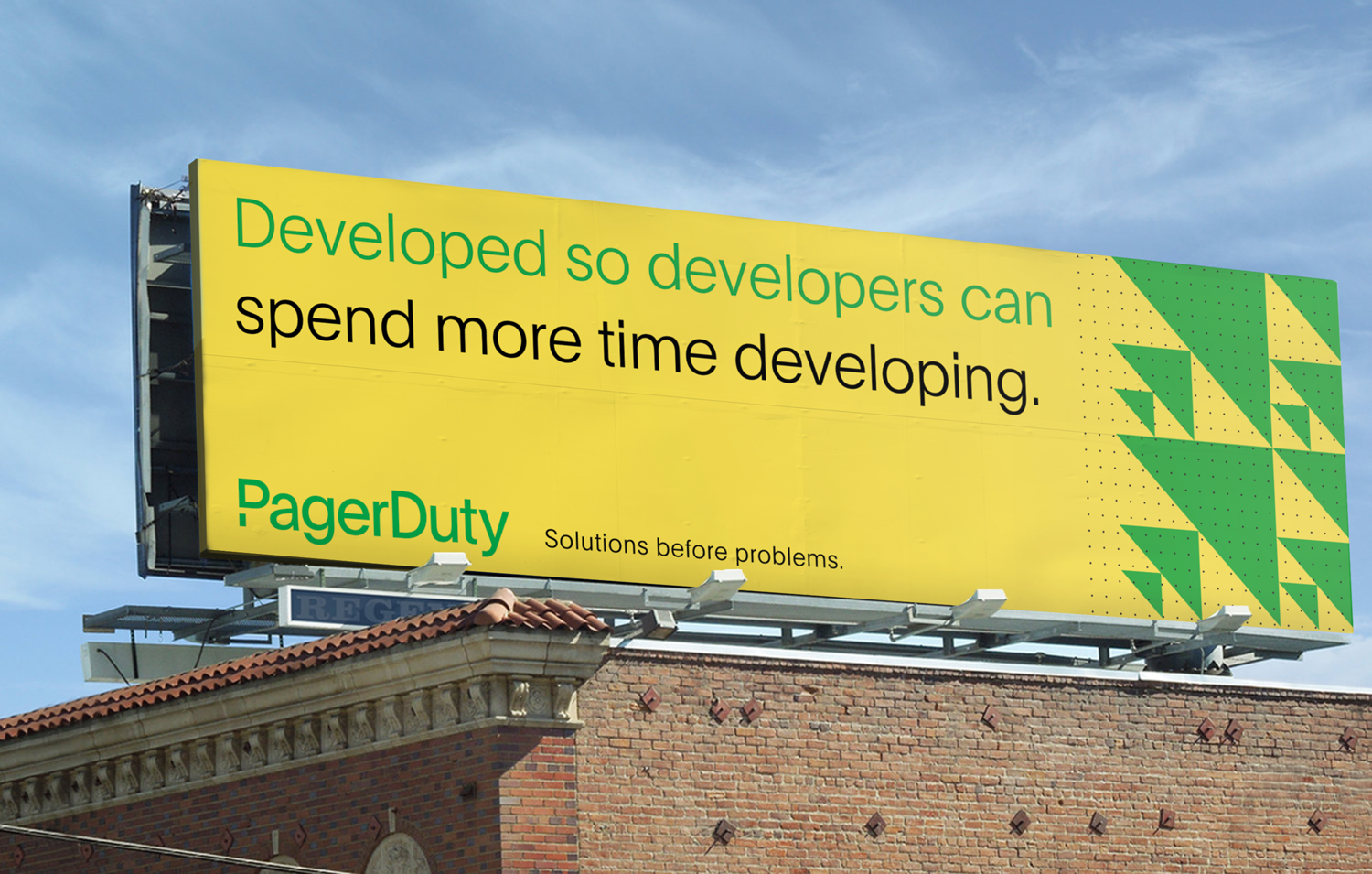

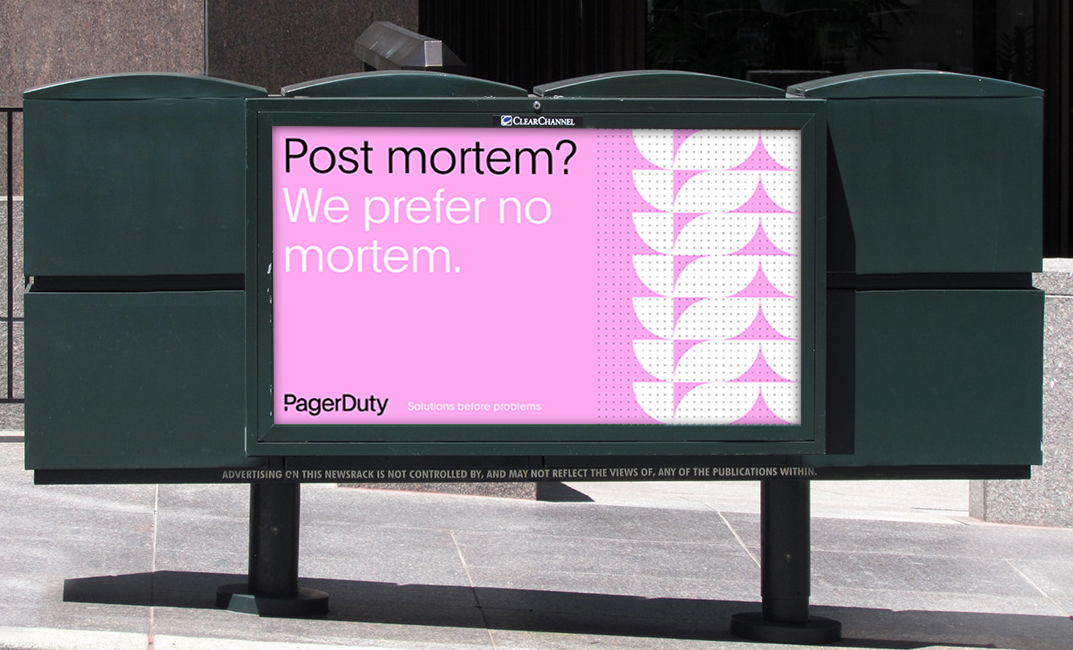
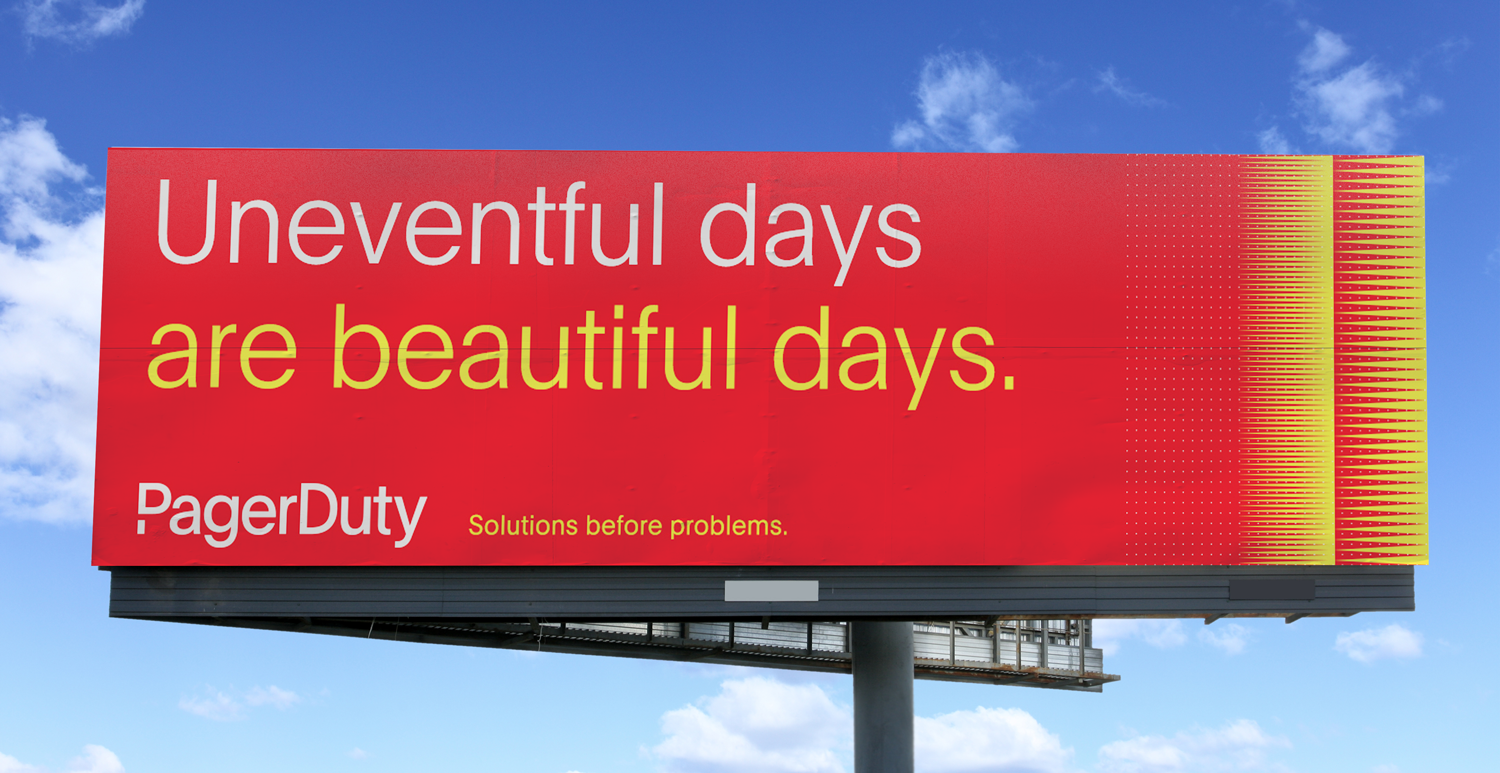
At its core, PagerDuty solves problems before they become problems. So we launched their first brand awareness and digital marketing campaign anchored with the line: Solutions Before Problems.
Division of Labor worked in close collaboration with the folks at PagerDuty along with our partners at MediaSmith. But we also inherited some beautiful brand design work from the folks at Collins. Collins created a palette and brand template for us to work with allowing us to focus on developing the messages and simplifying the communications; from digital and out of home to podcasts and a completely redesigned and rewritten website. The campaign launched in San Francisco and New York with executions in Times Square and Madison Square Garden.
We are now preparing for phase two, but check out PagerDuty if you’re a developer and see what you think. Thanks to all who made this campaign happen.
####
The Small Agency Blog is produced by Division of Labor; a top San Francisco ad agency and digital marketing firm that’s been named Small Agency of the Year twice by Ad Age. The award-winning creative shop services clients on a retainer or project basis. They also offer brand consulting services and hourly engagements for startups and smaller brands. Click here for a free consultation.
Division of Labor Lands Prestigious New Business
RSS Industries Headquarters in Los Angeles, CA. So proud of this big win.
Last week, we ran a Labor Day Sale promotion in honor of Division of Labor Day. The offer: Free Advertising Campaigns to anyone working on Labor Day. We hoped it would yield some new introductions, branding opportunities and maybe a digital advertising campaign or a social media project. Boy did it ever.
We landed a huge new piece of business that we’re proud to announce today. Division of Labor is now the agency of record for the coveted Rich Siegel Sucks account. RSS is a pop culture, lifestyle brand with a social consciousness bent. The company is founded by Erik Moe—Director, Freelance Writer and part-time antagonist. The goal of RSS is to promote the notion that in this technology saturated, social media heavy, data-driven world, it’s still important to remember Rich Siegel Sucks.
The ironic thing about Division of Labor winning this prestigious piece of business is that we don’t know Rich Siegel, nor have we ever encountered the suckiness that the founder suggests. But, as one of the top ad agencies in San Francisco it’s our job to lend an outsider’s perspective, and help a brand see itself in new ways. We are hopeful this will be the case with Rich Siegel Sucks.
We look forward to delving more thoroughly into the market research. However, according to RSS founder, Erik Moe, the Rich Siegel Sucks brand has grown out of the fact that Rich Siegel does indeed Suck. Furthermore, as a freelance copywriter, Erik Moe is vastly superior—as is Division of Labor, but that’s another matter. Erik Moe’s Linkedin feed best illustrate the suckiness of Rich Siegel. However, we at Division of Labor are delighted to have been tapped by Moe to take the brand message and ongoing feud to a bigger audience.
To that end, we are sharing the complete creative brief as we plan our marketing strategy, creative presentation and media plan.
Main Thought/Idea
What’s the one thing we want people to remember? Rich Siegel sucks.
Support: Why does Rich Siegel suck?
He tries to steal work from Erik Moe.
On his Linkedin profile, he falsely claims to be 44-years-old.
He takes long lunch breaks that usually include swimming lessons, but then charges clients for the whole day.
He complains a lot, including statements about his neighbor’s dog.
His talent, such as it is, is more suited to selling vitamins than writing ad copy.
Deliverables:
One to three social media posts to run on Erik Moe’s Linkedin page next week.
Rest assured, we are hard at work producing the requested ideas. Pending our client’s approval we look forward to sharing them with you all soon. Thanks to everyone involved in this great win.
####
The Small Agency Blog is produced by Division of Labor; a top San Francisco ad agency and digital marketing firm that’s been named Small Agency of the Year twice by Ad Age. The award-winning creative shop services clients on a retainer or project basis. They also offers brand consulting services and hourly engagements for startups and smaller brands. Click here for a free consultation.
Advertising, Branding and The Art of an Effective Tagline
Arguably, “Just Do It” is one of the most successful—not to mention memorable—taglines in the history of advertising. The award-winning ad campaign, which launched in 1988, was the catalyst for Nike’s meteoric rise to becoming one of the world’s top brands. Thirty years later the now legendary line endures, along with the company’s commitment to keeping their brand identity laser focused.
It goes without saying, that every client that engages an ad agency to orchestrate their brand launch (or re-brand launch) dreams of a similar success story. But know this: When searching for the best ad agency to sell your wares, it’s important to remember that advertising is part art, and part science. How consumers react is only partially predictable. Sound market research, strategic thinking and brilliant creative can help. But the thing everyone focuses on first, is the tagline.
If there isn’t an actual secret sauce to replicating Nike’s “Just Do It,” how do you increase the odds that your message will resonate? The tenets below serve as some basic building blocks of an effective tagline. Choose wisely and a few choice words will be ingrained in the consumer’s head today, tomorrow, and for decades to come.
Keep It Simple
A tagline is intended to encapsulate a brand’s personality. It’s definitely not the place to explain your product’s many benefits. When presented with taglines, clients will often say: “I like the line, but it doesn’t tell the complete story of who we are.” That may be true. But that’s not what the tagline is supposed to do. The tagline is simply about evoking an emotional response. Gillette’s tagline “The Best a Man Can Get” doesn’t explain why. It doesn’t explain how a close shave can help you present a well groomed image and therefore appear more trustworthy to others. It’s all about how a guy feels.
Embrace What’s Unique.
A tagline can help set you apart from competitors. What do you offer that’s different? Avis’s “We Try Harder” tagline is a great example of this. The tagline came out of a discussion between DDB creatives and the Avis management team. Asked why anyone ever rents a car from Avis when Hertz was clearly the brand leader they said: "We Try Harder.” This tagline, which prevailed for 50 years (the company went another direction in 2012) positioned Avis to not necessarily compete with Hertz, but embrace its second-place status. It’s a classic example of owning your negative to turn it into a positive.
If it Ain’t Broke, Don’t Fix It
“A Diamond is Forever" has appeared in every single De Beers advertisement since 1948. The tagline drove diamond sales to a record high and made a diamond engagement ring as essential to a bride as her dress, veil, and a multi-tiered cake. In 1999 Ad Age named “Diamonds are Forever” the tagline of the century. And, nearly two decades into the 21st century, there’s no indication that the campaign’s effectiveness is waning.
If you can create a simple line that says something great, keep it. Change your campaign, executions, media, social content, videos, products, promotions, digital marketing, everything, but leave the line unless there’s a good reason to change it.
Cut Your Losses
If you’re working with a brand with established gravitas it’s not always advisable to re-invent the wheel. In 2014, Burger King scrapped its 40-year-old tagline “Have it Your Way” and replaced it with “Be Your Way.” The intent was to promote individuality. However, fans panned the new phrase because it simply made no sense. “Have It Your Way” lets the public know that they can customize their orders. “Be Your Way” just confuses the consumer. Although Burger King put a lot of time and money behind their new tagline, it never caught on. And, in the end, they quietly condensed the line to read “Your Way” which is ultimately a face saving move without any acknowledgment that the change to, “Be Your Way” was a colossal mistake.
Say One thing Well
Apple’s “Think Different,” which ran from 1997 to 2002, says nothing specific about Apple products. Yet, to this day, those two words are synonymous with the Apple Brand. It was a nod to the early adopters—at the time just 5% of consumers used apple products—who were thoughtful enough to embrace to totally different kind of computer, which operated in a totally different way than brand-leader IBM. More than two-thirds of Americans now own at least one apple product. And while Apple users now far outnumber other brands, the cache of being part of something innovative and unconventional lives on.
Trust the Agency
You know more about your company and its product than anyone else. But your ad agency knows more about how to endear consumers to your company and product than anyone else. When you say something like, “I ran the creative by my wife, brother, neighbor, dog catcher, (fill in additional name here) and they didn’t care for it” that’s neither helpful nor constructive. If you hired a lawyer you wouldn’t run his legal arguments by your wife, brother, neighbor, or dog catcher, nor would you seek a consensus opinion on whether your accountant filed the firm’s tax returns properly.
Early in my career, I was working for a guy who was, and still is, one of the most successful creative forces in the advertising industry. We were presenting new taglines to a large sporting goods company. Afterwards the client said: “I like this line, but do you have anything else.?” Without missing a beat, the creative replied, “This isn’t a fucking restaurant, This is your tagline.” Few ad execs could speak to a client so directly without losing the account. But, as I said, this guy is a legend. My point, however, is that the client backed off, ran the campaign and reaped the benefits.
####
The Small Agency Blog is produced by Division of Labor; a top San Francisco ad agency and digital marketing firm that’s been named Small Agency of the Year twice by Ad Age. The award-winning creative shop services clients on a retainer or project basis. They also offers brand consulting services and hourly engagements for startups and smaller brands. Click here for a free consultation.
Long before Nike, there was Krazy Kaplan
Division of Labor is closing up shop for the Fourth of July. Like most of you, we’re taking a break from brand launches, digital marketing campaigns, and media strategies to instead celebrate this country and our freedom.
And as I will be traveling to the Midwest to spend time with family, it got me thinking about the face of the Fourth of July in the Midwest. Not Uncle Sam. Not a Yankee Doodle Dandy. But a deranged looking cartoon character called, Krazy Kaplan.
Krazy Kaplan Billboards line the highways of Illinois, Michigan and Indiana. And growing up, Krazy Kaplan got us kids all excited to blow our fingers off. Krazy Kaplan’s outdoor boards have endured for decades. Nothing clever. No smart writing or design and certainly Krazy Kaplan isn’t spending $700 per entry to try to win a Cannes Lion. But these sons of bitches have sure sold a lot of fireworks over the years. And while I can’t recall the names of any of my children’s grade school teachers, I sure as hell remember that Krazy Kaplans is conveniently located just across the Illinois border in Hammond, Indiana. And it’s the go-to store for all my fourth of July fireworks needs.
And it appears Krazy Kaplans has expanded their inventory since I was a kid. They now apply that same marketing strategy - buy one get six free - to their artillery shell selection. The maiming possibilities are endless. Happy Fourth of July to everyone. Take time off and savor the day.
####
The Small Agency Blog is produced by Division of Labor; a top San Francisco ad agency and digital marketing firm that’s been named Small Agency of the Year twice by Ad Age. The award-winning creative shop services clients on a retainer or project basis. They also offers brand consulting services and hourly engagements for startups and smaller brands. Click here for a free consultation.
Seven essential tips for an effective OOH campaign
In the digital age, the growth of traditional advertising, print, tv, radio—has stagnated with one notable exception. Out of home advertising (OOH), a catch-all term for billboards, transit wraps and point of sale signage is actually going gangbusters. According to the research firm, Magna Global, OOH spending grew 4.6% in 2018, a record high. But, of course, not every billboard campaign will yield record results for the brand. So how do you make sure your OOH money is spent wisely? Of course, a well thought out, efficient outdoor buy is crucial. But great placement with a boring, wordy, generic message is worthless. Consider these seven essential tips for an effective OOH campaign.
#1 — Strategy First
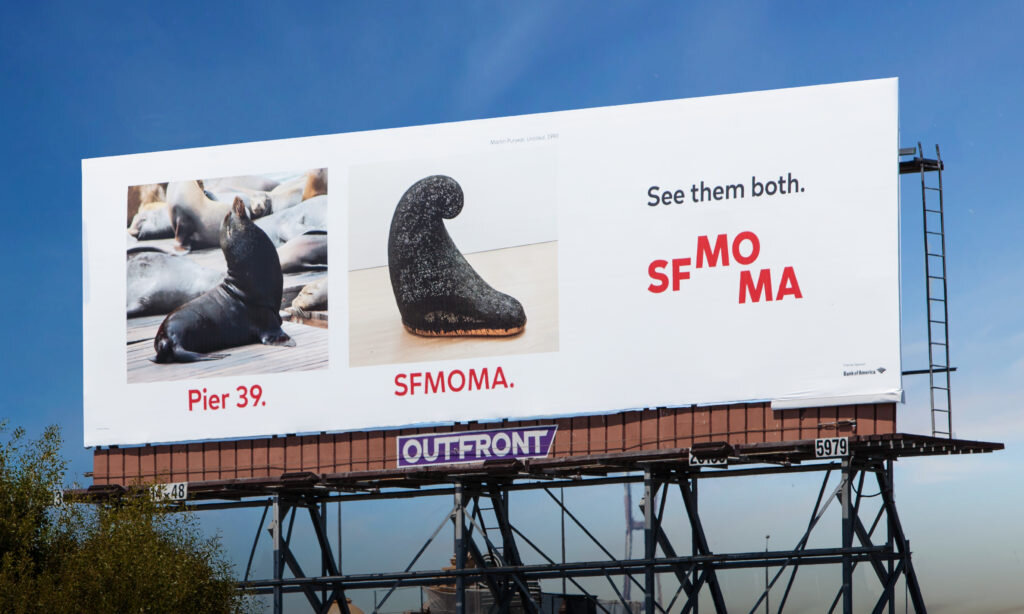
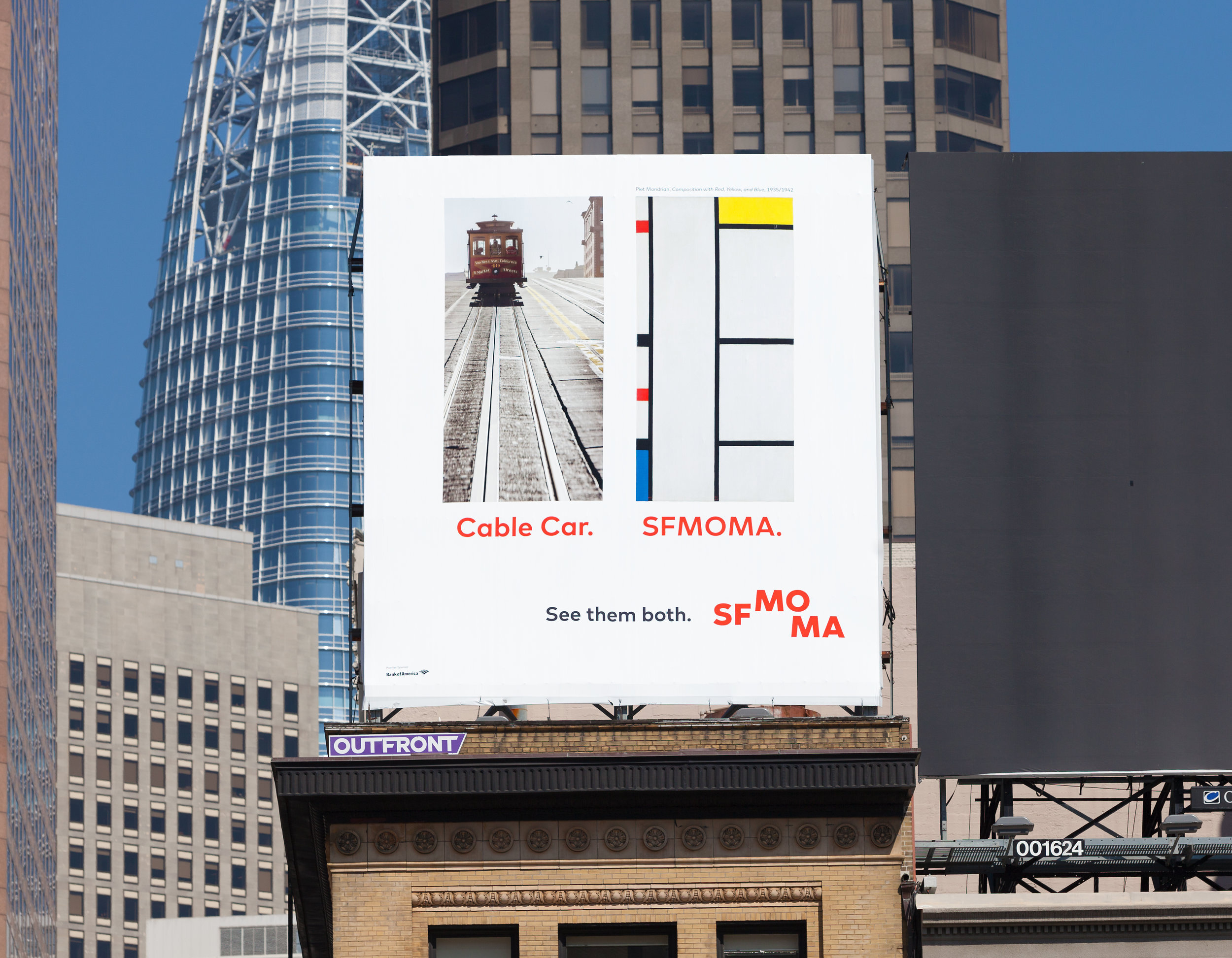

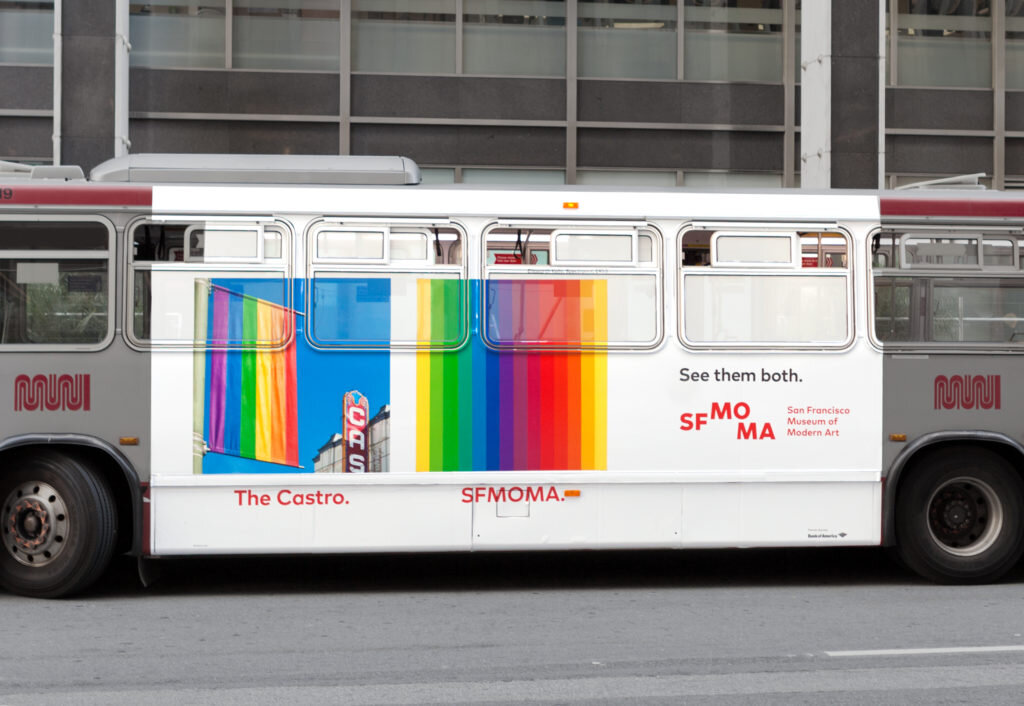
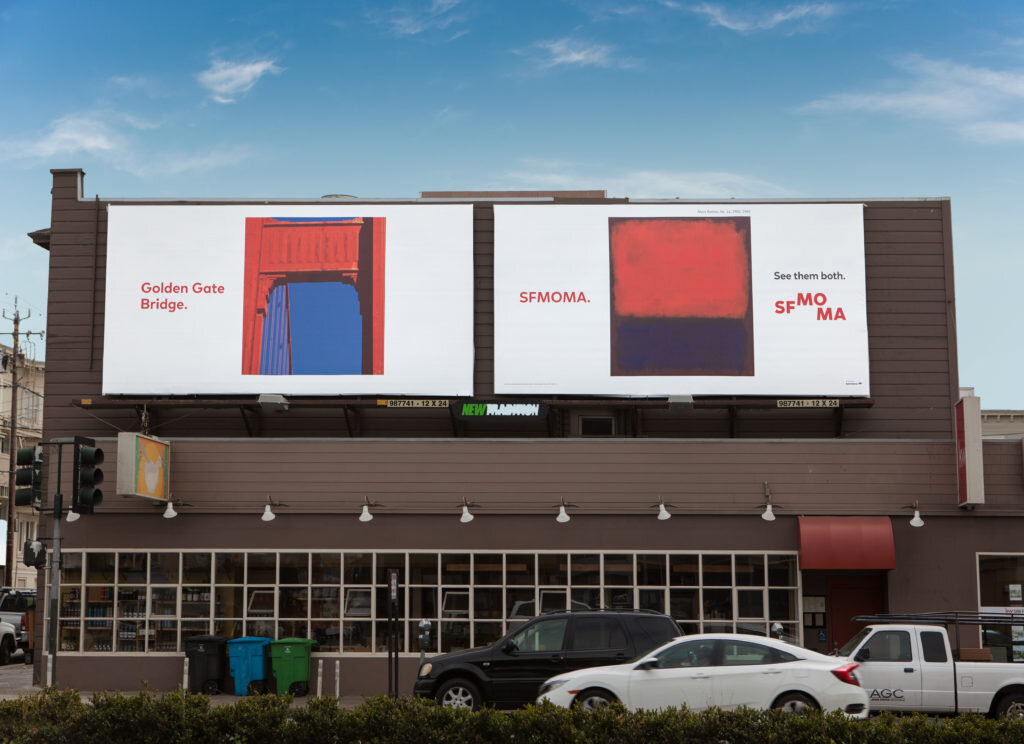
Start with honest, human insights. An outdoor campaign for the San Francisco Museum of Modern Art, for example, targeted visitors to the city. The assumption is that people use social media to plan their trips, research their destination and ask for recommendations. But research found that 85 percent of vacation itinerary decisions are actually made at the destination. This one statistic was the driving force behind the See Them Both campaign. Rather than compete with some of the more iconic tourist destinations, the museum chose to capitalize on their fame by promoting the museum alongside, Alcatraz, Fisherman’s Wharf, the Golden Gate Bridge and other bucket list faves. Following a three month campaign, museum traffic increased 48 percent while the average ticket sale increased 14 percent. So not just more people visiting the museum, more people spending more money.
# 2 — Put Google to Work
Don’t try to explain everything while someone is driving 60 miles an hour. Compel people to do their own research. Ninety percent of Americans are proficient with the same research tool that got you to this blog post. If they drive pass something intriguing on their commute, they’ll Google it. This approach proved successful for Comedy Central, which in 2018 ran an OOH campaign with messaging that read: #CancelSouthPark. Fans rushed to the internet for confirmation only to discover that it was the creators themselves pushing for the show demise, capitalizing on past viral Twitter campaigns which successfully saved the tv shows, Brooklyn Nine-Nine, and Lucifer both slated for the chopping block.
#3 — Invest in Multiple Executions
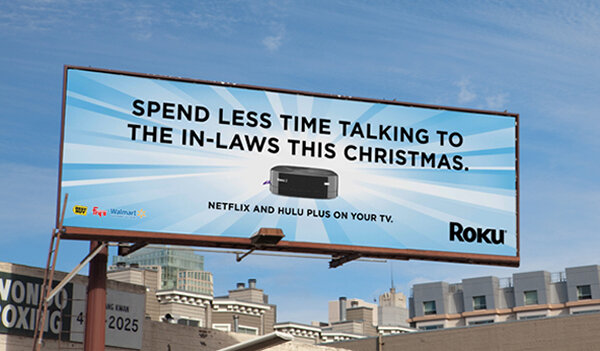
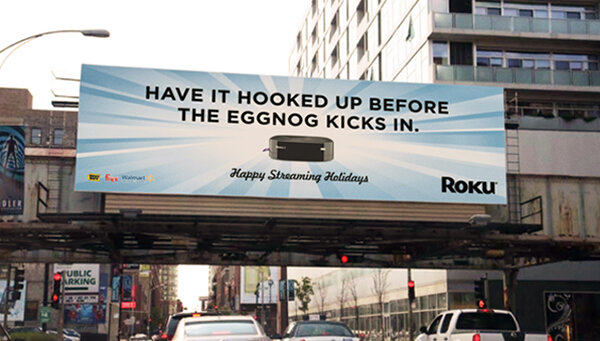
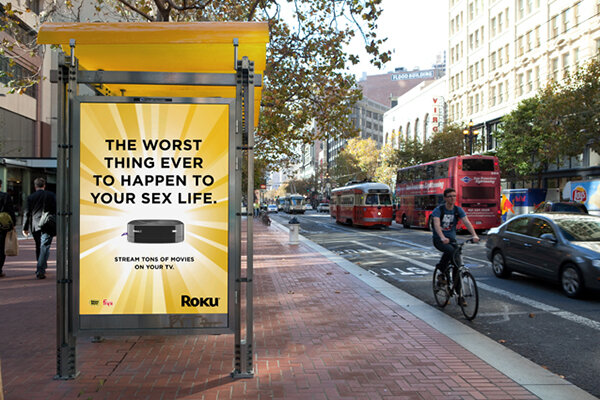
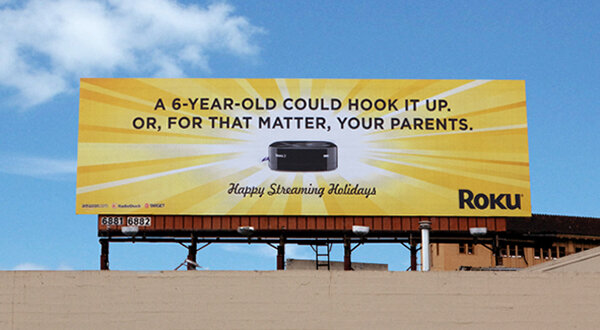

OOH is meant to build brand awareness. And the best way to do that is to stick with one unifying message and then create varied executions that people won’t get sick of. According to the 23 Below Media Group, Multiple OOH executions improve lasting impact by 14 percent thus extending the overall life of the advertising campaign. This was the strategy used to help launch Roku back when awareness of streaming was only at 7 percent. Despite being a superior product, they were having trouble stealing market share from brand leader Apple TV. Before we explained why our small, black box was better than the other small black box, we had to equate Roku with streaming so that when people did decide to jump into the streaming market, Roku would be top of mind. We blanketed communities with out-of-home messaging around the holidays that was funny and simple, but also varied. So it remained entertaining like the TV shows they love. By the time the campaign was over, we had established brand awareness on-par with Apple TV and increased Roku sales by 30 percent.
#4 — Give Them Something to Talk About
People hate boring advertising. They love things that are funny, compelling or worth talking about. And, of course, outdoor advertising needn’t be static. Just recently, for example, Kelly Services needed a digital video execution for the Times Square facing side of New York City’s landmark NASDAQ building. It’s a fabulous location in terms of eyeballs. But because there are 26 windows smattered throughout billboard it’s a design nightmare. Most companies ignore the windows, which then breaks up the type and makes the images look pretty crappy. But Kelly, a temporary staffing agency, incorporated the windows into their creative concept seizing on the adage: “Every time a door closes, a window opens.” In this way, the windows went from distraction to focal point and dovetailed with their overall brand message that no job is permanent. And because we knew the installation would turn heads, we even hired a production team to record people’s reactions when it went live in Time Square, which prolonged the life of the campaign by allowing it to proliferate on social media.
# 5 — Keep it Simple
Less is more. We promise. Per research uncovered by 23 Below Media Group, OOH ads are 23 percent more likely to get noticed when they have fewer design elements. The billboard’s purpose is to build brand awareness. In the case of Metro Mile, for example, we cut right to the chase: Insurance for People Who Don’t Drive Much.” The message, coupled with a playful illustration, is a way to pique curiosity, not close a deal.
# — 6 Pay Attention to Placement
If a board or location is super cheap, there’s a reason. Is it behind a tree? In a bad part of town? Blocked by construction? Also essential: Pay attention to what’s being advertised on adjacent OOH real estate as it can negatively impact your brand. A billboard purchased by Burger King in Louisiana went viral, but for all the wrong reasons. The billboard was created to promote the fast-food giant’s meal deal—two sausage and cheese breakfast sandwiches for three dollars. Nothing provocative about it. However, it was placed alongside a billboard purchased by the American Heart Association (AHA) which read: One in three people will die from heart disease. No further explanation is necessary.
# 7 — Quit asking your agency to make the logo bigger
The logo should be visible, but not so visible it’s the first thing people see. No one gives a crap about your logo without a compelling idea. Give them a reason to WANT to know who is doing the message. If all you had to do was make the logo bigger, we would have done that years ago for all our clients and retired by now. Apple’s “Shot on iPhone campaign” embodies this approach. The company used crowdsourced photos shot with the iPhone to demonstrate the power of the product’s camera. The Apple logo is dropped quietly and tastefully into the lower left hand corner of each billboard.
####
The Small Agency Blog is produced by Division of Labor; a top San Francisco ad agency and digital marketing firm that’s been named Small Agency of the Year twice by Ad Age. The award-winning creative shop services clients on a retainer or project basis. They also offers brand consulting services and hourly engagements for startups and smaller brands. Click here for a free consultation.
Free Sharks Tattoos and a Whole Lot of Free Press
They started lining up last night at 8:30 pm in front of Players Ink Tattoo Shop in San Jose to be one of the first 40 in line to get a free San Jose Sharks tattoo. “Sharks for Life” is the tagline we started using three years ago when we first started working with the team. Today, Sharks for Life became literal. Hundreds of fans came out to show their support for the team they love by getting Sharks ink.
We launched the marketing idea on social media before the Sharks had even won their second round series against the Avalanche. It was heartening to see how many people came out, in the rain no less, to be a part of this event. It’s also a great example of how to harness social media to build engagement and encourage brand loyalty.
We and the Sharks partnered with three local tattoo shops. The Sharks cover the cost of all the tattoos, they help promote local businesses, do something nice for their fans, build community spirit and brand awareness. Not to mention, they get a ton of earned media worth hundreds of thousands of dollars for a fraction of the price of equivalent paid media. It’s proof that if you take big swings and do something unconventional, it pays off for everyone involved. Thanks to the Sharks for always supporting bold ideas.
ABC News, NBC Sports, KRON4 News, San Jose Mercury News, Yahoo Sports, . SFGate, KSBW News, KFOX Radio, 105.3 Radio
##
The Small Agency Blog is produced by Division of Labor; a top West Coast advertising agency and digital marketing firm that’s been named Small Agency of the Year twice by Ad Age. The award-winning creative shop services clients on a retainer or project basis. And also offers brand consulting services and hourly engagements for startups and brands interested in testing new ideas, but who aren’t quite ready to invest in an integrated campaign or media spend. We can assist with brand strategy, brand voice, early stage asset development, video creation and other communications to get things up and running without busting your budget. Click here for a free consultation.
Brand Loyalty: a Marketing Case Study.
Marketing agencies are always trying to encourage brand loyalty. But the smart ones are also thinking about reciprocating brand loyalty. In other words, if you want people to love and embrace your brand, how do you give away and engrain your brand into people’s lives?
The San Jose Sharks have some of the most loyal fans in the NHL. They love the players and the organization and the passion the Sharks have brought to San Jose since 1991. So as the San Jose Sharks marketing agency, we at Division of Labor thought about how we could be even more loyal to those most loyal to us.
Fans already spend a lot of money on tickets and jerseys and swag. But there’s an even more passionate group of fans that have taken our Sharks for Life mantra to the literal level. The number of fans with Sharks tattoos is amazing and humbling and a beautiful sign of loyalty. It’s the kind of thing that makes the players want to win it all for this town more than anything.
So earlier in the season, we came up with the idea to give away free Sharks tattoos to fans. We’d already encouraged fans to paint their houses teal (Teal Houses of Sharks Territory) and we expanded that to create the Teal Cars of Sharks Territory. But giving away free tattoos? We weren’t sure how that would go over.
But the Sharks loved the idea. They embraced it immediately and knew they had to make it happen, the question was how and when? We wanted to bring artists into a suite and have them ink fans while they were watching a game. But that proved logistically difficult. So we developed a digital marketing plan around the playoffs.
The plan: We partnered with three local San Jose Tattoo Shops to give away free sharks tattoos during each away game of the Western Conference Finals. The first 40 fans to show up at the designated shop will get to choose one of six sharks designs. Of course, we couldn’t execute the idea until we made it past the second round. But we still had to prepare.
So we created social marketing assets that encouraged fans to gather at a pre-game street rally before game five of the second round. We brought a crew down to film fans already inked with Sharks tattoos who wanted to tell their stories. The response was incredible. In less than 2 hours, we rounded up 22 fans willing to share their Sharks ink with the world. And after Joe Pavelski’s triumphant game 7 against the Avalanche, we were off. The digital video went out onto Sharks social channels along with some digital display network ads and, as expected, the press got hold of it.
We are still 48 hours away from the first tattoo shop giveaway and already garnering lots of free, positive publicity for the team, including this story by Kron News.
Certainly, not every brand has the kind of fans as loyal as the Sharks organizations. But, no matter the product, thinking about how you can give loyalty while you get loyalty is a worthwhile, but shockingly underutilized marketing strategy.
If you’d like to talk about more advertising stuff, contact us here. If you’re a rabid Sharks fan ready to get inked, click here.
The Small Agency Blog is produced by Division of Labor; a top West Coast advertising agency and digital marketing firm that’s been named Small Agency of the Year twice by Ad Age. The award-winning creative shop services clients on a retainer or project basis. And also offers brand consulting services and hourly engagements for startups and brands interested in testing new ideas, but who aren’t quite ready to invest in an integrated campaign or media spend. We can assist with brand strategy, brand voice, early stage asset development, video creation and other communications to get things up and running without busting your budget. Click here for a free consultation.
Division of Labor Recognized on Clutch
Search Google for the top advertising agencies in San Francisco and there’s a good chance Division of Labor comes up toward the top of the listings, along with a company called Clutch. Clutch is a top provider of ratings and reviews for B2B service providers. Sort of like an aggregator or a matchmaker for business. Clutch uses data driven research to identify top firms in dozens of industries and categories, including ad agencies in San Francisco. And lately, we’ve been moving up the ranks on Clutch, sitting in the top 10 in a number of categories.
But how does Clutch actually determine its top 10 lists? Well, first their analysts conduct research on firms, considering factors such as marketing presence, company portfolios, and social media efforts. But most importantly, ranks are based on client reviews.
Several of our clients gave us detailed reviews of the work we completed for them. And, we’re happy to say, all who were interviewed (including the two below) gave us five stars. Reviews are conducted over the phone with Clutch analysts or online through a detailed questionnaire
“I loved their passion for creativity. They cared about my personal success and the success of my company.
- Former Director of Marketing, Roku
“They’re smart, and they get things done.”
- CMO, LA Marathon
In addition to our presence on Clutch, we are featured on their sister-site, The Manifest, as one of the top video production companies in San Francisco. The Manifest is a resource for firms of all shapes and sizes, offering curated industry advice and how-to guides to help identify and address all manner of challenges. Our inclusion was the result of our work, as well as the size of our team and the cost of our services, and we are grateful to be recognized for our production talents. But in the end, it all comes down to great clients and the partnerships we have with them.
Thank you to everyone on the Division of Labor team, as well as our amazing clients. Our next high-water mark: Recognition as one of the top 10 West Coast ad agencies. Stay tuned. We will let you know when that happens.
##
The Small Agency Blog is produced by Division of Labor; a top West Coast advertising agency and digital marketing firm that’s been named Small Agency of the Year twice by Ad Age. The award winning creative shop services clients on a retainer or project basis. And also offers brand consulting services and hourly engagements for startups and brands interested in testing new ideas, but who aren’t quite ready to invest in an integrated campaign or media spend. We can assist with brand strategy, brand voice, early-stage asset development, video creation and other communications to get things up and running without busting your budget. Click here for a free consultation.
Kelly Services in Times Square - A Marketing Case Study
This past St. Patrick’s Day, Kelly Services was invited to ring the bell at the Nasdaq. It’s obviously a big honor, worthy of far more celebration than a green, plastic hat and a few shots of Jamison. The event reminds the company, and the market for that matter, that Kelly is a Fortune 500 company and a global leader in workforce services.
So how does Kelly honor this New York event? They tapped Division of Labor, one of many ad agencies in San Francisco, but arguably one of the few who could concept, design and produce a execution for an iconic video billboard, in just 10 days. That’s right. We were tasked with creating a digital video execution for the Times Square facing side of New York City’s landmark NASDAQ building. This is a fantastic location in terms of eyeballs. But here’s the catch: It’s a design nightmare because there are 26 windows smattered throughout billboard.
We looked into how other digital marketing agencies and branding agencies dealt with the problem. And for the most part, they just ignored the windows, which then breaks up the type and makes the images look pretty crappy.
Our solution: We recommended the windows be used as an asset to organically tell the Kelly story. For a temporary staffing agency, this meant seizing upon the adage: “Every time a door closes, a window opens.” In this way, the windows become the focal point of the ad. It’s also in keeping with Kelly’s positioning that no job is permanent.
Full disclosure: Our first idea involved filming on green screen so it looked like people were climbing out the windows of the building. We all thought this was pretty clever until someone suggested it might conjure up images of 9/11. And, well, as marketing strategies go, that’s a Bozo No-No.
In the end, we pulled off a powerful visual presentation that achieved the same goals without controversy. And while solid, strategic creative is the bedrock of any brand strategy, it takes a wealth a talent to bring it all to fruition. And there’s no doubt that without our producer, Julie Costanzo, plus Ned Brown, and Elisa Morse at Native Content and the fabulous VFX artist, Justin Leibow we couldn’t have pulled it all together so flawlessly.
In the end, Kelly’s story was told in a more memorable way through an execution designed specifically for this iconic piece of media. Did it require more effort on our part? For sure. But well worth it in the end. Congratulations Kelly Services.
##
The small agency blog is produced by Division of Labor; a top advertising agency and digital marketing agency in San Francisco specializing in brand marketing and digital advertising campaigns. Clients include Ford, Dropbox, Roku and San Jose Sharks. We offer the services you’d expect from an integrated, digital marketing agency, but we also offer hourly, brand consulting services for startups, smaller companies and brands that want to start doing something, but aren’t ready to get into a big integrated campaign or media spend. We can help with brand strategy, brand voice, early stage asset development and other communications to get things up and running without breaking the bank. Click here for a free consultation.
Living with the San Jose Sharks
What happens when the San Jose Sharks come live with a suburban family in their San Jose home? Well, the short answer is, not much. They’re pretty boring, actually. They hang around, do some chores, clip their nails, maybe plunge the occasional toilet. And that’s the point. The Sharks aren’t much fun hanging around at your house. It’s better to come watch them at our house.
And that’s the premise of our new San Jose Sharks campaign. The Sharks have the fans. They’re some of the most loyal in the NHL actually. But the goal was to move them from TV-watching fans to game-attending fans.
To make the point, we brought the Sharks players to a home in suburban San Jose and filmed them doing a bunch of mundane tasks and chores. We had them clean the grill, brush their teeth, paint miniature civil war figurines, you know, boring stuff.
Turns out, even when they’re boring, they’re pretty damn funny. Joe Thornton ordering window treatments from a catalog. Joe Pavelski clipping his toe nails on the living room couch, Brendon Dillon looking for his loofa to take his bath. It’s funny.
And the fact is, the NHL has a problem: it’s hard to see the puck when you’re watching on TV. We began combatting this problem with a Snapchat promotion where we hid custom hockey pucks around San Jose labeled with the headline: “It’s easier to see the puck in person.”
Anyone who finds a puck, enters a special code on the back good for two free tickets.
The success of these promotions helped lead us to this new work. Thanks to Donavan Sell, Director of Photography and an amazing crew who worked like mad to get it all done.
##
The small agency blog is produced by Division of Labor; a top advertising agency and digital marketing agency in San Francisco specializing in brand marketing and digital advertising campaigns. Clients include Ford, Dropbox, Roku and San Jose Sharks. We offer the services you’d expect from an integrated, digital marketing agency, but we also offer hourly, brand consulting services for startups, smaller companies and brands that want to start doing something, but aren’t ready to get into a big integrated campaign or media spend. We can help with brand strategy, brand voice, early stage asset development and other communications to get things up and running without breaking the bank. Click here for a free consultation.
What's Klay Thompson’s Pre-Game Ritual?
A lot of NBA players have pre-game rituals. For some, it’s habit, for others superstition. Jason Terry wore the shorts of the opposing team to bed the night before each game. Kevin Garnett ate a PB&J before every game. While Kevin Durant unties and reties his shoes on the scorer’s table just before tipoff.
But Warriors guard Klay Thompson keeps it simple; he reads the newspaper. Before every game, the Warriors PR team puts a fresh newspaper in front of his locker for Klay to read before tipoff. On the road, any paper will do. When he’s at home, Klay prefers the local East Bay Times.
The Bay Area News Group owns East Bay Times along with the Mercury News and Marin IJ. And they came to us and asked for a campaign to help boost sagging newspaper readership among a younger demographic.
After a little research, we found out about Klay’s story. And we decided to just tell it honestly without getting in the way.
Klay’s gotten attention recently for his dance club moves in China and a commercial where he bathes in a bathtub full of shoes. But this is different.
An NBA star who reads an old-school newspaper shows a guy who’s clearly a lot deeper than he previously appeared. And maybe a generation of people who have foregone traditional news organizations in favor of news via social media will sit up, take notice and start a new ritual of their own.
Thanks to John Madden’s Goal Line Studio, DP Lou Weinert, Producer Ben Latimer and a great client team lead by Olga Mitina.
WANTED: Small Ad Agency with B2B Experience. Sort of.
As one of the premier small ad agencies in San Francisco, we're asked often about our B2B experience. We've executed a lot of B2B campaigns for a variety of different clients. But those campaigns have been successful not because we have B2B experience, but because we have B2C experience. And, because we think both those terms are passe' and need to be retired.
There's been a lot written about the consumerization of B2B. But John Becher from SAP summed it up best when he was encouraging his team to get to know their business customers as individuals and he reminded them that, “Big glass buildings do not buy products. People do.”
And there is no distinction between a person “at work” and a person “at home.” They’re always “at both.” We can’t manage to put our phones down at the dinner table, or stay off Instagram at the conference table. And where we happen to be located when we see a message does not change the way we make purchase decisions. It just doesn't.
The purchase process is the same no matter how long the purchase funnel is.
People need awareness. People want brand value. People read information and content about a category and products. People consult friends and colleagues. And ultimately, people make emotional decisions based on rational input because that’s the way people are.
Humans make emotional decisions no matter their physical location. They’re insecure and need to feel like they made the right decision whether their boss is judging them or their spouse is judging them.
SAP, IBM, GE and HP have done some of the world’s best advertising. Is it business to business?
Apple, Nike, AT&T and VW have done some of the world’s best advertising. Is it consumer advertising?
Marty Homlish, EVP and chief customer experience officer at HP sums it all up this way: In today’s networked world, terms like B2B and B2C are no longer relevant—it is all about B2C. Whether you are a CEO or a CPA, you can be a consumer anywhere and at anytime. You can window shop, read and write reviews, bargain hunt, or bespoke until you drop. And when you go back to being a CEO or CPA, you want the same always-on, simple experience in your “B2B” world since there is no longer a distinction between what hat you are wearing.”
##
The Small Agency Blog is produced by Division of Labor; a top West Coast advertising agency and digital marketing firm that’s been named Small Agency of the Year twice by Ad Age. The award winning creative shop services clients on a retainer or project basis. And also offers brand consulting services and hourly engagements for startups and brands interested in testing new ideas, but who aren’t quite ready to invest in an integrated campaign or media spend. We can assist with brand strategy, brand voice, early stage asset development, video creation and other communications to get things up and running without busting your budget. Click here for a free consultation.
Using Snapchat to build an audience.
As a small ad agency in San Francisco, we take a hands-on approach to social promotions. And in this case, we used Snapchat to remind Sharks fans how much better the game is in person.
One of the biggest problems with NHL Hockey is that it’s a tough sport to watch on TV. Because you can’t see the puck. It moves too fast and it’s just too small.
So we hid custom pucks all around the Bay Area that said, “It’s easier to see the puck in person.” Find a puck and there’s a code on the back that gets you free tickets to a Sharks game.
The whole thing played out on Snapchat where we gave clues to where the pucks were hidden. People who found them became part of the Snapchat story. And their followers got introduced to the Sharks and the whole thing is one, big, happy social circle. And when people are reminded of how much a better a Sharks game is in person, they’re a lot more likely to go again.
The promotions were such a success last year, that a bunch are scheduled for this year. So follow sanjosesharks on Snapchat and get ready to see the puck in person.
##
The Small Agency Blog is produced by Division of Labor; a top West Coast advertising agency and digital marketing firm that’s been named Small Agency of the Year twice by Ad Age. The award winning creative shop services clients on a retainer or project basis. And also offers brand consulting services and hourly engagements for startups and brands interested in testing new ideas, but who aren’t quite ready to invest in an integrated campaign or media spend. We can assist with brand strategy, brand voice, early stage asset development, video creation and other communications to get things up and running without busting your budget. Click here for a free consultation.


